NHK WORLD > NHK WORLD TV > BENTO The Global Lunchbox Project
-
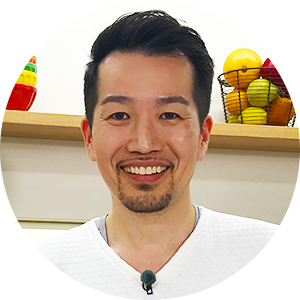
- Marc Matsumoto
-
Marc Matsumoto is a private chef, culinary consultant and TV presenter with a base of clients around the world. Born in Japan, and raised between the US and Australia, Marc developed an early love for travel and a broad palette of global flavors. He believes that by making wholesome delicious food accessible to people of all backgrounds, the world becomes a better place.
-

- Maki Ogawa
-
Maki Ogawa's books have been translated into three languages and are sold around the world. Yum Yum Bento Box is credited with starting the recent bento boom. She also loves to post pictures and recipes on social networks like Facebook and Instagram and she's been featured by news outlets from around the world. Many of her bento ideas come about when she's cooking for her two sons. Fans love her delicious, easy-to-make, kawaii bento ideas!
-
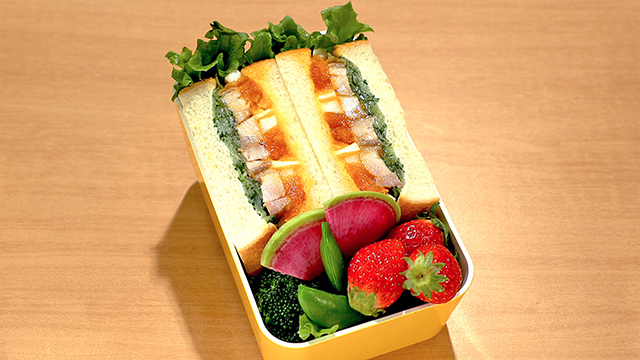
- BENTO RECIPES
- from Episode 20 / Season 6.
- Teri-tama Sandwich Bento
- (762 kcal)
-
 by Marc Matsumoto
by Marc Matsumoto
Bento contents:
Makes enough to pack into 2 bentos
- Teri-tama Sandwich
- Leaf lettuce
- Boiled broccoli
- Boiled snap peas
- Sliced watermelon radish
- Very small strawberries
Ingredients:
For Teri-tama Sandwich
- 250 g chicken thigh
- 2 tsp potato starch
- 3 tbsp 3S sauce
- 1 tbsp each of sugar, sake, and soy sauce
- 180 g cucumber, 2 Japanese cucumbers
- 1/4 tsp salt
- 2 hard-boiled eggs
- 4 slices sandwich bread
- Mayonnaise (preferably Japanese)
Directions:
1. Trim any excess fat or gristle off the chicken, then dust the chicken with a thin, even coating of potato starch.
2. Place the chicken skin-side down in a cold frying pan and turn the heat onto medium-low.
3. Cook this slowly to allow the fat to render out from the skin. Once it's browned and crisp on the skin side, flip it over and cook the other side.
4. When the chicken is mostly cooked through, use paper towels to wipe out as much of the rendered fat from the pan as possible.
5. Add the 3S sauce and flip the chicken repeatedly until the sauce has formed a thick glaze. Transfer the chicken and any remaining sauce in the pan to a plate and let the chicken cool completely.
6. While you wait for the chicken to cool, prepare the cucumbers by slicing them very thinly. Toss the cucumbers together with the salt and let the mixture rest for at least 10 minutes.
7. Peel the boiled eggs and then cut each egg into 6 even slices.
8. Finish preparing the cucumbers by massaging them with your hand until they are soft and translucent. Next, use your hands to squeeze out as much liquid from the cucumbers as you can and set them aside.
9. Once the chicken has fully cooled, use a sharp knife to cut it into slices.
10. To assemble the sandwiches, spread a layer of mayonnaise on one side of each slice of bread.
11. Divide the squeezed cucumbers between two slices of bread.
12. Divide the chicken and spread it on top of the cucumber.
13. Top the chicken with slices of egg, lining up the pieces with yolk along the center, where you will cut the sandwich in half. Top with the remaining slices of bread and give the sandwiches a gentle press to shape the bread around the fillings.
-
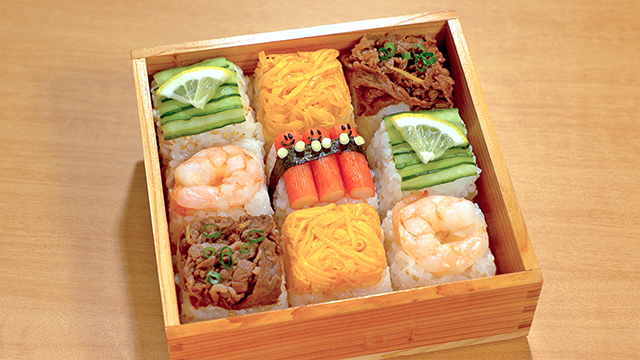
- BENTO RECIPES
- from Episode 20 / Season 6.
- Mosaic Sushi Bento
- (823 kcal)
-
 by Maki Ogawa
by Maki Ogawa
Ingredients:
For Mosaic Sushi
- Shrimp toppings
- 4 frozen shrimp
- 1 tbsp sake
- A pinch of salt
- Egg toppings
- 1 egg
- A pinch of sugar
- Vegetable oil
- Beef toppings
- 80 g beef thinly sliced
- Ginger (cut into shreds)
- 1/2 tbsp sugar
- 1/2 tbsp sake
- 1/2 tbsp soy sauce (for simmering)
- 1/4 cucumber
- 2 crab sticks
- Sushi rice
- 2 rice cups rice
- 2 tbsp sushi vinegar
- 2 tbsp white sesame seeds
- For decoration
- Black sesame seeds
- Nori
- Sliced cheese
- Lemon
- Scallions
Directions:
1. Make the beef toppings. Combine all ingredients except for the beef in a pot and bring to a boil. Reduce the heat to low and add the beef to cook through.
2. Make the egg toppings. Beat the egg with a pinch of sugar. Pour into a pan and cook at low heat. Allow to cool and cut into shreds.
3. Make the shrimp toppings. Thaw the frozen shrimp in running water and pat dry. Place in a sealable food container and coat with 1 tbsp of sake and a pinch of salt. Microwave (600 W) for 30 seconds. Turn over and microwave for 20 more seconds. Open the container and allow to cool. Cut lengthwise in half.
4. Make the crab stick toppings. Cut the crab sticks so that they fit into the ice tray.
5. Use a vegetable peeler to cut the cucumber into thin slices. Sprinkle with a pinch of salt and set aside for 2-3 minutes to draw out the excess water. Pat dry with paper towels and cut to the length of the individual ice tray compartments. You’ll need 5-6 slices.
6. Sprinkle the cooked rice with sushi vinegar and sesame seeds, mix using a cutting motion, and cool.
7. Moisten the ice tray and fill with the prepared toppings. Add approx. 35 g of sushi rice to each compartment and pack with a spoon. Shake the ice tray and flip over to remove the sushi.
8. Cut a strip of nori to wrap the crab sticks like a band.
9. Pack into the bento box. Decorate the crab stick sushi with black sesame seeds for the eyes, cheese for the hands, and nori for the mouth. Top the cucumber sushi with a quarter slice of lemon, and the beef sushi with chopped scallions.
-
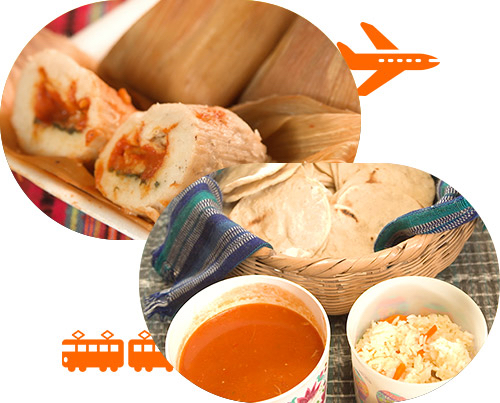
- BENTO TOPICS
- from Episode 20 / Season 6.
- Guatemala
-
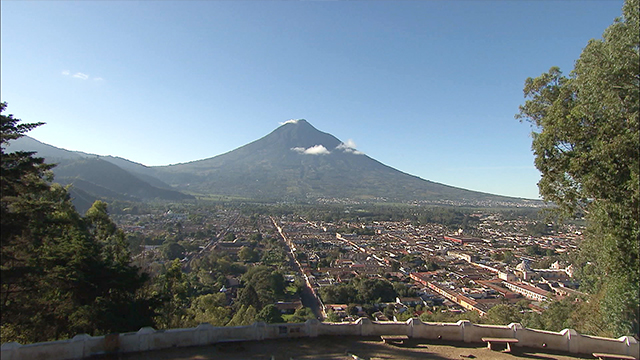
Bento Topics. Today, from Guatemala in Central America. The ancient Mayan capital of Antigua, a World Heritage Site, is located in the highlands. For centuries, maize has been a key ingredient in food here.
-
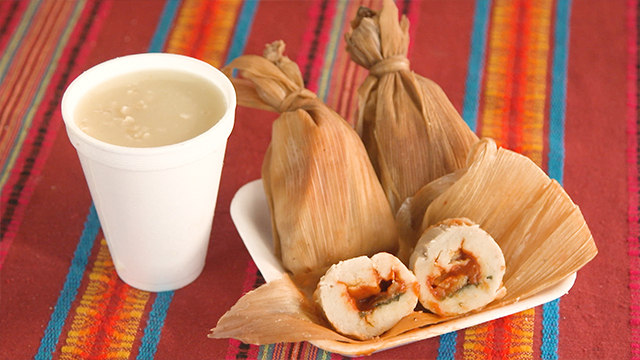
Chuchitos are a a traditional Guatemalan dish in which a dough made with maize is stuffed with meat and tomato sauce, wrapped in maize husks, and steamed. It's typically eaten with a creamy soup-like beverage also made with maize.
-
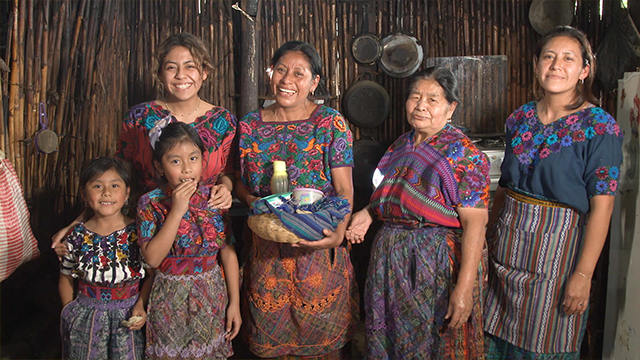
Bento maker Irla loves making bentos for her husband. Today, she and her family are making tortillas, a thin bread made with dried maize. Tortillas are a staple food in Guatemala!
-
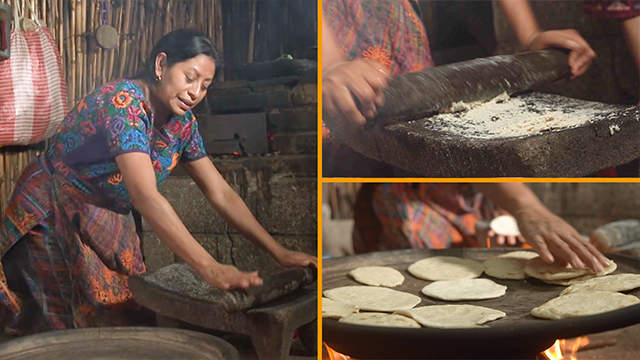
After reconstituting the dried maize in a special hot water, she grinds it into a paste, using a mortar that's been in her family for three generations. The dough is then flattened into rounds and cooked on a clay griddle.
-
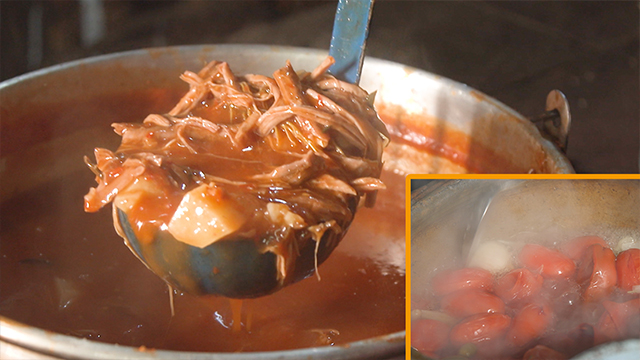
To go with the tortillas, she's making a tangy stew of shredded beef, potatoes, tomatillos, and chiles guaques. This traditional Guatemalan dish is one of her husband's favorites.
-
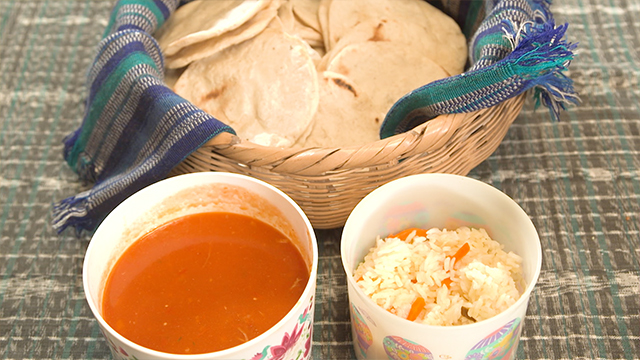
In addition to the beef stew and tortillas, she packs a pilaf full of vegetables. It's a hearty Guatemalan bento, perfect for her husband who works as a carpenter.
-
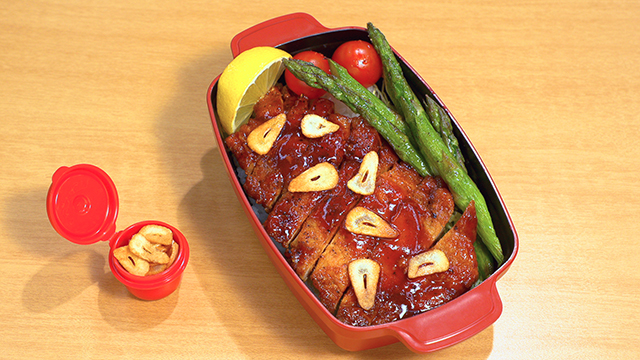
- BENTO RECIPES
- from Episode 19 / Season 6.
- Tonteki Bento
- (767 kcal)
-
 by Marc Matsumoto
by Marc Matsumoto
Bento contents:
Makes enough to pack into 2 bentos
- Tonteki
- Rice
- Shredded cabbage
- Small ripe tomatoes
- Lemon
- Asparagus
Ingredients:
For Tonteki
- 2 tbsp sake
- 1 tbsp soy sauce
- 1 tbsp Worcestershire sauce
- 1 tbsp ketchup
- 1 tbsp honey
- 300 g pork chops
- Black pepper, to taste
- Flour, for dusting
- 2 tbsp vegetable oil
- 15 g garlic, sliced thinly using a mandoline
- 4 stalks asparagus, optional
Directions:
1. Whisk the sake, soy sauce, Worcestershire sauce, ketchup, and honey together in a bowl to make the sauce.
2. Use scissors or a knife to cut slits into the fat cap side of the pork chop about 1 inch deep.
3. Season both sides of the pork with black pepper, then dust the pork with flour.
4. Add the oil to a frying pan over low heat and fry the garlic in a single layer, flipping them repeatedly until they start to tan around the edges and there are no longer bubbles coming from them. Transfer the garlic to a paper towel-lined plate and set aside.
5. If you're making asparagus, turn up the heat to medium-high and add the asparagus to the garlic oil. Stir-fry and season with salt and pepper. Remove the asparagus from the pan.
6. Add the pork chops to the pan and fry until golden brown on one side, and then flip it over and fry the other side.
7. Remove the pork from the pan and use paper towels to wipe out all of the oil from the pan.
8. Add the sauce ingredients to the pan and let the mixture boil until the bubbles get big and shiny. Then, add the pork chops back into the pan and flip them repeatedly to glaze with the sauce.
9. Transfer the pork to a cutting board to cool and pour any remaining sauce into a bowl.
10. Once the pork has cooled, slice it into bite-sized pieces and pack it into your bento box. Drizzle any remaining sauce over the top.
-
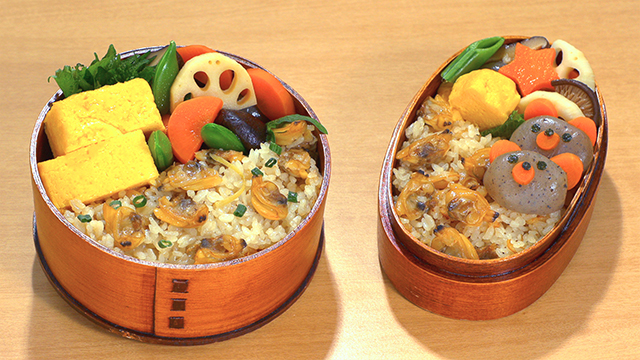
- BENTO RECIPES
- from Episode 19 / Season 6.
- Clam Rice Bento
- (For adults 605 kcal, For kids 322 kcal)
-
 by Maki Ogawa
by Maki Ogawa
Bento contents:
- Clam Rice(260g for adults, 130g for kids)
- Braised vegetables and konnyaku
- Tamagoyaki
- Shiso
- Konnyaku Bear Cubs (for kids)
Ingredients:
For Clam Rice
- 230 g frozen clams
- 2 rice cups (360 ml) rice
- 10 g ginger
- 2 tbsp sake
- 3 tbsp sugar
- 1 tsp salt
- 2 tbsp soy sauce
- 300 ml water
- A pinch of chopped scallions
For the Konnyaku Bear Cubs
- Braised konnyaku
- Carrot
- Nori
Directions:
For Clam Rice
1. Rinse the rice and soak in water for at least half an hour, then drain.
2. Thaw the frozen clams in running water and drain thoroughly. Cut the ginger into shreds.
3. Combine the sake, sugar, salt, soy sauce, and water in a pot, and bring to a boil. Add the clams and ginger and simmer for 2-3 minutes while skimming off the surface scum. Turn off the heat and drain the clams, reserving the liquid for the rice. Set aside to cool.
4. Add the rice and clams to your rice cooker and fill it to the corresponding line with the seasoned liquid. Add water if necessary.
5. If you are cooking the rice in a pot, add the rice, clams, and the liquid prepared in step 3 (use additional water if necessary). Bring to a boil, reduce the heat to low and simmer for 12-14 minutes. Turn off the heat and steam for 10 minutes.
6. Sprinkled with chopped scallions and ginger to taste.
For the Konnyaku Bear Cubs
1. Use a couple of braised konnyaku balls.Decorate with carrot ears and nose and nori for the eyes.
-
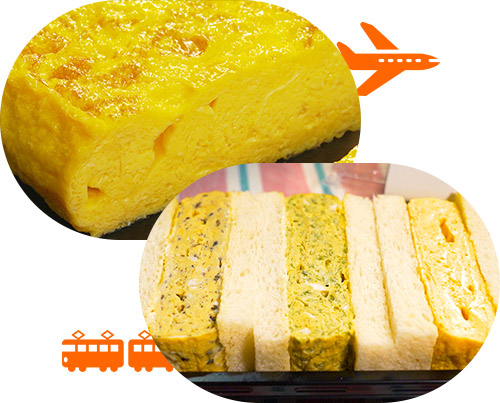
- BENTO TOPICS
- from Episode 19 / Season 6.
- Tokyo
-
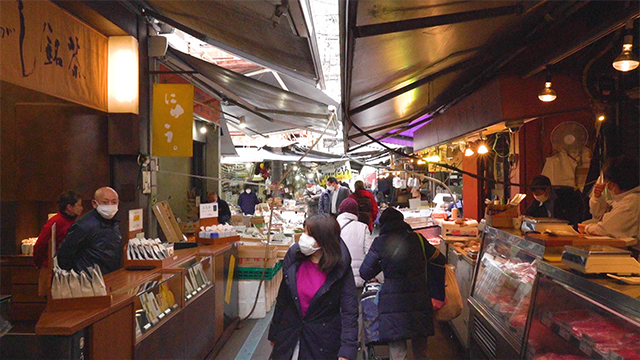
Bento Topics. Today, from Tsukiji in Tokyo, famous for its huge volume and variety of seafood.
-
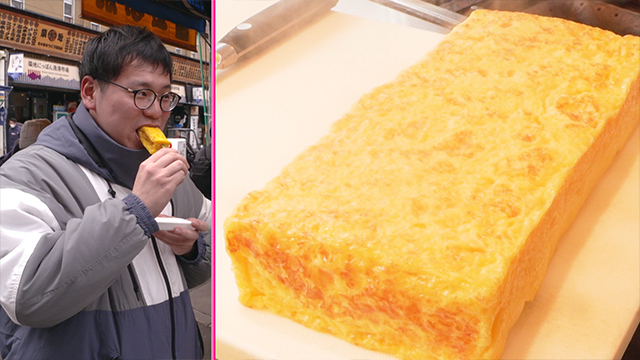
Another thing it's famous for is tamagoyaki, rolled omelets that are perfect for bentos.
There are many stores that specialized in tamagoyaki in Tsukiji. You can eat tamagoyaki cooked right before your eyes. -
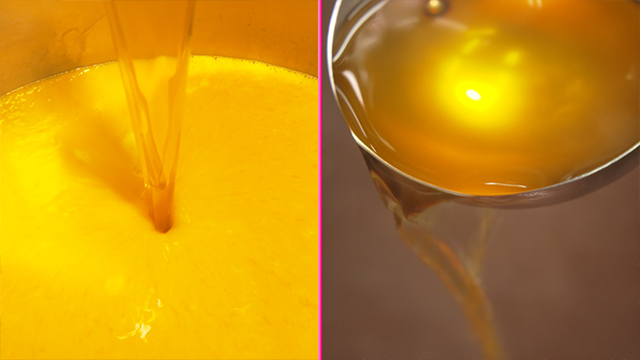
One of the oldest tamagoyaki stores in Tsukiji adds a lot of dashi made from katsuobushi and konbu to the beaten eggs and sugar.
-
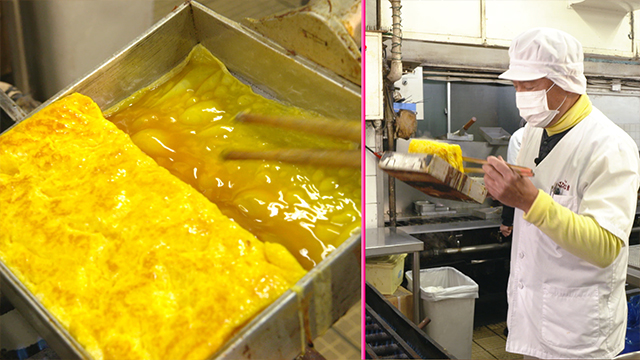
The egg mixture is then poured into a square-shaped tamagoyaki pan and cooked over low heat. Once the egg starts to set, it’s pushed to the side, and then with a flick of the wrist, it’s flipped over.
This is repeated several times to form a rolled omelet with dashi encased between the layers. -
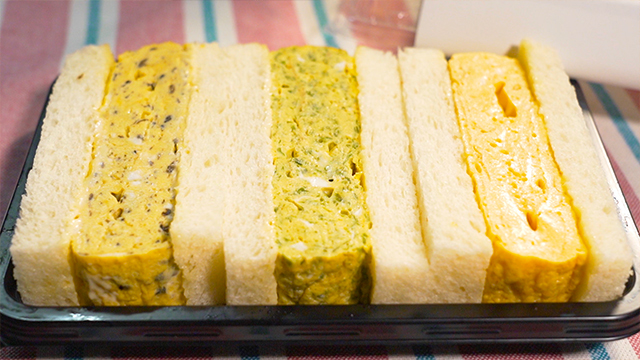
A recent trend is tamagoyaki sandwiched between slices of fluffy white bread.
In addition to plain tamagoyaki, one shop offers variations, including one type with a seaweed called aosa nori, and another type that uses truffles. -
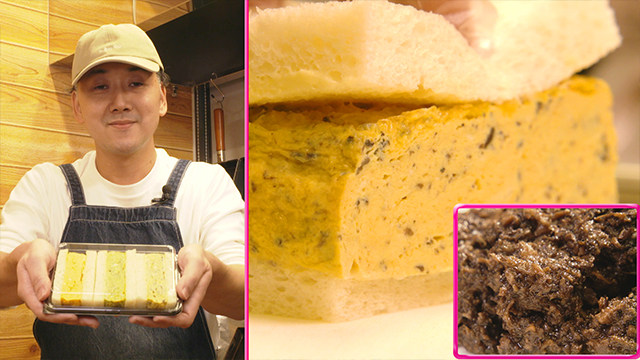
The truffle tamagoyaki features eggs mixed with a homemade paste that uses black truffles and mushrooms. The proprietor hopes to add to the appeal of tamagoyaki by using Western ingredients.
-
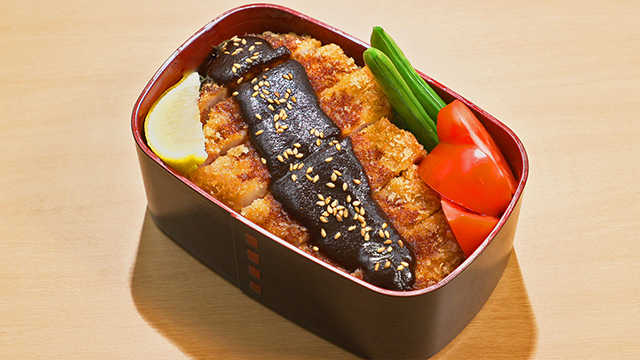
- BENTO RECIPES
- from Episode 18 / Season 6.
- Miso-katsu Bento
- (1335 kcal)
-
 by Marc Matsumoto
by Marc Matsumoto
Bento contents:
Makes enough to pack into 2 bentos
- Miso-katsu
- Rice
- Shredded cabbage
- Boiled snap peas
- Tomato wedges (from small, very ripe tomatoes)
- Lemon wedge
- Gold sesame seeds
Ingredients:
For Miso-katsu
- 60 ml chicken stock
- 2 tbsp sake
- 2 tbsp sugar
- 40 g hatcho miso
- 2 pork rib chops, about 400 g
- Salt and pepper, to taste
- 2 tbsp flour
- 1 egg, beaten
- 75 g panko
- Toasted sesame seeds, for garnish
Directions:
1. To make the miso sauce, add the chicken stock, sake, sugar, and miso to a bowl and whisk until smooth and free of lumps. Transfer the mixture to a pot and bring to a boil until the sauce has thickened.
2. For the tonkatsu, lightly score the cutlets with a knife in a cross-hatch pattern. This helps the panko to adhere to the cutlet.
3. Season the pork on both sides with salt and pepper, and then dust both sides with a thin, even coating of flour.
4. Dip the pork in the egg to coat evenly, then place it on the panko and cover the top surface with more panko. Roll the cutlet around in the panko, gently patting the breadcrumbs to encourage them to stick.
5. Heat 2 inches of vegetable oil in a pot to 170 degrees C (340 degrees F).
6. Deep fry the tonkatsu, flipping it over periodically until it's golden brown on both sides and reads an internal temperature of 66 degrees C (150 degrees F).
7. Drain the tonkatsu on a paper towel-lined rack.
8. When the cutlets are cool enough to handle, slice them into bite-sized pieces and top with the miso sauce and a sprinkle of toasted sesame seeds.
-
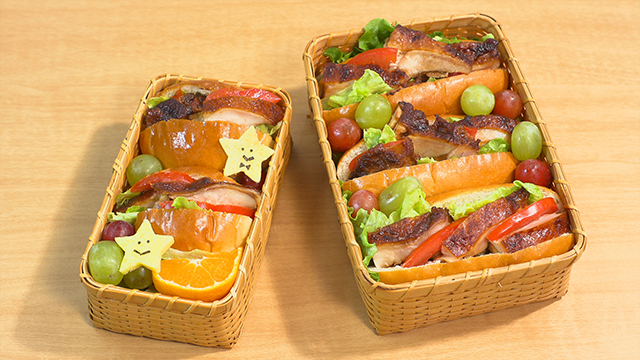
- BENTO RECIPES
- from Episode 18 / Season 6.
- Miso-chicken Sandwich Bento
- (For adults 854 kcal, For kids 471 kcal)
-
 by Maki Ogawa
by Maki Ogawa
Bento contents:
- Miso-chicken Sandwich
- Grapes
- Lettuce
- Mikan (for kids)
- Sweet Potato Stars (for kids)
Ingredients:
For the Miso-chicken (1 piece)
- 1 chicken thigh (approx. 250 g)
- 2 tbsp mame-miso
- 2 tbsp sugar
- 1 tbsp sake
- A dash of vegetable oil
For the Miso-chicken Sandwich
- Miso-chicken
- Mayonnaise
- Lettuce
- Tomato
- Bread of choice (e.g. hot dog buns)
For the Sweet Potato Stars
- Sweet potato
- Nori
Directions:
For the Miso-chicken
1. Place the mame-miso, sugar, and sake in a resealable plastic bag and knead to make the marinade.
2. Trim off the excess fat from the chicken and cut out the sinews.
3. Put the chicken in the plastic bag and rub the marinade into the chicken.
4. Marinate overnight (6 to 8 hours) in the fridge.
5. Scrape off the marinade or use a paper towel to wipe it off. Add a dash of vegetable oil to a pan and place the chicken skin-side down. Fry both sides until nicely browned. If the oil splatters, cover with a lid.
For the Miso-chicken Sandwich
1. Slice open a hot dog bun (or your preferred bread) and toast.
2. Spread with mayonnaise and fill with bite-size pieces of Miso-chicken, sliced tomato, and lettuce.
For the Sweet Potato Stars
1. Blanch the sliced sweet potato and use a star-shaped cookie to cut out. (Blanching makes it easier to cut.)
2. Use nori to form the eyes, mouth, and bow tie with two ▲ shapes.
-
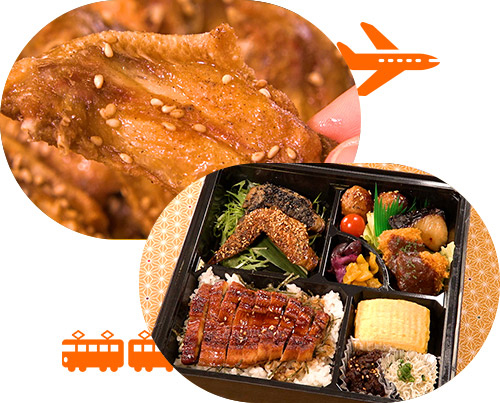
- BENTO TOPICS
- from Episode 18 / Season 6.
- Nagoya
-
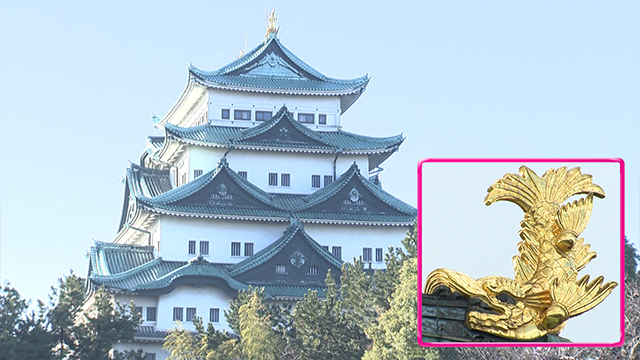
Today, from the largest city in Aichi Prefecture, Nagoya.
Nagoya Castle is a local landmark.
Two golden mythical creatures adorn its roof. -
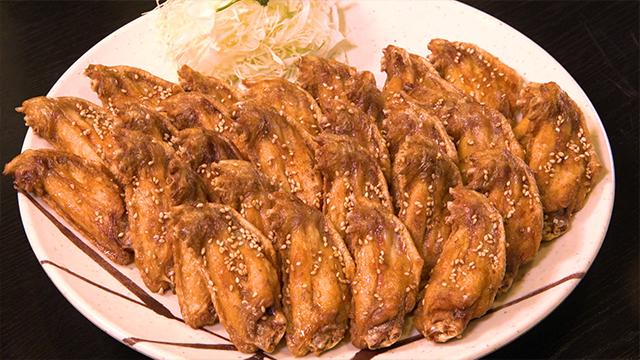
Nagoya is famous for its deep-fried chicken wings, tebasaki.
Sweet, savory, and spicy, tebasaki are a staple in izakaya. -
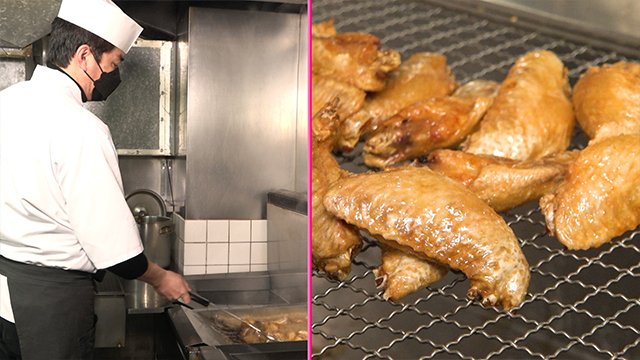
It became the signature dish at this restaurant, which still maintains the original recipe.
The chicken wings are double fried, first in low heat to cook through, and then in high heat to crisp.
-
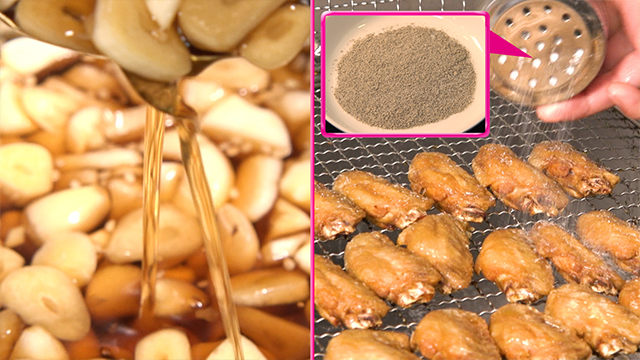
The tebasaki are then coated in a sweet and savory glaze full of garlic.
A special blend of salt, pepper, and spices gives it an addictive kick. -
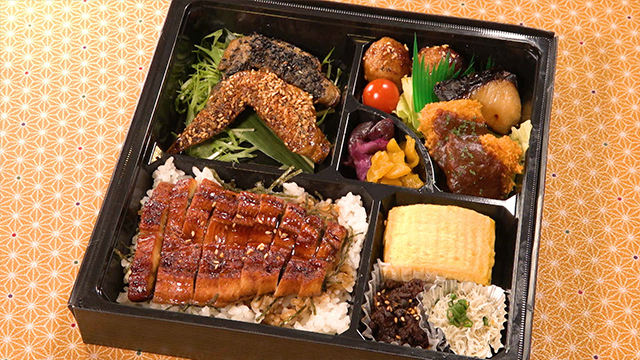
One restaurant has come up with a bento packed with Nagoya’s local specialties, including tebasaki, grilled eel, and a rolled omelet made with eggs from a local breed of chicken, Nagoya Cochin.
-
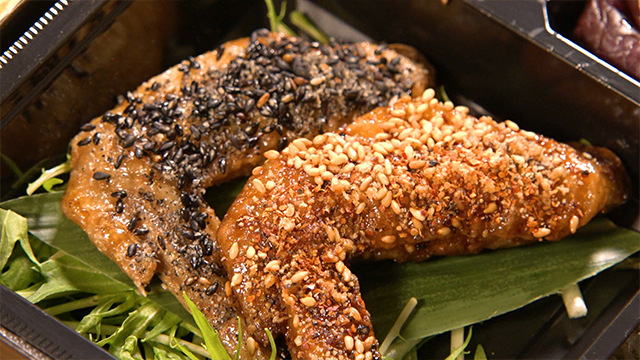
The bento contains two flavors of tebasaki sprinkled with black and golden sesame seeds.
Each restaurant has its own recipe, so it’s fun trying out different flavors.
-
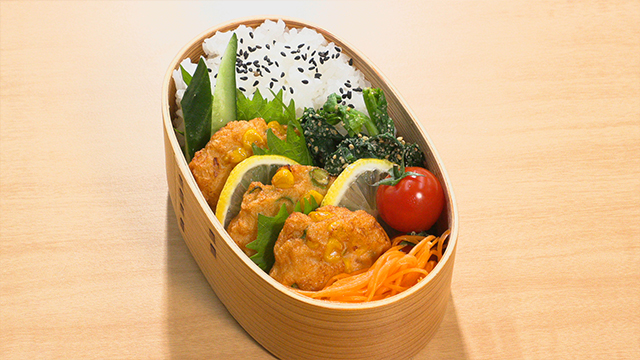
- BENTO RECIPES
- from Episode 17 / Season 6.
- Satsuma-age Bento
- (460 kcal)
-
 by Marc Matsumoto
by Marc Matsumoto
Bento contents:
- Satsuma-age
- Rice
- Black sesame seeds
- Cucumber spears
- Small shiso leaves
- Lemon rounds
- Spinach goma-ae
- Cherry tomatoes
- Carrot salad
Ingredients:
For Satsuma-age
(Makes 12 small satsuma-age)
- 325 g cod (skinless, boneless filets)
- 2 tbsp egg
- 2 tbsp flour
- 2 tbsp sugar
- 1 tbsp sake
- 1 tsp usukuchi soy sauce
- 1/2 tsp salt
- 1/2 tsp ginger juice
- 40 g green beans, diced
- 40 g onion, diced
- 40 g canned corn (drained well)
For carrot salad
- Carrots
- Salt
- Sesame oil
Directions:
For Satsuma-age
1. Add the cod, egg, rice flour, sugar, sake, soy sauce, salt, and ginger juice to a food processor and run until the mixture comes together into a ball (about 2 minutes).
2. Transfer the fish paste into a bowl and add the diced green beans, onions, and corn. Fold the vegetables into the fish until they're evenly distributed.
3. Heat a pot of oil to 180°degrees C (360° degrees F).
4. Wet your hands and grab a golf ball-sized amount of fish paste, squeeze the mixture in your hand to press out any air, and then shape it into a patty that's about 7 mm (1/4-inch) thick. Lower the patties straight into the preheated oil as you shape them.
5. Let the patties fry undisturbed until they start turning a light tan around the edges. Flip the satsuma-age over, then continue frying and flipping periodically until they're golden brown on both sides.
6. Drain the satsuma-age on a paper towel-lined rack, and let cool completely before packing into a bento box.
For carrot salad
1. Cut carrots into thin matchsticks, salt, and then squeeze. Finish by tossing with toasted sesame oil.
-
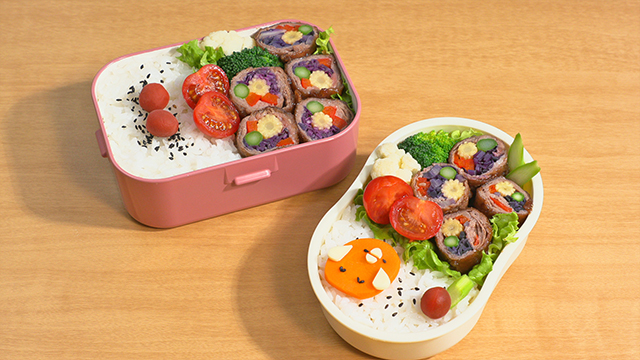
- BENTO RECIPES
- from Episode 17 / Season 6.
- Garden Beef Roll Bento
- (For adults 650 kcal, For kids 374 kcal)
-
 by Maki Ogawa
by Maki Ogawa
Bento contents:
- Rice (250 g for adults, 130 g for kids)
- Garden Beef Rolls
- Cauliflower
- Broccoli
- Asparagus
- Cherry tomatoes
- Black sesame seeds
- Ko-ume umeboshi
- Butterhead lettuce
- Carrot Chick (for kids)
Ingredients:
For Garden Beef Rolls (yields 5)
- 5 thin slices of beef
- 5 pieces of baby corn (boiled)
- 2-3 asparagus spears
- 1 red cabbage leaf
- A piece of red bell pepper
- 3 tbsp 3S Sauce
- 1 tbsp each of sugar, sake, and soy sauce
- A pinch of potato starch
- A pinch of white sesame seeds
- A dash of vegetable oil
For the Carrot Chick
- Carrot
- Sliced cheese
- Black sesame seeds or nori
Directions:
For the Garden Beef Rolls
1. Blanch the red cabbage leaf for about 30 seconds and cut into 3-4 mm wide strips. Blanch the asparagus spears for about a minute and cut into the same length as the width of the sliced beef. Cut the red bell pepper into 5 mm wide strips.
2. Place the baby corn, cabbage, asparagus, and red bell pepper on one end of the sliced beef and roll up.
3. Sprinkle potato starch over the entire roll.
4. Add a dash of oil to a frying pan. Place the rolls seam side down, and fry until nicely browned all over.
5. Add the 3S sauce and bring to a boil. Cover and simmer at low heat to glaze.
6. Set aside until cool enough to handle, then cut in half and sprinkle with white sesame seeds.
For the Carrot Chick
1. Boil a piece of carrot until tender and use an oval-shaped cookie cutter to cut.
2. Use a straw to cut out the beak from the cheese.
3. Use a heart-shaped cookie cutter to cut out the cheese. Cut the heart in half to form the wings.
4. Use black sesame seeds or nori for the eyes and feet.
-
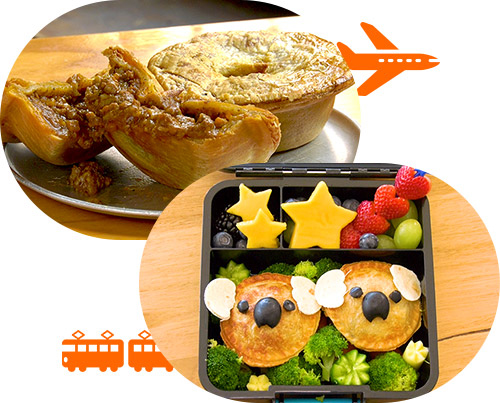
- BENTO TOPICS
- from Episode 17 / Season 6.
- Australia
-

Today, from Australia’s largest city, Sydney. Aussies consider the meat pie to be their national dish.
-
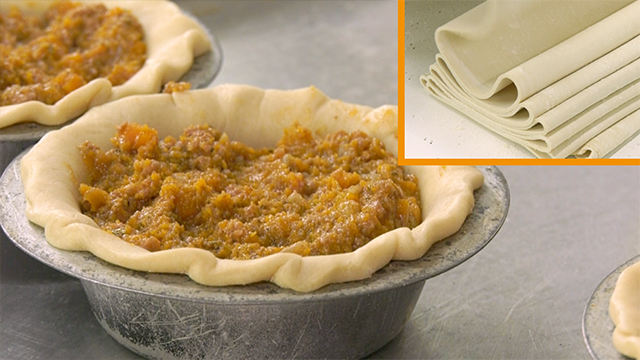
The pie dough is folded over repeatedly to achieve a light and flaky crust, which is then packed with a delicious beef gravy and filling. The most popular pie filling features ground beef, carrots, and all kinds of herbs and spices.
-
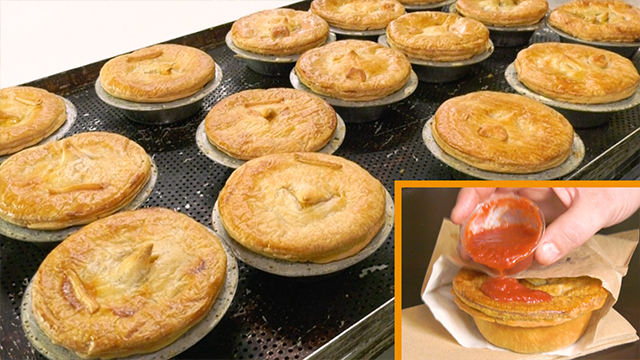
After baking in the oven, the meat pies oozing with rich filling are done. Aussie meat pies are designed to be topped with ketchup and with your hands.
-

Kerry is a school teacher. She makes bentos for her daughter, who wants to become a veterinarian when she grows up. Kerry is going to make a cute animal bento using homemade meat pies.
-
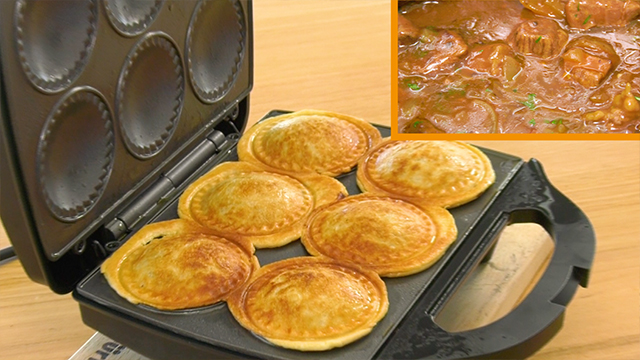
For the filling, she simmers cubed steak in beef stock, tomato paste, butter, herbs, and a savory spread made from yeast extract. Once the meat filling is done, she makes use of a handy pie maker.
-
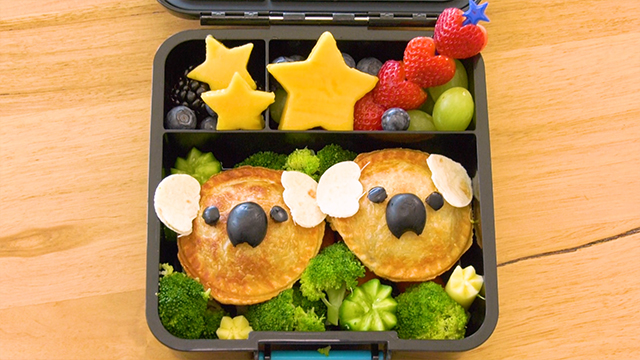
She turns the meat pies into koalas, using tortilla chips for ears, and olives for the nose and eyes. Add some fruit and vegetables, and the koala mom and cub bento is finished.
-
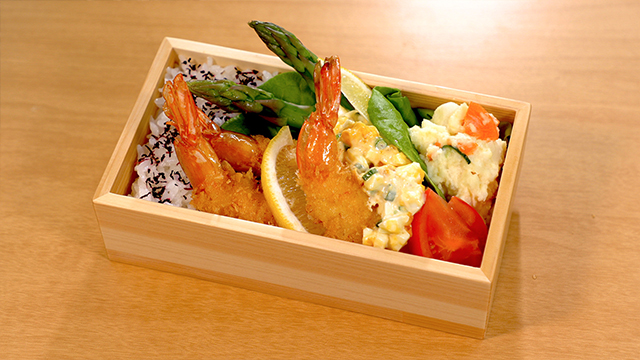
- BENTO RECIPES
- from Episode 16 / Season 6.
- Ebi Fry Bento
- (777 kcal)
-
 by Marc Matsumoto
by Marc Matsumoto
Bento contents:
Makes enough to pack into 2 bentos
- Ebir Fry
- Tartar Sauce
- Rice
- Yukari
- Lemon
- Leaf lettuce
- Small ripe tomato
- Asparagus (boiled)
- Potato salad
Ingredients:
For Ebi Fry
- 200 g shrimp (large; 13/15 size preferable)
- 1/2 tsp baking soda
- 1/4 tsp salt
- Batter
- 1 egg
- 2 tbsp water
- 40 g all-purpose flour
- 50 g panko
For Tartar Sauce
- 1 boiled egg, peeled and chopped
- 1 scallion, minced
- 3 tbsp Japanese mayonnaise
- 1/2 tsp mustard
- Salt and pepper, to taste
Directions:
1. Peel the shrimp, leaving the tail intact. Remove the telson from the tail (the sharp spike in the center). Devein the shrimp.
2. Put the shrimp in a bowl with the baking soda and salt, and massage them together. Let these marinate for a few minutes while you prepare the batter.
3. To make the batter, whisk the egg and water together until it's uniform in color. Next, add the flour and whisk until it's smooth and free of lumps.
4. Preheat a pot with 3 cm of oil to 170 degrees C (340 degrees F).
5. Wash the shrimp until the water runs clear. Then, drain and dry them thoroughly using paper towels.
6. Use a knife to cut shallow slits into the underside of the shrimp at a 45-degree angle. Then, flip the shrimp over and press the backside with your thumbs from one end to the other (you should hear a popping noise). Next, use a knife to scrape out any water in the tail, and repeat this step with the rest of the shrimp.
7. To bread the shrimp, hold by the tail and dip into the batter. Then place the battered shrimp on a bed of panko, and mound the panko over the shrimp, pressing lightly to make it adhere to the batter. Repeat with the remaining shrimp.
8. When the oil is at the right temperature, add the shrimp to the oil and fry until is golden brown and crisp, flipping it over halfway through. This should take about 2-3 minutes.
9. Drain the fried shrimp on a paper towel-lined rack and repeat with any remaining shrimp.
10. To make the tartar sauce, mix all of the tartar sauce ingredients together in a bowl.
-
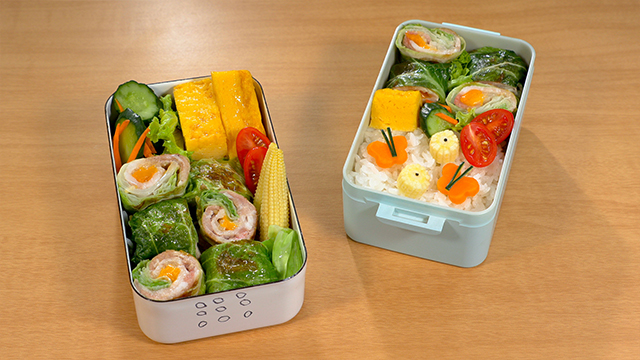
- BENTO RECIPES
- from Episode 16 / Season 6.
- Cabbage Roll Bento
- (For adults 865 kcal, For kids 473 kcal)
-
 by Maki Ogawa
by Maki Ogawa
Bento contents:
- Rice (210 g for adults, 140 g for kids)
- Cabbage Rolls
- Cabbage, carrot, and cucumber pickles
- Tamagoyaki (Japanese-style rolled omelet)
- Cherry tomatoes
- Butterhead lettuce
- Baby corn
- Butterfly and flower-shaped decorations (for kids)
Ingredients:
For the Cabbage Rolls (yields 5)
- 5 cabbage leaves
- 130 g sliced pork belly
- 30 g onion (thinly sliced)
- 5 slices processed cheese
- A pinch each of salt and pepper
- 1-1.5 tsp sake
- A pinch of granulated chicken soup
- A pinch of butter
- 1-2 pieces of dry spaghetti
For the butterfly and flower decorations
- Butterfly
- 2g carrot (boiled)
- A piece of cucumber
- Flowers
- 3g baby corn
- A piece of nori
Directions:
For Cabbage Rolls
1. Turn the cabbage over and make incisions around the core. Place the cabbage under running water to loosen the leaves so that they fall apart while retaining their shape. If the leaves are over about 17 or 18 cm long, trim off the excess and save for the pickles. Blanch the leaves for 30-60 seconds.
2. Cut the sliced pork belly into bite-size pieces and divide into five portions. Squeeze out the excess moisture from the cabbage leaves. Take one leaf and lay it flat. Place a portion of the pork belly in the center, cover with sliced onion and cheese, and sprinkle with salt and pepper.
3. Fold the leaf over the filling in the order of ● and ★, then roll it up. Sprinkle with a pinch of salt and pepper. Secure with a piece of spaghetti. Repeat the process to make a total of five cabbage rolls.
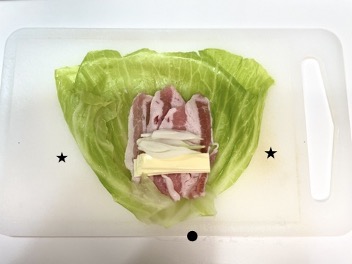
4. Melt the butter in a frying pan and place the rolls seam side up. Fry over medium-low heat until nicely browned.
5. Turn over and fry for 1-2 more minutes.
6. Add the granulated chicken soup and sake, cover, and steam for 2 minutes to cook through.
For the butterfly and flower decorations
Butterfly:
Peel the cucumber and cut the peel into thin strips for the antennae. Use a butterfly-shaped cookie cutter to cut out the carrot and place the cucumber antenna on top.
Flowers:
Cut the baby corn. Cut tiny circles from the nori and place in the center of the corn.
-
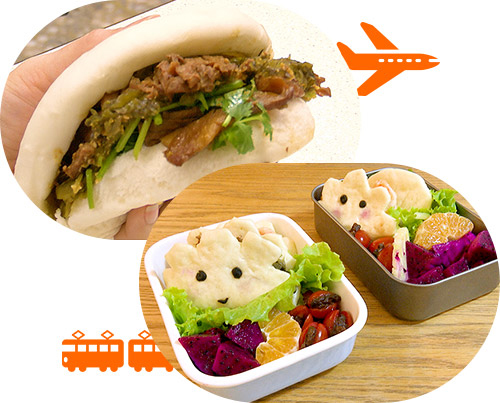
- BENTO TOPICS
- from Episode 16 / Season 6.
- Taiwan
-

Today, from the food lover's paradise of Taiwan. There’s always a long line in front of one eatery that specializes in one of Taiwan’s favorite comfort foods.
-
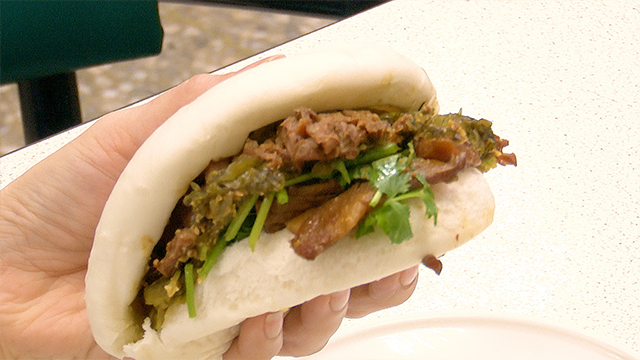
Gua bao is a Taiwanese pork burger featuring fluffy steamed buns stuffed with tender braised pork belly, pickled mustard greens, peanut powder, and cilantro. The half-moon shape of the bao buns resembles a money pouch, which is why eating bao has been thought to bring good luck since ancient times.
-
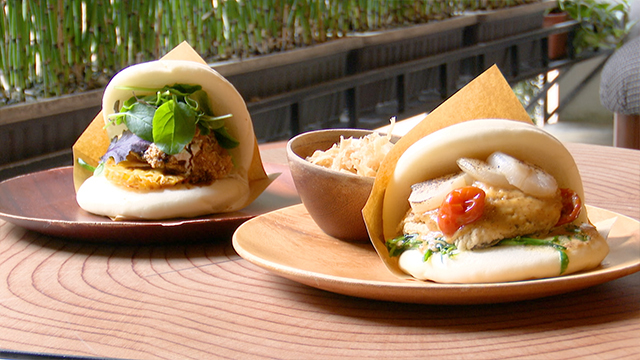
A new style of gua bao stuffed with a variety of interesting combinations like scallops and white fish, or Taiwanese sweet pineapple and fried chicken, has become popular with trend-setting youngsters.
-
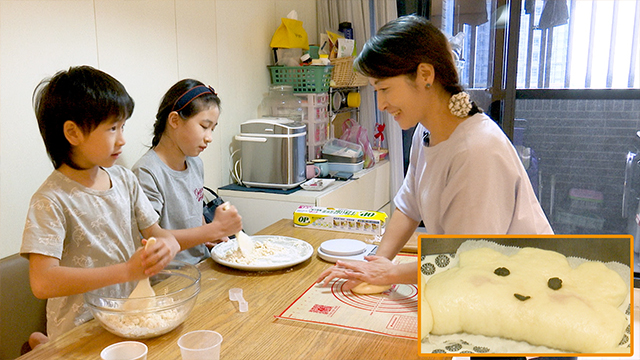
Bento maker Teresa is going to make an original gua bao bento with the help of her kids, Ariel and Ray. She makes her buns from scratch, using flour, milk, and sugar. Ariel trims the buns and decorates them to look like baby clouds.
-
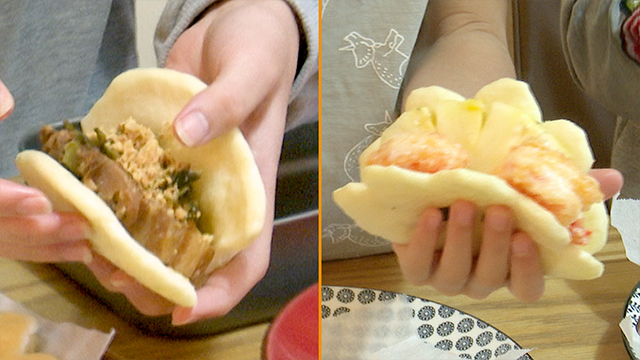
Teresa prepares two types of fillings. One is the standard gua bao filling of braised pork belly and homemade peanut powder. For the other filling, she adds juicy and sweet Taiwanese pineapple to deep-fried shrimp mixed with mayonnaise.
-
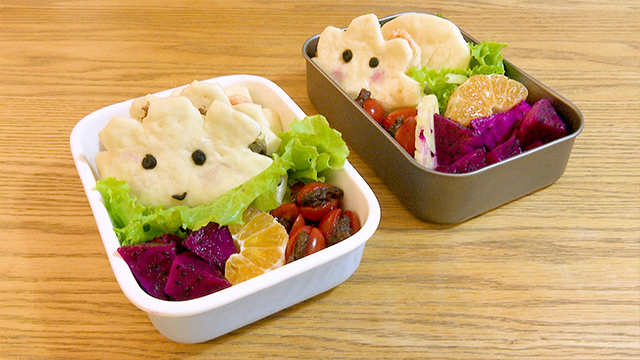
Along with the two kinds of gua bao, Teresa adds a traditional snack of cherry tomatoes stuffed with dried plums. She also adds an assortment of colorful fruits, completing her original Taiwanese gua bao bento!
-
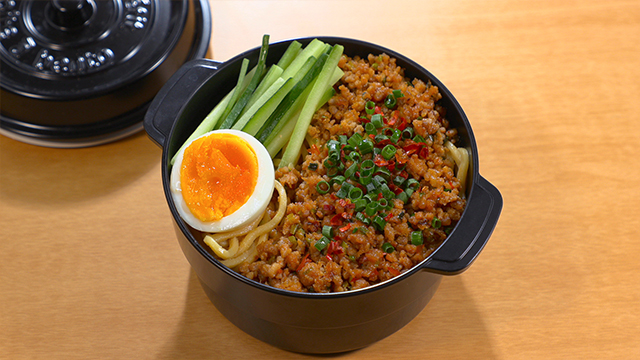
- BENTO RECIPES
- from Episode 15 / Season 6.
- Tantanmen Bento
- (758 kcal)
-
 by Marc Matsumoto
by Marc Matsumoto
Bento contents:
Makes enough to pack into 2 bentos
- Tantanmen
- Cucumber
- Boiled egg
- Chili flakes
- Scallion
Ingredients:
For Tantanmen pork
- 150 g ground pork (very cold)
- 2 tsp soy sauce
- 1 tbsp mirin
- 1 tbsp doubanjiang
- 1/4 tsp ground Sichuan pepper
- 2 tbsp vegetable oil
- 25 g scallions, minced
- 9 g ginger, grated
- 9 g garlic, grated
For Tantanmen sauce
- 1 tbsp tahini
- 1 1/2 tbsp soy sauce
- 1 tbsp toasted sesame oil
- 2 tsp sugar
- 2 tsp rayu (chili oil)
- 60 ml boiling water
For serving
- 260 g fresh thick ramen noodles (boiled according to package directions)
- Green parts of scallions, finely chopped
- 50 g cucumber, julienned
Directions:
1. To make the sauce for the tantanmen, whisk the tahini, soy sauce, sesame oil, sugar, and rayu (chili oil) together in a bowl. Next, add the boiling water and whisk it in to create a smooth sauce.
2. Mix the cold pork, soy sauce, mirin, doubanjiang, and Sichuan pepper together with chopsticks. The mixture should still be crumbly.
3. Heat a frying pan over medium-high heat and add the vegetable oil, chopped scallions, grated garlic, and grated ginger. Fry the aromatics until they start to brown.
4. Add the marinated pork and use a spatula to crumble it up. It's done when there is no liquid left in the pan.
5. Boil the noodles according to the package directions. When they're done, drain them and rinse them in several changes of cold water to chill them and remove any excess starch from their surface.
6. Drain the noodles well and put them in a bowl along with the Tantanmen sauce. Toss to coat evenly.
7. To pack the bento, put a layer of noodles at the bottom of the bento box and top them with the stir-fried pork, julienned cucumbers, and scallions.
-
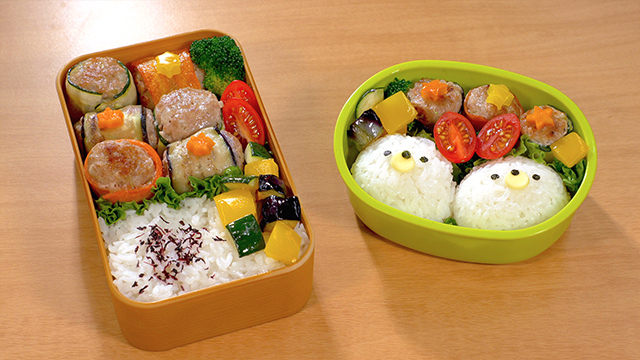
- BENTO RECIPES
- from Episode 15 / Season 6.
- Veggie Wrapper Shumai Bento
- (For adults 591 kcal, For kids 330 kcal)
-
 by Maki Ogawa
by Maki Ogawa
Bento contents:
- Rice (220 g for adults, 120 g for kids)
- Vegetable Wrapper Shumai
- Deep-fried vegetables with ginger
- Butterhead lettuce
- Broccoli
- Cherry tomatoes
- Bell peppers cut into stars
- Yukari (red shiso rice seasoning) (for adults)
- Baby Seal Onigiri (for kids)
Ingredients:
For Vegetable Wrapper Shumai (yields 10)
- 160 g ground pork
- Zucchini, eggplant, carrot (for the wrappers)
- Bell pepper (for decoration)
- 100 g onion
- 1.5 tsp oyster sauce
- A pinch each of salt and pepper
- 2 tsp potato starch
For the deep-fried vegetables
- Leftover zucchini, bell pepper, and eggplant
- Grated ginger
- Vegetable oil
For the Baby Seal Onigiri
- Rice
- Salt
- Sliced cheese
- Nori
Directions:
For the Vegetable Wrapper Shumai
1. Peel the eggplant and zucchini using a mandoline slicer. Use a vegetable peeler to peel the carrot. Soak the eggplant in water to prevent discoloration.
2. Cut the peel into 2-2.5 cm wide strips.
3. Combine the ground pork and minced onion. Then add the potato starch, oyster sauce, and salt and pepper, and knead well.
4. Divide the mixture into 25 g meatballs.
5. Wrap the vegetable strips around the meatballs.
6. Coat the edges with potato starch and sprinkle some on top.
7. Oil the frying pan and place the vegetable wrapper shumai seam-side down.
8. Once the edges are fixed, turn the shumai up and fry for 2 minutes over low to medium heat.
9. Add 1 tbsp of water, cover, and steam on low heat.
10. Once the water has evaporated, uncover, turn up the heat to medium-low, and fry to a crisp.
11. Use a star-shaped cookie cutter to cut out pieces of bell pepper. Deep-fry and place on the shumai.
For the deep-fried vegetables
1. Cut the zucchini, bell pepper, and eggplant into bite-size pieces.
2. Deep-fry in oil preheated to 170 degrees C.
3. Season with grated ginger.
For the Baby Seal Onigiri
1. Sprinkle salt over the rice and form into oval-shaped rice balls.
2. Cut out the nose from the cheese. Cut out the nori for the eyes and an accent for the nose.
-
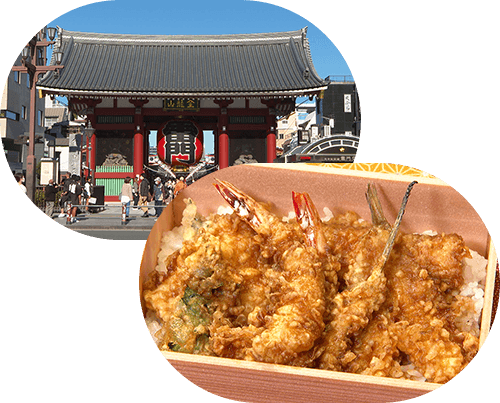
- BENTO TOPICS
- from Episode 15 / Season 6.
- Tokyo
-

Today, from the waterfront of Tokyo Bay. Tokyo Bay has been a rich fishing ground since the Edo period. Some fishers continue to catch fish the traditional way, casting huge nets that measure 14 meters across.
-
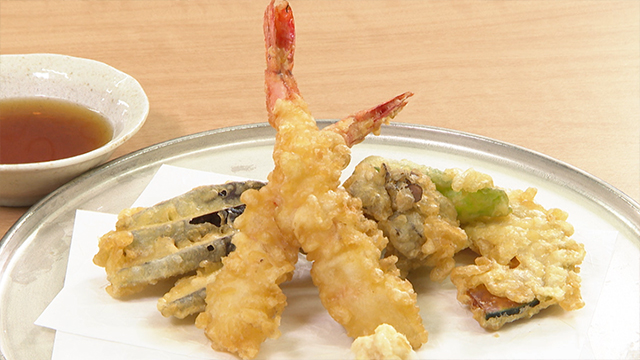
Fish from Tokyo Bay inspired Japan’s internationally famous dish of tempura. It originated as an Edo period version of fast food, and was sold exclusively at street stalls.
It was a favorite among the people of Edo. -
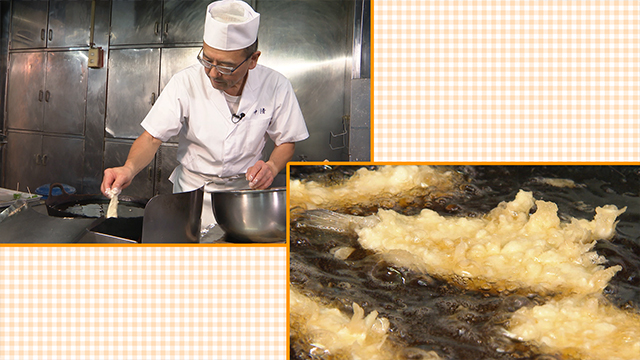
This tempura restaurant in Asakusa can be traced back to an Edo period street stall. Its sixth-generation owner carries on the family legacy and continues to serve traditional Edo-style tempura.
-
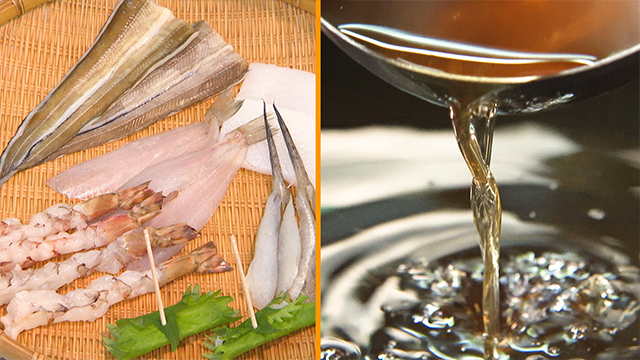
The tempura ingredients are limited to conger eel, shrimp,
Japanese silver whiting, and other seafood. Coated in a thick batter, the ingredients are fried in aromatic sesame oil. -
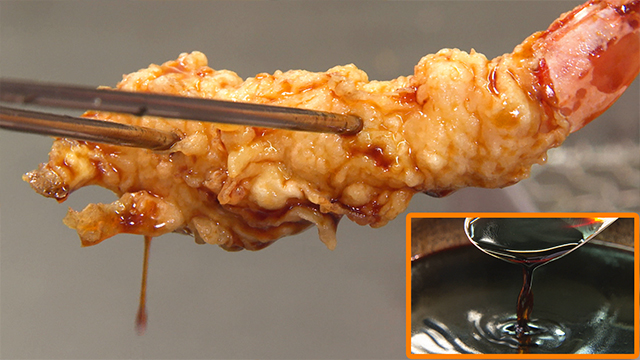
The tempura is then dipped in a sauce made by boiling down
katsuo dashi, soy sauce, and mirin.
The thick and fluffy batter soaks up the delicious sauce. -
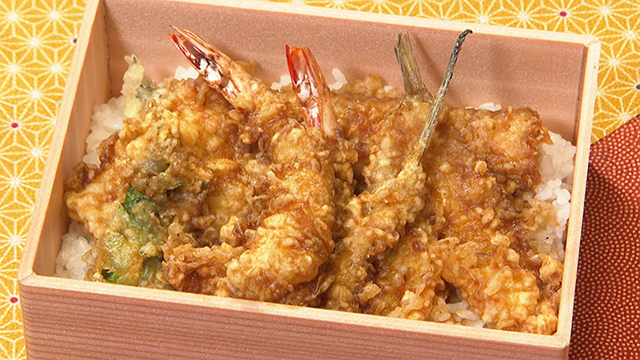
The tempura is then place on a bed of rice and drizzled with more sauce, and the traditional Edo tempura bento is complete.
-
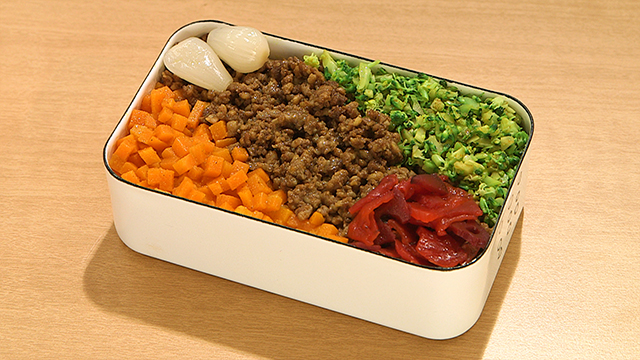
- BENTO RECIPES
- from Episode 14 / Season 6.
- Triple Curry Soboro Bento
- (546 kcal)
-
 by Marc Matsumoto
by Marc Matsumoto
Bento contents:
Makes enough to pack into 2 bentos
- Chicken Curry Soboro
- Broccoli Curry Soboro
- Carrot Curry Soboro
- Rice
- Fukujinzuke
- Rakkyo
Ingredients:
For Chicken Curry Soboro
- 180 g ground chicken
- 3 tbsp 3S sauce
- 1 tbsp curry powder
- 1/2 tsp cocoa powder
- 2 tsp vegetable oil
- 1 clove garlic, minced
For Broccoli Curry Soboro
- 90 g broccoli, cut into florets
- 1/2 tsp toasted sesame oil
- 1 tsp soy sauce
- 1/2 tsp curry powder
For Carrot Curry Soboro
- 90 g carrots, sliced into 4 mm thick slices
- 1 tsp vegetable oil
- 1/2 tsp curry powder
- 1/8 tsp salt
Directions:
1. Add the chicken to a bowl, along with the 3S sauce, curry powder, cocoa powder, and salt. Stir with chopsticks to mix together.
2. Heat a frying pan over medium-high heat and add the oil and garlic. Saute until it's fragrant and just starting to brown.
3. Add the seasoned chicken mixture and stir-fry it while using the side of a spatula to break it up into small crumbs.
4. The chicken soboro is done when the meat is crumbly, and there is no liquid left in the pan.
5. For the vegetables, add the sliced carrots to a pot of water and bring them to a boil. Cook the carrots until just tender enough to slide a toothpick through, but not mushy. Add the broccoli and boil for another 30 seconds.
6. Drain the vegetables and let them cool enough to handle.
7. While you are waiting, add the sesame oil, soy sauce, and curry powder for the broccoli to one bowl. Add the vegetable oil, curry powder, and salt for the carrots to another. Mix each to dissolve the curry powder.
8. When the carrots are cool enough to handle, cut the slices into 4mm thick strips, then cut the strips into cubes. Add them to the appropriate bowl and toss to coat evenly.
9. For the broccoli, shave off the tips of the florets using a knife and then mince up the stems. Add the broccoli to the other bowl and stir to combine.
10. To pack the bento, add a layer of rice and then top with the chicken, carrot, and broccoli soboro.
-
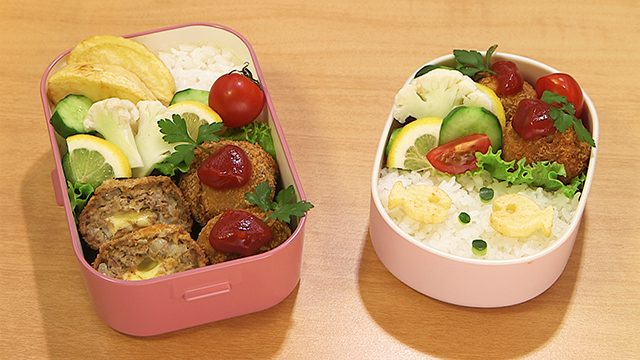
- BENTO RECIPES
- from Episode 14 / Season 6.
- Saba Katsu Bento
- (For adults 668 kcal, For kids 370 kcal)
-
 by Maki Ogawa
by Maki Ogawa
Bento contents:
- Saba Katsu
- Ketchup
- Italian parsley
- Rice (190 g for adults, 125 g for kids)
- Quick Pickled Cucumbers with Lemon
- Boiled cauliflower
- Cherry tomatoes
- Red leaf lettuce
- Fried potatoes (for adults)
- Green peas (for kids)
- Fried Potato Fishies (for kids)
Ingredients:
For Saba Katsu
- 100 g canned mackerel in water (drained)
- 50 g tofu (silken type if available)
- 75 g onion
- 1 slice cheese
- 1/2 tsp curry powder
- A pinch each of salt and pepper
- 2 tsp potato starch
- Vegetable oil for deep frying, as needed
- Batter
- Egg
- Flour
- Panko
For Quick Pickled Cucumbers with Lemon
- Cucumber
- Salt
- Lemon juice
For Fried Potato Fishies
- Potato
Directions:
For Saba Katsu
1. Drain the mackerel and pat dry with a paper towel to remove excess water. Mince the onion.
2. Combine the mackerel, onion, tofu, curry powder, potato starch, salt, and pepper. Mix well.
3. Form into 5-6 balls . Dice the sliced cheese and place a piece in the center of each ball.
4. Bread in flour, beaten egg, and panko. Preheat the oil to 170 degrees Celsius and fry to a golden brown.
For Quick Pickled Cucumbers with Lemon
1. Massage a generous amount of salt into the cucumbers and soak in lemon juice for half an hour.
For Fried Potato Fishies
1. Use a fish-shaped cookie cutter to cut out the fish shapes from sliced potato, and use a straw to cut out the eyes.
2. Fry together with the saba katsu.
-
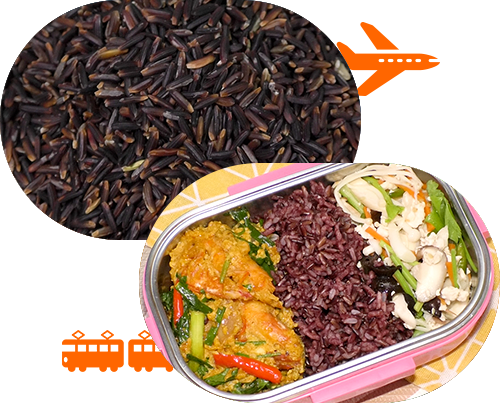
- BENTO TOPICS
- from Episode 14 / Season 6.
- Thailand
-
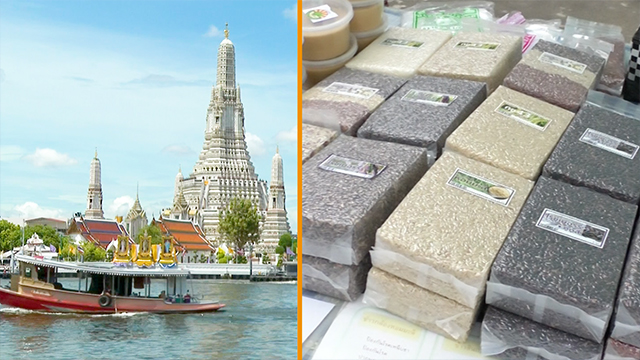
Today, from Bangkok, the capital of Thailand. Here, rice is a staple food. Market stalls offer a wide variety of colorful rice strains.
-
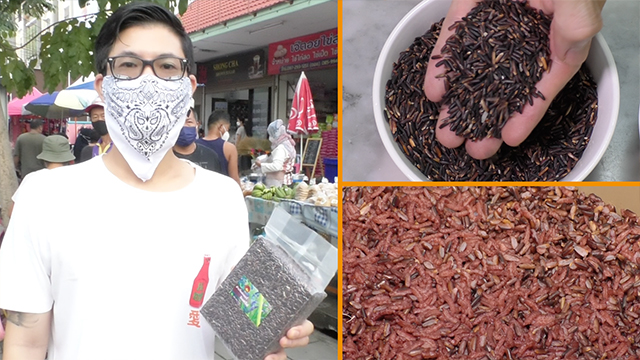
Bento maker Ty is going to cook riceberry, a crossbreed of fragrant jasmine rice and black rice which is rich in fiber and vitamins. It’s known as a superfood throughout the world, and it’s easy to cook. Just use a rice cooker!
-
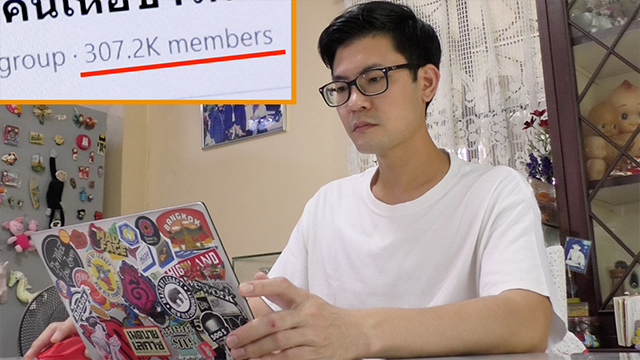
In the midst of the COVID-19 lockdown, Ty set up a bento community on social media. In just five months, it attracted 300,000 members who love to share bento ideas. Riceberry is a popular ingredient in many of these bentos.
-
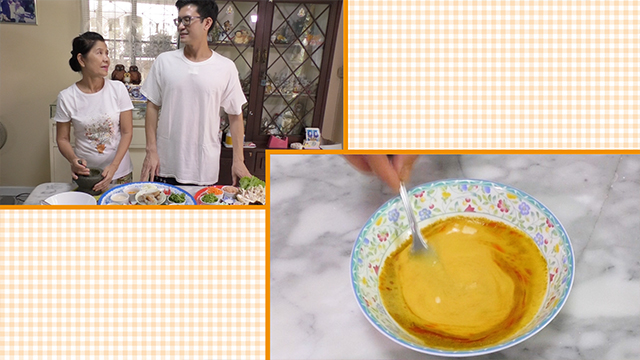
Together with his mom, Pat, Ty makes a curry shrimp stir-fry that goes well with riceberry. The sauce contains milk, curry powder, and other seasonings. It also includes eggs, the secret ingredient in Pat’s recipe.
-
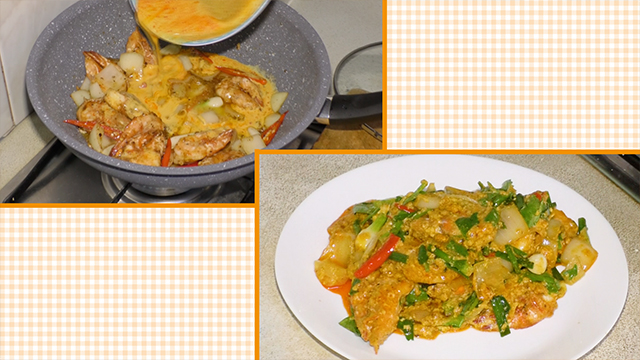
After stir-frying an aromatic blend of garlic, chopped onions, red chili, and shrimp, he adds the curry sauce. After a brief simmer, the mild and fragrant curry is done.
-
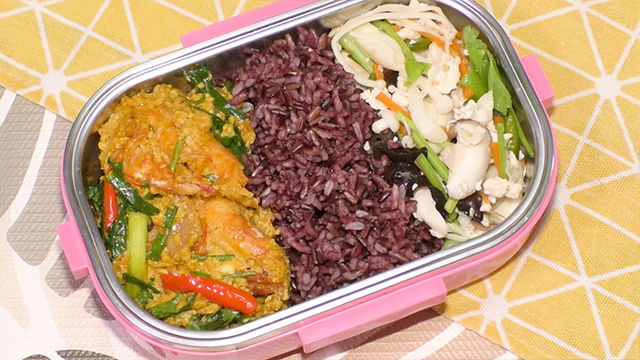
He places the purple riceberry in the center of the bento box and adds the curried shrimp and a spicy and tangy mushroom salad on either side. And of course, he’s going to share his mom’s recipe with his bento friends online.
-
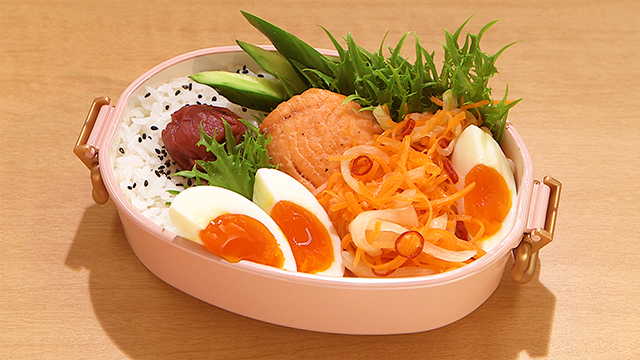
- BENTO RECIPES
- from Episode 13 / Season 6.
- Salmon Nanbanzuke Bento
- (626 kcal)
-
 by Marc Matsumoto
by Marc Matsumoto
Bento contents:
- Salmon Nanbanzuke
- Rice
- Lettuce
- Cucumber sticks
- Black sesame seeds
- Umeboshi
Ingredients:
For Salmon Nanbanzuke
For salmon
- 150 g skinless salmon fillets
- Salt, to taste
- Pepper, to taste
- 1 tbsp flour, for dusting
- Vegetable oil, for frying
For vegetables
- 50 g onions, thinly sliced
- 50 g carrots, julienned
- 1/2 tsp salt
To assemble
- 2 hard-boiled eggs, peeled
- 4 tbsp rice vinegar
- 1 tbsp sugar
- 1 pinch dried chili peppers, optional
Directions:
1. Bring the onions and carrots to a boil and toss them with 1/2 teaspoon of salt. Set these aside.
2. Preheat a pot with 1 inch of oil heated to 360 degrees F (180 degrees C).
3. Season the salmon fillets with salt and pepper on both sides, then dust them with an even coating of flour.
4. Fry the salmon until it starts to brown around the edges and is cooked through (about 2 minutes). Let the salmon drain on a paper towel-lined rack.
5. Massage the carrots and onions together to coax out their liquid, then squeeze them between your hands to remove as much liquid as you can.
6. Transfer them to a clean bowl and add the rice vinegar, sugar, and chili peppers. Stir to combine.
7. Place the fried salmon and peeled eggs in a container that's just large enough to hold them in a single layer. Dump the carrot and onion mixture on top in an even layer.
8. Cover and refrigerate overnight.
*When using boiled eggs in your bento, be sure to cook them thoroughly.
-
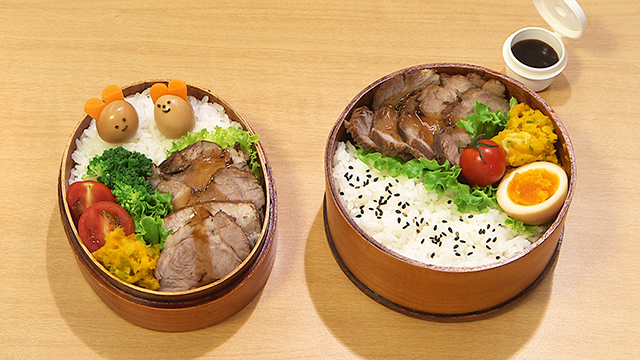
- BENTO RECIPES
- from Episode 13 / Season 6.
- Braised Pork Bento
- (For adults 569 kcal, For kids 511 kcal)
-
 by Maki Ogawa
by Maki Ogawa
Bento contents:
- Rice (195 g for adults, 100 g for kids)
- Braised pork
- Kabocha Pumpkin Salad
- Cherry tomatoes
- Broccoli
- Red leaf lettuce
- Hard-boiled egg (for adults)
- Black sesame seeds (for adults)
- Quail Egg Bunnies (for kids)
Ingredients:
For Braised Pork
- 500 g block of pork shoulder loin
- 2 black tea bags
- 150 ml soy sauce
- 50 ml rice vinegar
- 100 ml sake
- 100 ml sugar
- A pinch of potato starch
For Kabocha Pumpkin Salad
- 100 g kabocha pumpkin (1 cm thick slices)
- 20 g onion (thinly sliced)
For Quail Egg Bunnies
- Quail eggs
- Boiled carrot
- Nori
Directions:
For Braised Pork
1. Place the pork and tea bags in a pot, cover with water and bring to a boil.
2. Remove the surface scum and simmer over medium heat for 40-50 minutes.
3. In a separate pot, add the soy sauce, sake, rice vinegar, and sugar. Bring to a boil. Turn off the heat and add the pork to marinate while hot. (Use a deep and narrow pot so that the pork is completely immersed in the marinade.)
4. Once the pork and marinade have cooled to room temperature, transfer to a zippable food storage bag along with some hard-boiled eggs and quail eggs, and marinate overnight in the fridge.
5. The following morning, slice the pork to taste.
6. Pour 80-100 ml of the marinade into a saucepan and bring to a boil. Add potato starch mixture (1 tsp potato starch mixed with 2 tsp of water) to thicken.
7. Place the sliced pork over the rice, and pour the sauce into a separate container.
*When using boiled eggs in your bento, be sure to cook them thoroughly.
For the Kabocha Pumpkin Salad
1. Lightly cover the sliced pumpkin with plastic wrap and microwave (600W) for 4-5 minutes.
2. Mash, season with salt and pepper, and mix with mayonnaise.
For Quail Egg Bunnies
1. Make two slits in the quail eggs and insert the ears (made from strips of boiled carrot).
2. Use nori for the eyes, nose, and mouth.
-
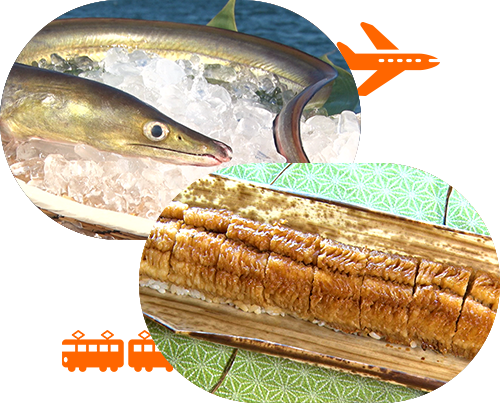
- BENTO TOPICS
- from Episode 13 / Season 6.
- Awaji Island
-

Today, from Awajishima, an island in the Seto Inland Sea, which boasts one of Japan’s richest fishing grounds.
-
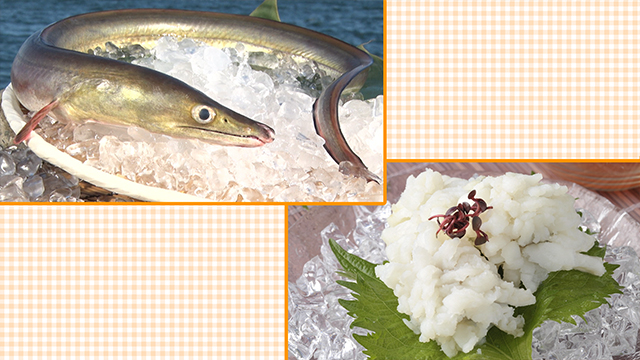
One of the island’s specialties is hamo, or daggertooth pike conger, a species of eel. Contrary to its frightening appearance, it’s a fish with a refined flavor and texture. When blanched, the sliced hamo curls up and looks like a pure white flower.
-
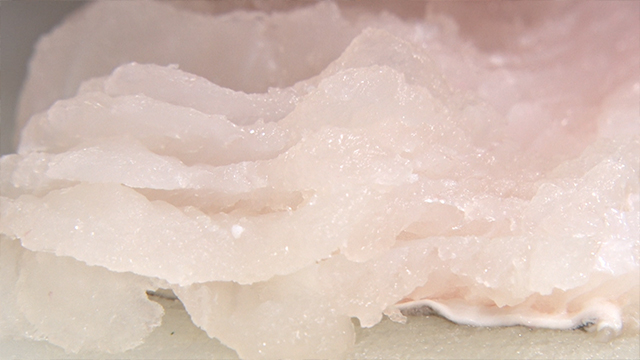
This is because of the way the hamo is cut. It has as many as 3,500 small bones, so in order to improve the texture and make it easier to eat, the bones need to be cut by making incisions at intervals of less than 1 mm.
-
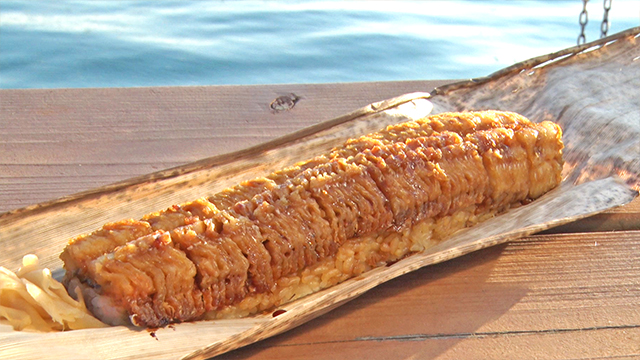
Awaji Island’s specialty bento is hamo zushi—sushi rice topped with charcoal-broiled hamo basted with a sweet and savory sauce.
-
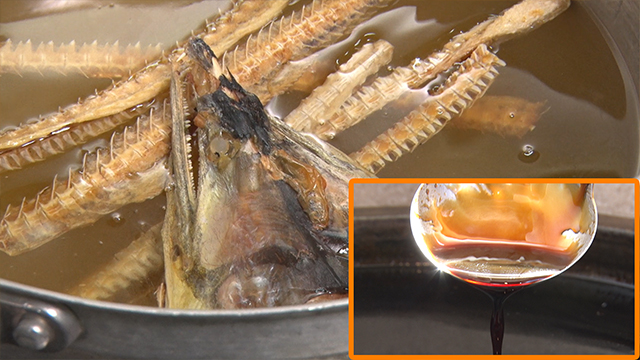
Even the sauce is made with hamo! The head and bones are grilled and simmered with mirin, sake, sugar, and soy sauce. Hamo is rich in umami and makes an excellent dashi.
-
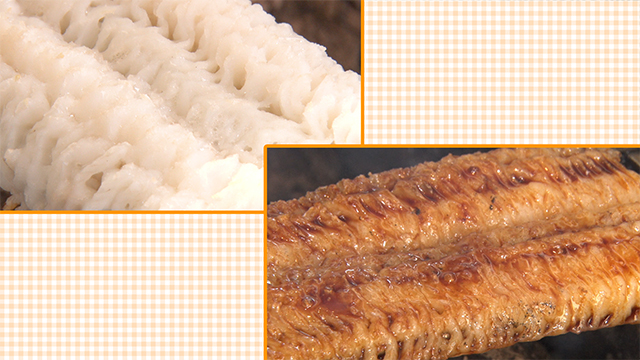
The hamo is charcoal-broiled, dipped in sauce and broiled again. This is repeated three times until the hamo is steeped in flavor and has a tantalizing aroma. The hamo is then placed on a bed of sushi rice, the hamo zushi bento is complete.
-
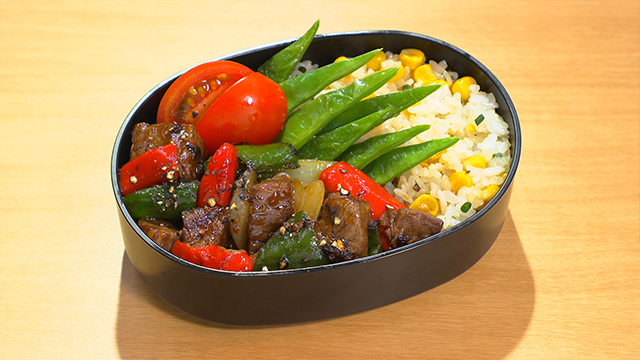
- BENTO RECIPES
- from Episode 12 / Season 6.
- Saikoro Pepper Steak Bento
- (645 kcal)
-
 by Marc Matsumoto
by Marc Matsumoto
Bento contents:
- Saikoro Pepper Steak
- Corn and scallion fried rice
- Deep fried Romano beans
- Small ripe tomato (cut into wedges)
Ingredients:
For Saikoro Steak Pepper
Makes 2 servings
- 5 g black peppercorns
- 200 g beef steak (cut into 2.5 cm cubes)
- 2 tbsp oyster sauce
- 1 tbsp sake
- 1 tsp sesame oil
- 1/2 tsp potato starch
- 1 tbsp vegetable oil
- 5 g garlic (minced)
- 75 g bell peppers (mix of green and red, cut into 2 cm squares)
- 50 g onion (cut into 2 cm squares)
For corn and scallion fried rice
- Canned corn
- Sesame oil
- Soy sauce
- Black pepper
- Scallions
Directions:
For Saikoro Steak Pepper
1. Crack the peppercorns with a mortar and pestle, or you can use the bottom of a heavy pot to crush them on a cutting board.
2. Add the black pepper, beef, oyster sauce, sake, sesame oil, and potato starch to a bowl and combine evenly.
3. Heat a frying pan over high heat and add the oil and garlic.
4. When the garlic starts to get fragrant, add the beef in a single layer, reserving any marinade in the bowl for later.
5. Brown the beef on one side, and then flip it over and brown the other side.
6. When the beef has browned on two sides, add the bell peppers and onions and stir-fry until the beef has cooked through and the vegetables are vibrant in color but still crisp.
7. Pour in the remaining marinade and toss to coat until the sauce has thickened.
For corn and scallion fried rice
1. Stir-fry rice with canned corn, seasoned with sesame oil, soy sauce, and black pepper.
2. Finished with chopped scallions.
-
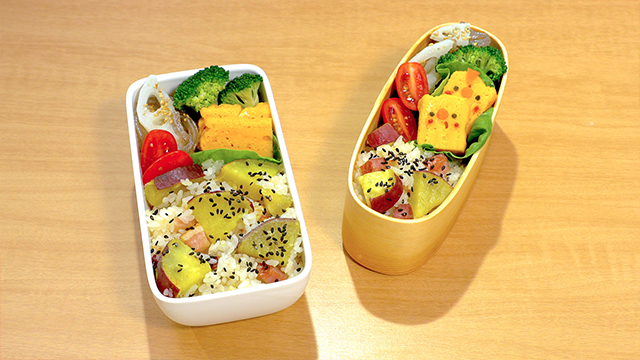
- BENTO RECIPES
- from Episode 12 / Season 6.
- Sweet Potato Rice Bento
- (For adults 427 kcal, For kids 268 kcal)
-
 by Maki Ogawa
by Maki Ogawa
Bento contents:
- Sweet Potato Rice (200 g for adults, 115 g for kids)
- Blanched broccoli
- Butterhead lettuce
- Lotus Root and Konnyaku Simmered in Shirodashi
- Cherry tomatoes
- Tamagoyaki rolled omelet
Ingredients:
For Sweet Potato Rice
- 2 rice cups (360 ml) rice
- 360ml water
- 200 g sweet potato
- 90 g bacon
- 1 tbsp granulated chicken soup
- 1/2 tsp salt
- 1 tbsp sake
- Black sesame seeds, as needed
For the Lotus Root and Konnyaku Simmered in Shirodashi
- 50 g lotus root
- 30 g ito konnyaku (thick)
- A dash of sesame oil
- 1 tbsp shirodashi
- 2 tbsp water
- A pinch of white sesame seeds
For the Baby Chick Tamagoyaki (for kids)
- Tamagoyaki
- Carrot
- Nori
- Ketchup
Directions:
For Sweet Potato Rice
1. Cut the sweet potato into 3 cm cubes and soak in water. Change the water three times and soak for about 10 minutes to remove the surface starch. Drain thoroughly.
2. Place the washed rice and water in a pot. Add the sweet potato, sliced bacon, granulated chicken soup, sake, and salt. Bring the pot to a boil. Reduce the heat to low and simmer for 12-14 minutes. Turn off the heat and steam for 10 minutes.
You can also cook automatically using a rice cooker.
3. Sprinkle with black sesame seeds.
For the Lotus Root and Konnyaku Simmered in Shirodashi
1. Peel the lotus root, cut into 5 mm slices and then into bite-size pieces. Soak briefly in water with a dash of vinegar, then drain.
2. Add the sesame oil to the pan and stir-fry the lotus root with the ito konnyaku cut to an easy-to-eat length.
3. When coated evenly with oil, add the shirodashi and water and simmer until the liquid has evaporated. Sprinkle with white sesame seeds.
To make the Baby Chick Tamagoyaki
1. Boil a piece of carrot for the beak and comb and place on the tamagoyaki.
2. Use nori for the eyes and ketchup for the cheeks.
-
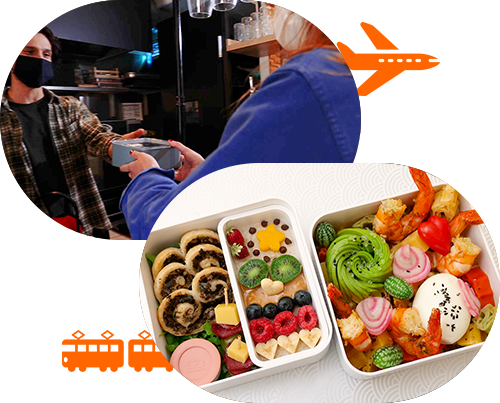
- BENTO TOPICS
- from Episode 12 / Season 6.
- France
-

Bento Topics. Today, from Paris, France. In this land of culinary delights, there's a new bento trend.
-
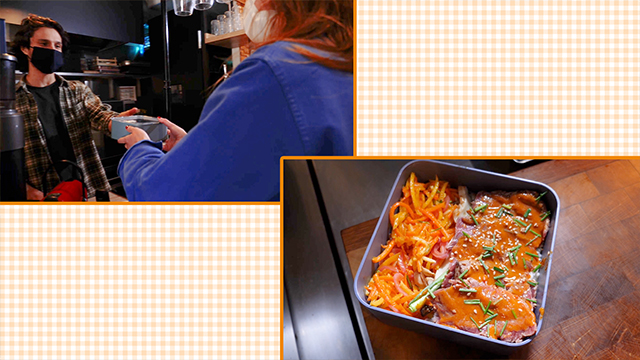
Restaurants are now starting to use reusable bento boxes to pack food to go. Customers can return the boxes at any one of the restaurants supporting this latest initiative to reduce waste.
-
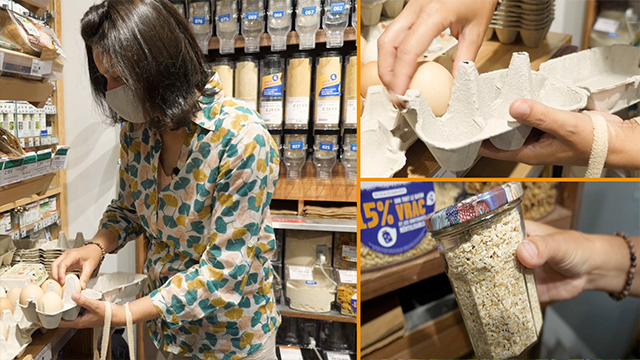
Bento maker Muriel is a designer who fell in love with bentos 20 years ago. She’s highly eco-conscious and always bring her own egg cartons and glass jars to buy food from package-free stores.
-
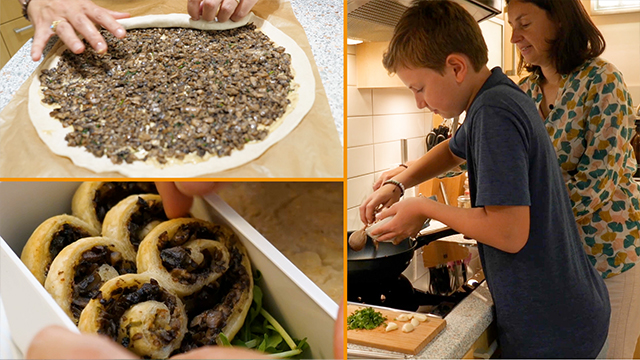
Today, she’s going to make a bento with her son, Mahé. She’s making palmiers, French pies with a distinctive heart shape. She spreads a rich filling of mushrooms and herbs over the dough and rolls both sides towards the center. She then slices up the roll and bakes these slices in the oven.
-
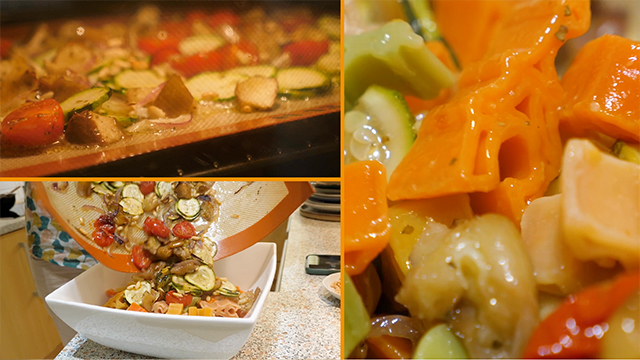
Next, a colorful pasta salad made with Eiffel Tower-shaped pasta and an assortment of grilled vegetables, including zucchini, tomatoes, and eggplant.
-
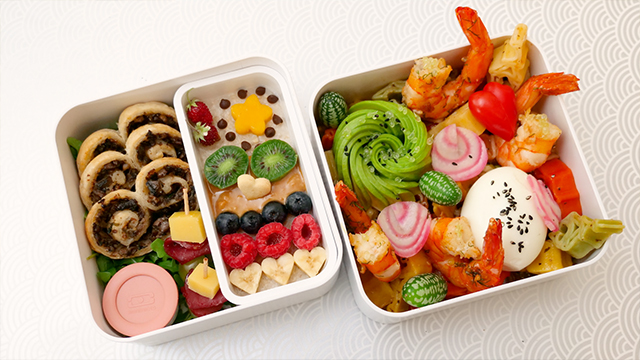
And for dessert, oatmeal topped with a variety of fruits. She adds grilled shrimp, avocado flowers, and beets with a cute spiral pattern to finish off her colorful and elaborate French bento!
-
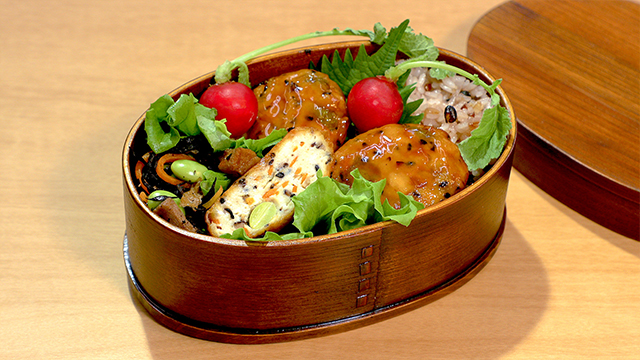
- BENTO RECIPES
- from Episode 11 / Season 6.
- Ganmodoki Bento
- (618 kcal)
-
 by Marc Matsumoto
by Marc Matsumoto
Bento contents:
- Ganmodoki
- Hijiki, abura-age, carrots, and edamame
- Rice with 16 grains/seeds
- Radishes with small leaves
- Small shiso leaf
- Frill lettuce
Ingredients:
For Ganmodoki
Makes 6 Ganmodoki
- 350 g firm tofu
- 1 tbsp potato starch
- 1 tsp sugar
- 1/4 tsp salt
- 30 g carrot (julienned)
- 50 g shiitake mushrooms (diced)
- 50 g shelled edamame
- 2 tsp black sesame seeds
For Sauce
- 4 tbsp konbu (kelp) dashi
- 2 tbsp 3S sauce (equal parts soy sauce, sake, sugar)
- 1/2 tsp potato starch
Directions:
For Ganmodoki
1. Crumble the tofu into a clean dish towel or butter muslin and squeeze the excess water out. You should end up with about 300 grams of tofu.
2. Put the tofu into a bowl with the potato starch, sugar, and salt. Knead the mixture together using a spatula until it is smooth and free of lumps.
3. Put the carrots and shiitake mushrooms in a bowl, and cover with a microwave-safe lid. Cook in a microwave oven set at 800 W for two minutes.
4. Add the carrots, shiitake, edamame, and sesame seeds to the tofu and stir until combined.
5. Shape the mixture into 6 egg-shaped patties.
6. Preheat 2 inches (5 cm) of vegetable oil to 340 degrees F (170 degrees C). Prepare a paper towel-lined rack.
7. Deep fry the ganmodoki until golden brown on the outside (about 5-6 minutes), flipping them over several times once the surface has set to ensure they brown evenly.
8. When the ganmodoki are done, transfer them to the prepared rack to drain.
9. To make the sauce, add the dashi, 3S sauce, and potato starch to a frying pan and stir to dissolve the starch. Put the pan over high heat and bring the sauce to a boil.
10. Once the sauce has thickened, add the ganmodoki and roll them around in the sauce to coat.
-
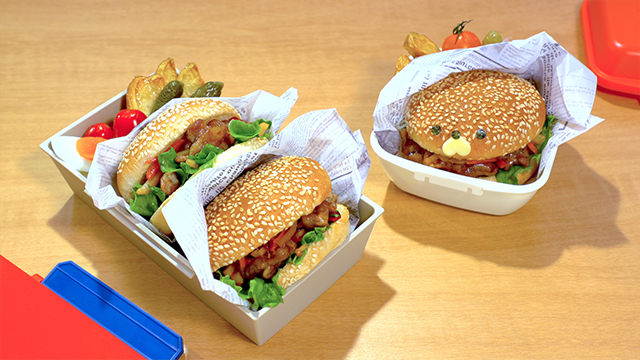
- BENTO RECIPES
- from Episode 11 / Season 6.
- Pork Kinpira Burger Bento
- (For adults 671 kcal, For kids 314 kcal)
-
 by Maki Ogawa
by Maki Ogawa
Bento contents:
- Pork Kinpira Burgers
- Cherry tomatoes
- Boiled eggs
- Cucumber pickles
- French fries
Ingredients:
For Pork Kinpira Burger
- 100 g pork shoulder loins scraps
- 130 g potato
- 50 g carrot
- A pinch of potato starch
- A pinch each of salt and pepper
- 3S sauce (1.5 tbsp each of sugar, sake, soy sauce), as needed
- Sliced dried red chili, as needed
- A dash of vegetable oil
- 4 burger buns
- Lettuce
- Mayonnaise
For the seal cub decoration
- Cheese
- Nori
- Mayonnaise
Directions:
For Pork Kinpira Burger
1. Cut the potato and carrot into thick matchsticks.
2. Season the pork with salt and pepper and dredge in potato starch.
3. Add the oil to the pan and stir-fry the pork to an even, light brown.
4. Add the carrot and potato and continue frying until slightly wilted. Add the 3S sauce and turn up the heat to high to boil the sauce, then reduce to medium and then low heat to glaze. Remove a portion for the kid’s bento. Sprinkle the chili over the rest.
5. Toast the buns and slice in half. Spread with mayonnaise to season and to keep the buns from getting mushy from the lettuce.
6. Top with lettuce and add more mayonnaise to taste.
7. Fill the buns with kinpira cooled to room temperature.
For the seal cub decoration
1. Use a heart-shaped cookie cutter to cut out the nose from the cheese.
2. Use nori for the eyes and nose.
3. If the nori won’t stick to the buns, use mayonnaise as glue.
-
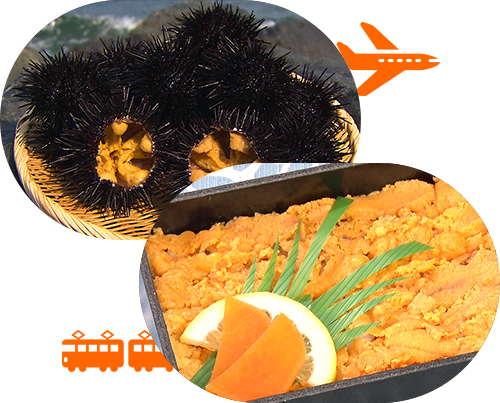
- BENTO TOPICS
- from Episode 11 / Season 6.
- Iwate
-

Bento Topics. Today, from Iwate Prefecture in northern Japan. The Sanriku Coast, with its rocky cliffs, boasts stunning views.
-
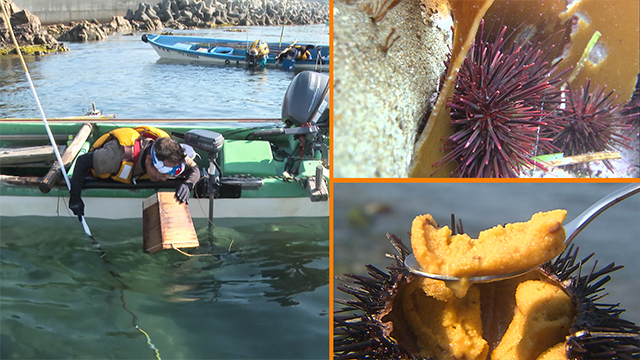
One of the most famous of its local specialities is uni, or sea urchin. The spiny black shells contain a sweet and creamy delicacy. Uni feed on umami-rich konbu kelp, which is why they have such a rich flavor.
-

The Sanriku Railway Rias Line was rebuilt after the Great East Japan Earthquake. Located along the Rias Line is Kuji Station, which is famous for its specialty uni bento.
-
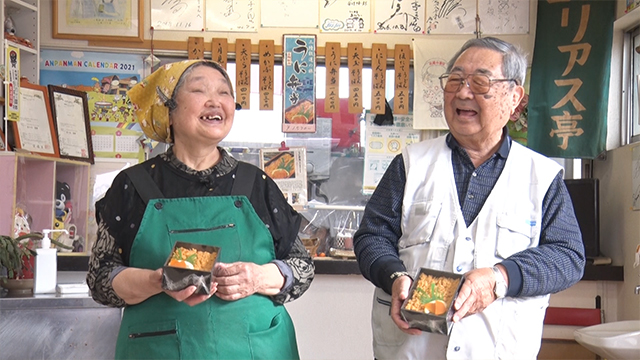
The Kudos started making the bento 35 years ago and began selling it on trains a year after the opening of the Sanriku Railway.
-
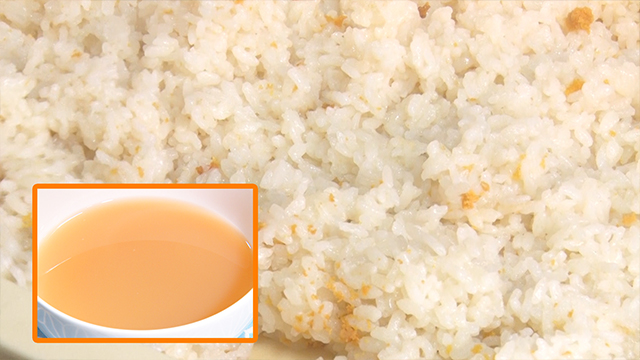
The secret to Mrs. Kudo's delicious bento lies in cooking the brine from pickled uni. She also mixes a generous amount of uni into the rice. Doing so means the cooked rice is rich with the uni's umami.
-
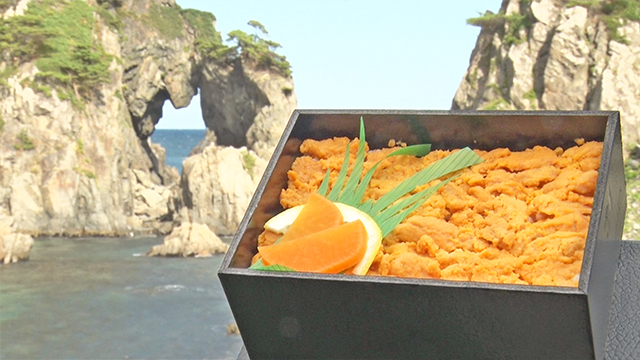
And finally, she completely covers the bed of rice with bite-size pieces of steamed uni. She uses as many as five sea urchins' worth just for the topping. A burst of uni flavor delights with every bite.
-
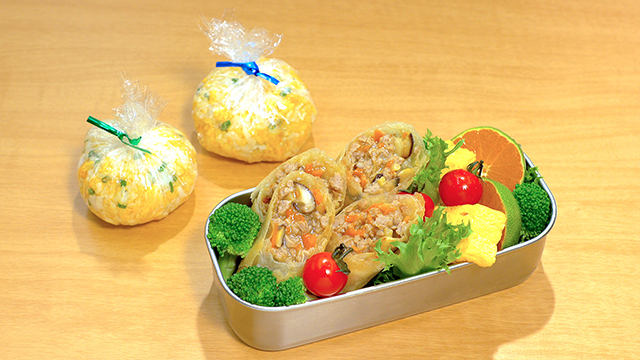
- BENTO RECIPES
- from Episode 10 / Season 6.
- Harumaki Bento
- (846 kcal)
-
 by Marc Matsumoto
by Marc Matsumoto
Bento contents:
- Harumaki
- Frill lettuce
- Aomikan
- Tamagoyaki
- Cherry tomatoes
- Broccoli
- Fried Rice Onigiri
Ingredients:
For Harumaki
Makes 6 spring rolls
- 150 g ground pork
- 1 tbsp soy sauce
- 1 tbsp mirin
- 5 g ginger, grated
- 1 tsp toasted sesame oil
- 2 tsp potato starch
- 1/2 cup (120 ml) chicken stock
- 1 tbsp potato starch
- 1 tbsp vegetable oil
- 50 g carrots, julienned
- 50 g bamboo, julienned
- 25 g shiitake, roughly chopped
- 6 spring roll wrappers
- About 1 tbsp flour and 1 tbsp water for the "glue"
- Vegetable oil (for deep-frying)
Directions:
For Harumaki
1. Add the soy sauce, mirin, ginger, sesame oil, and 2 teaspoons of potato starch to the ground pork, and stir with chopsticks to combine.
2. Dissolve the potato starch in the chicken stock and set aside.
3. In a frying pan over medium-high heat, add the vegetable oil, carrots, and bamboo, and stir-fry until the carrots start to wilt.
4. Add the marinated ground pork and break it up into small pieces using a spatula.
5. When the pork is cooked through, mix the chicken stock and starch mixture and pour it into the pan. Stir the filling until it has thickened up.
6. Transfer the filling to a metal bowl or tray and spread it out across the surface of the container.
7. Once the filling has cooled to room temperature, stir the flour and water together into a paste.
8. Spread a spring roll wrapper on a clean work surface with one corner pointing towards you.
9. Divide the filling mixture into 6 segments and spoon one segment of filling into a spring-roll-shaped strip in the bottom center of the wrapper.
10. Roll the bottom corner over the filling and continue rolling just past the center of the wrapper. Fold the left and right flaps of the wrapper over the top of the roll, and then spread some of the flour paste along the top edges of the wrapper like you're gluing an envelope shut.
11. Loosely roll the remainder of the wrapper, leaving about a finger's width of space between wrapper layers.
12. To fry the spring rolls, preheat a pot with 2 inches of oil to 340 degrees F (170 degrees C).
13. Add the spring rolls to the hot oil and fry until the wrappers have crisped, rolling them over a few times to ensure they brown evenly.
14. Drain and cool the spring rolls to room temperature on a paper towel-lined rack before packing them into your bento.
-
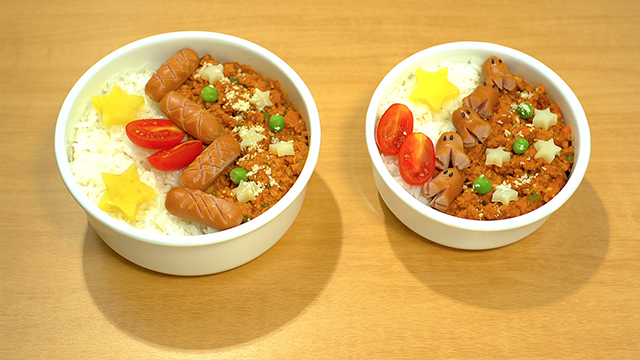
- BENTO RECIPES
- from Episode 10 / Season 6.
- Soy Meat Dry Curry Bento
- (For adults 753 kcal, For kids 525 kcal)
-
 by Maki Ogawa
by Maki Ogawa
Bento contents:
- Rice (250 g for adults, 180 g for kids)
- Soy Meat Dry Curry
- Sweet potato stars (boiled)
- Mini potato stars (boiled)
- A pinch of grated cheese
- Green peas
- Cherry tomatoes
- Cocktail sausages
- Sausage Aliens (for kids)
Ingredients:
For Soy Meat Dry Curry
- About 100 g dry soy meat flakes
- 40 g carrot
- 40 g green bell pepper
- 80 g onion
- 40 g mushrooms
- Seasoning
- 1 tbsp flour
- 2 tbsp curry powder
- 1 tsp salt
- A pinch of garam masala
- A pinch of chili powder
- A pinch of black pepper
- A pinch of garlic powder
- 200 ml tomato juice (unsalted)
- 100 ml water
- 2 tbsp ketchup
Directions:
For Soy Meat Dry Curry
1. Mince the carrot, bell pepper, onion, and mushrooms.
2. Reconstitute the soy meat flakes by soaking in warm water for about 5-10 minutes, or as instructed on the product, then squeeze out the excess moisture.
3. Oil a frying pan and sauté the soy meat and minced vegetables.
4. Once the vegetables are wilted, mix in the flour, salt, and spices.
5. Add the tomato juice, ketchup, and water. Simmer until the liquid evaporates.
To make the Sausage Aliens
1. Cut each sausage in half and make 3-4 slits on the cut surface to form the legs.
2. Cut a straw in half and use the sharp edge to make a slit for the mouth. Boil for 30 seconds.
3. Add black sesame seeds for the eyes.

-
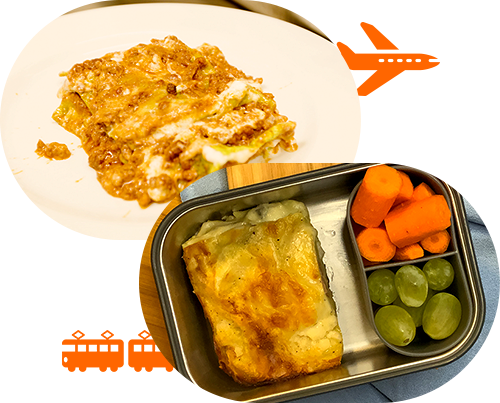
- BENTO TOPICS
- from Episode 10 / Season 6.
- Italy
-

Today, from Milan, the largest city in northern Italy. Its landmark, the Milan Cathedral, is one of the world’s largest Gothic buildings.
-
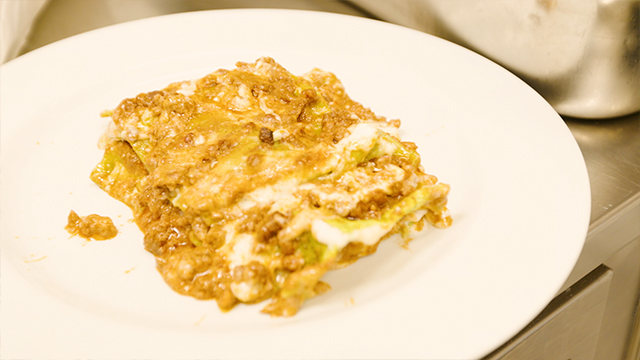
Lasagna is made by layering thin sheets of pasta, sauce, and cheese. It's the ultimate comfort food in Italy. Northern Italy has its own style of traditional lasagna.
-
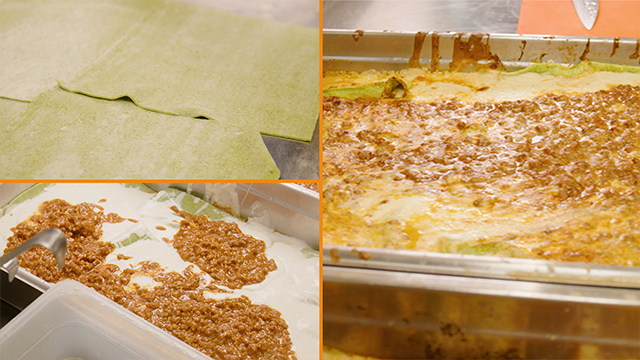
The traditional way of making lasagna in this region is to knead leafy greens like spinach into the pasta dough. The thin sheets of pasta are covered with a creamy bechamel sauce and a rich ragu and sprinkled with cheese. This is repeated several times to form layers. The lasagna is then baked in the oven.
-
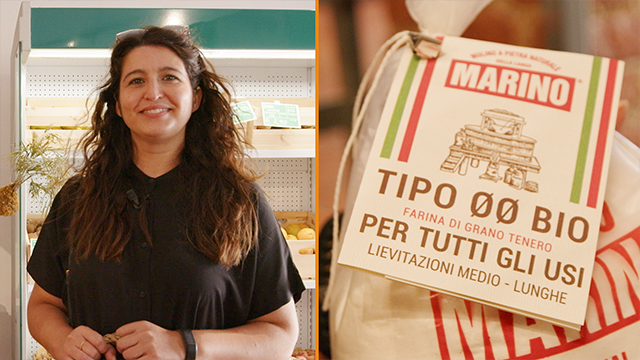
Marcella began making bentos ten years ago. She loves including lasagna in her bentos. She uses finely ground 00 zero flour to make silky and chewy pasta.
-
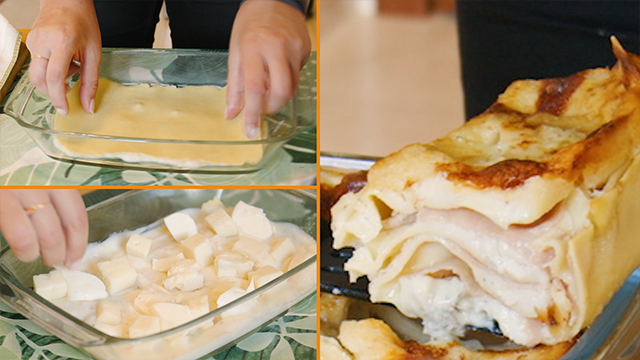
Today, she makes a lasagna with four Italian cheeses—mozzarella, fontina, gorgonzola, and Parmigiano Reggiano. Her recipe also calls for bechamel sauce and ham.
-
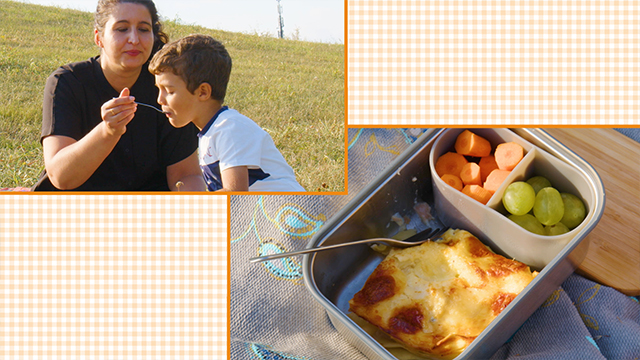
A lasagna bento featuring a rich combination of four of Italy’s most famous cheeses and silky pasta. It’s her nephew, Niccolò’s favorite!
-
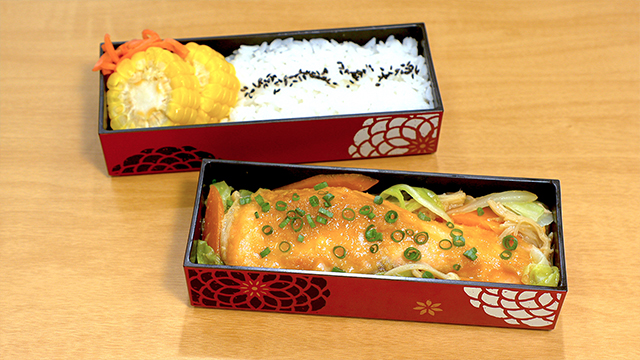
- BENTO RECIPES
- from Episode 9 / Season 6.
- Miso-butter Salmon Bento
- (592 kcal)
-
 by Marc Matsumoto
by Marc Matsumoto
Bento contents:
Makes enough to pack into 2 bentos
Bento contents:
- Miso-butter Salmon
- Rice
- Black sesame seeds
- Yellow corn
- Benishoga (Pickled red ginger)
Ingredients:
For Miso-butter Salmon
- Miso-butter
- 2 tbsp miso
- 1 1/2 tbsp butter, at room temperature
- 1 1/2 tsp sugar
- 2 small salmon fillets, 200 g
- 1 tbsp vegetable oil
- 150 g cabbage, cut into strips
- 50 g onion, sliced
- 50 g carrot, sliced
- 50 g enoki, trimmed off
- 2 tbsp sake
- 1 scallion, chopped for garnish
Directions:
For Miso-butter Salmon
1. Whisk the miso, butter, and sugar together until smooth.
2. Split the miso-butter between the two salmon fillets and spread it out evenly.
3. In a deep frying pan with a lid, add the vegetable oil, cabbage, onions, carrots, and enoki. Stir-fry the vegetables over medium heat until they're vibrant in color and starting to wilt.
4. Place the salmon fillets on top of the vegetables and then pour the sake over the vegetables. Immediately cover the pan with a lid and turn down the heat to low. Let this steam for 6 minutes or until the salmon is cooked through and flakes easily.
5. Garnish with chopped scallions.
-
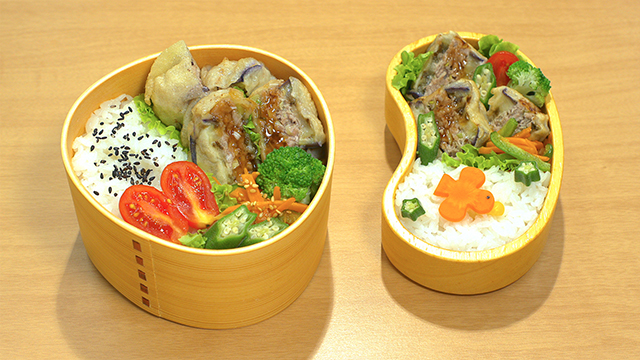
- BENTO RECIPES
- from Episode 9 / Season 6.
- Fried Stuffed Nasu Bento
- (For adults 754 kcal, For kids 297 kcal)
-
 by Maki Ogawa
by Maki Ogawa
Bento contents:
- Rice (260 g for adults, 80 g for kids)
- Fried Stuffed Nasu
- Green Bell Pepper and Carrot Kinpira
- Broccoli
- Cherry tomatoes
- Okra
- Lettuce
- Black sesame seeds (for adults)
- Carrot Birdie (for kids)
Ingredients:
For Fried Stuffed Nasu
- 2 eggplants
- 100 g ground pork
- 50 g Japanese leek
- 1 tbsp water
- Salt and pepper, as needed
- Vegetable oil for deep frying, as needed
- Batter
- 30 g flour
- 10 g potato starch
- 3 tbsp water
- Sauce (to taste)
- 3S sauce (equal parts soy sauce, sake, sugar), as needed
- Potato starch thickener, as needed
For the Green Bell Pepper and Carrot Kinpira
- 3 green bell peppers
- 60 g carrot
- A pinch of white sesame seeds
- A dash of sesame oil
- A pinch of granulated chicken soup
- A dash of sake
- A pinch of pepper
For the Carrot Birdie
- Carrot
- Sweet corn kernel
- Nori
Directions:
For Fried Stuffed Nasu
1. Use a vegetable peeler to peel the eggplant in stripes. Cut into 8 mm slices and soak in water.
2. Combine the ground pork, minced leek, water, salt, and pepper in a bowl and knead well. Form into small meatballs.
3. Drain the eggplant slices. Place a meatball on one slice and cover with another slice to form a sandwich.
4. Combine the flour, potato starch, and water to make the batter.
5. Dip the eggplant sandwiches in the batter.
6. Heat the oil to 170 degrees C and fry the eggplant.
7. If desired, serve with simmered 3S sauce thickened with potato starch.
For the Green Bell Pepper and Carrot Kinpira
1. Cut the carrot and bell peppers into thin strips. Sauté in sesame oil.
2. Add the granulated chicken soup, pepper, and sake, and sauté until tender.
3. Sprinkle with white sesame seeds.
To make the Carrot Birdie
1. Use a four-petal flower cutter to cut out the carrot.
2. Trim one of the petals. Add the corn and nori for the beak and eye.

-
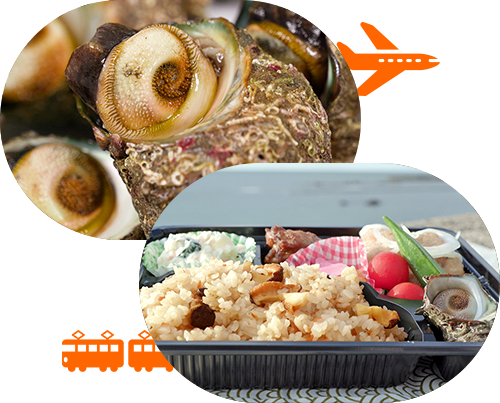
- BENTO TOPICS
- from Episode 9 / Season 6.
- Daisen
-
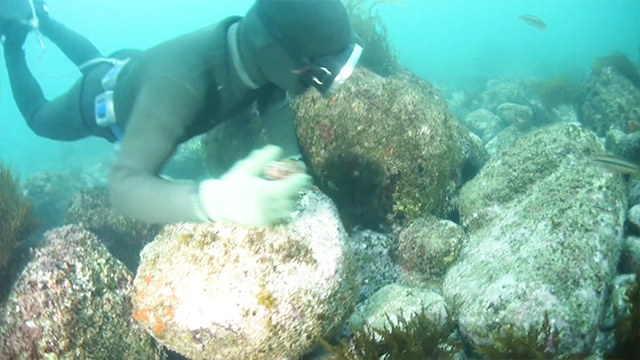
Today, from Daisen in Tottori Prefecture which faces the Sea of Japan.
It has a thriving fishing industry. Some fishers go freediving for shellfish. -
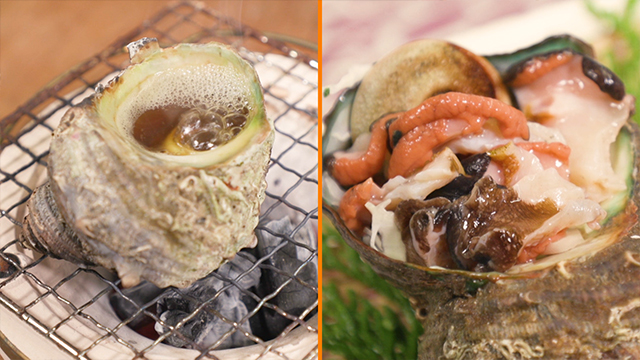
The local specialty is sazae, or turban shell, which has a briny scent and crunchy texture similar to abalone. Sazae are typically grilled in their shell or eaten as sashimi.
-
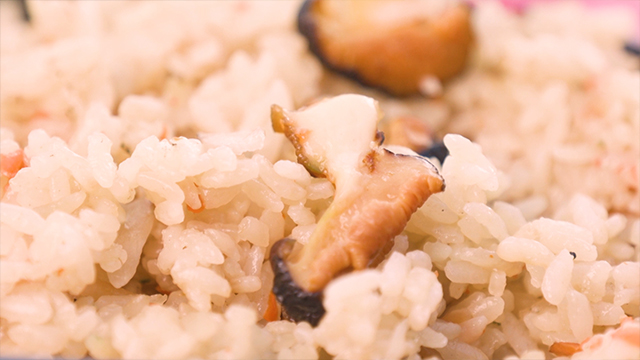
But in this town, people recommend sazae-meshi. This is an umami-rich mixture of rice and sazae cooked in dashi and seasoned with soy sauce. It’s a traditional dish that’s been handed down through generations of fishers.
-
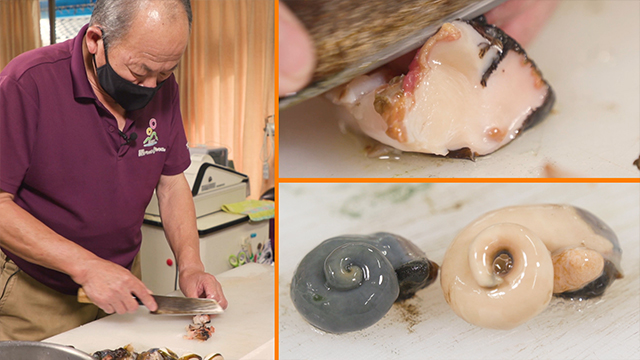
Kanetani is a fish wholesaler who uses a traditional family recipe to make his specialty sazae-meshi bento. The swirl-shaped innards have a rich, bitter taste and briny scent.
-
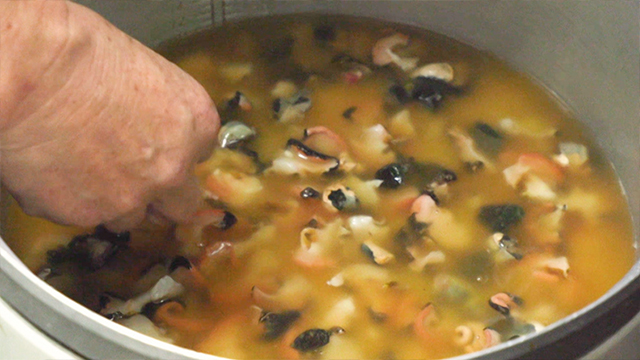
He adds the dashi and sazae, innards and all, to the rice. He also includes carrot and gobo burdock root to make a sazae-meshi that's bursting with umami.
-
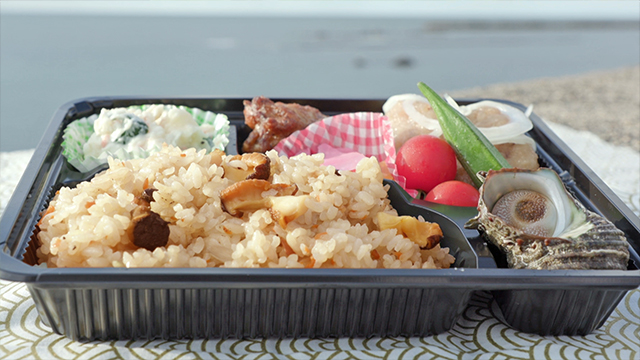
The sazae-meshi in Kanetani's bento is a family recipe passed down from his great-grandmother.
The bento also features sazae grilled in their shell.
-
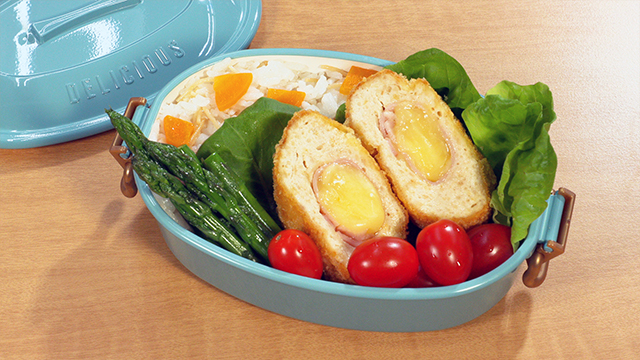
- BENTO RECIPES
- from Episode 8 / Season 6.
- Chicken Cordon Bleu Bento
- (713 kcal)
-
 by Marc Matsumoto
by Marc Matsumoto
Bento contents:
Makes enough to pack into 4 bentos
Bento contents:
- Chicken Cordon Bleu
- Rice pilaf
- Asparagus
- Small cherry tomatoes
- Leaf lettuce
Ingredients:
For Chicken Cordon Bleu (Makes 4 pieces)
- 390 g ground chicken
- 20 g panko
- 1 small egg
- 1/2 tsp salt
- 50 g Gouda cheese, cut into 4 pieces
- 2 slices thick-cut ham
- For breading
- 4 tbsp flour
- 1 egg, beaten
- 40 g panko
- Vegetable oil, for frying
For Rice pilaf
- 1 tbsp butter
- 10 g vermicelli (broken into small pieces)
- 25 g carrots
- 25 g onions
- 150 g short grain rice (washed and drained)
- 270 ml chicken stock (1 US cup + 2 tbsp)
- Salt to taste
Directions:
For Chicken Cordon Bleu
1. Add the chicken, panko, egg, and salt to a bowl, and knead together by hand until the mixture is uniform in color.
2. Divide the chicken mixture into 4 parts.
3. Spread 1/4 of the mixture onto a sheet of plastic wrap. Form the mixture into a rectangular shape, about 13 x 10 cm (5 x 4 in) in size.
4. Wrap a piece of cheese with the ham, and then place it on the right side of the chicken.
5. Fold the left half of the chicken over the ham and cheese using the plastic wrap, then remove the plastic wrap. Press out any air around the cheese and shape the patty by hand.
6. Place the patty in the flour and roll around to coat evenly. Repeat with the rest of the chicken.
7. To bread the chicken, coat it in egg, then shake it in a bowl of panko to coat evenly with breadcrumbs.
8. Preheat 5 cm (about 2 inches) of vegetable oil to 340 degrees F (170 degrees C) and prepare a wire rack by lining it with paper towels.
9. Fry the Chicken Cordon Bleu until the panko is golden brown and the patty has puffed up. Drain it on a rack until it cools slightly before cutting it in half to pack it into your bento.
For Rice pilaf
1. Add the butter and broken vermicelli into a pot over medium heat, and fry the pasta until golden brown.
2. Add the carrots and onions and sauté for 1 minute.
3. Add the rice and chicken stock and season with salt to taste. Bring the liquid to a boil.
4. Cover the pot with a lid and turn down the heat as low as it will go. Set the timer for 12 minutes.
5. When the timer goes off, turn off the heat and let the rice steam for another 12 minutes.
6. Fluff the rice when it's done.
-
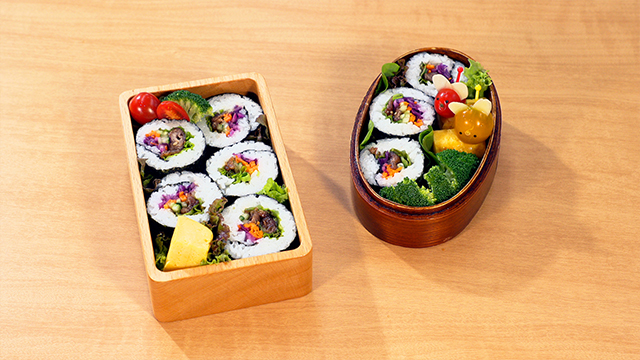
- BENTO RECIPES
- from Episode 8 / Season 6.
- Yakiniku Norimaki Bento
- (For adults 607 kcal, For kids 397 kcal)
-
 by Maki Ogawa
by Maki Ogawa
Bento contents:
- Yakiniku Norimaki
- Tamagoyaki (Japanese rolled omelet)
- Broccoli
- Cherry tomatoes
- Tomato mini mice (For kid’s decoration)
Ingredients:
For Yakiniku Norimaki (yields 2 rolls)
- 360 g cooked rice
- 80 g yakiniku (beef stir-fried with 3S sauce)
- 100 g beef trimmings
- 1. 5 tbsp 3S sauce (1 tsp each of sugar, sake, and soy sauce)
- White sesame seeds, as needed
- A pinch of potato starch
- A dash of vegetable oil for stir-frying
- 15 g Red Cabbage Namul
- Red cabbage, as needed
- A pinch of granulated chicken soup
- A dash of sesame oil
- A pinch each of salt and pepper
- 15 g quick pickled carrots
- Carrots, as needed
- A pinch of salt
- A dash of sushi vinegar
- 15 g cucumber
- 2 leaves lettuce
- 2 full sheets nori
- A pinch of white sesame seeds
For tomato mini mice
- 2 cherry tomatoes
- 4 slices roasted almonds
- Nori
Directions:
For Yakiniku
1. Dredge the beef trimmings in potato starch and stir-fry in an ample amount of oil. Once the beef is browned, coat with 3S sauce and sprinkle with sesame seeds.
For vegetable fillings
Red Cabbage Namul
1. Cut the red cabbage into 5 mm strips and blanch for 30 seconds.
2. Soak in ice water and squeeze out the excess moisture.
3. Season with granulated chicken soup, sesame oil, salt, and pepper.
Quick pickled carrots
1. Cut the carrot into fine strips. Massage with salt and rinse. Soak in sushi vinegar.
Cucumber
1. Cut the cucumber in half and then into matchsticks.
For Yakiniku Norimaki
1. Place a sheet of nori on the makisu mat. Spread 180 g of rice evenly over the nori, leaving a 2 cm strip of rice on the far end.
2. Lay the fillings across in a line that’s slightly closer to you and roll up.
3. Let the roll rest for a while.
4. Use a dampened knife to saw the roll into bite-size pieces.
5. Sprinkle with sesame seeds.
To make the tomato mini mice
1. Make two slits on the top of each tomato, and insert the sliced almonds for the ears. Cut out the eyes and nose from the nori. Use cocktail picks for the tail.
-

- BENTO TOPICS
- from Episode 8 / Season 6.
- Trinidad and Tobago
-

Bento Topics. Today, from the Caribbean nation of Trinidad and Tobago, the birthplace of the steelpan. It's a percussion instrument originally made from oil drums.
-

Chili peppers, ranging in strength from sweet to burning hot, are a huge part of Trinidadian cuisine. That’s why there are so many varieties of pepper sauces to choose from at local supermarkets.
-
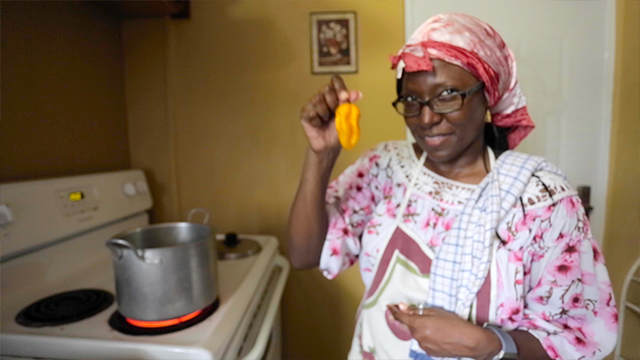
Bento maker Stacey is a school teacher. She’s going to make a bento of traditional Trinidadian Sunday lunch dishes for her younger brother.
-
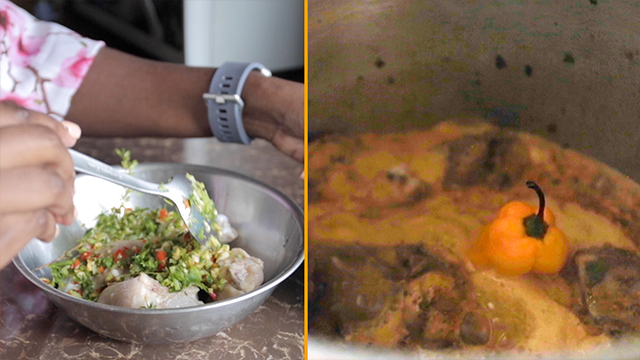
She starts off by marinating chicken in a homemade seasoning of chili peppers,herbs and spices. She then braises the chicken in brown sugar, coconut milk, and super spicy Scotch Bonnet peppers to prepare Trinidad-style stewed chicken. Its rich and complex flavors make it a Sunday lunch favorite.
-
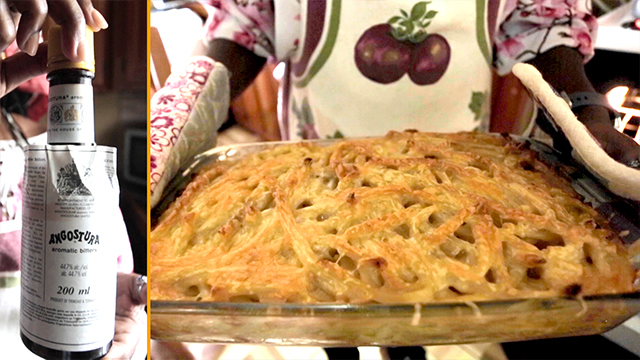
Next up is a macaroni pie. The boiled macaroni is combined with a creamy sauce of milk, eggs, Worcestershire sauce, and a famous local alcohol, bitters. Topped with a sprinkling of cheese, the macaroni is baked in the oven.
-
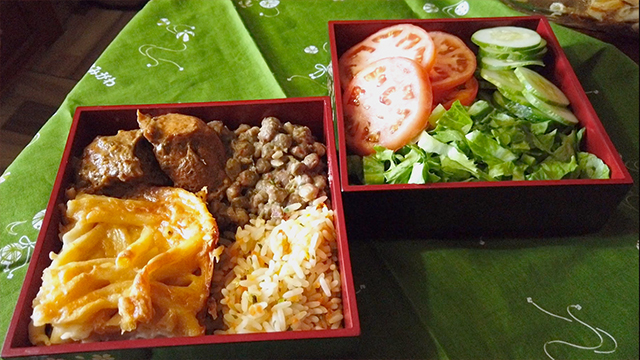
A delicious Trinidadian Sunday lunch bento of stewed chicken, stewed beans, macaroni pie, vegetable fried rice, and salad!
-
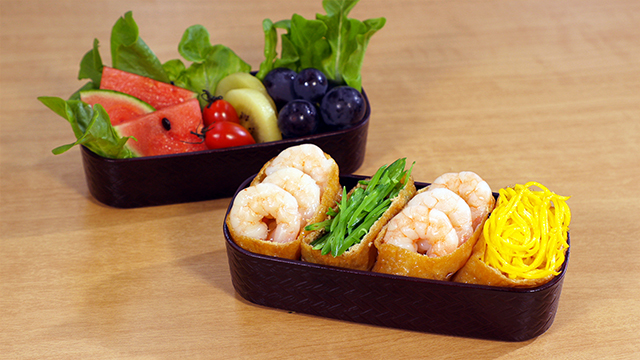
- BENTO RECIPES
- from Episode 7 / Season 6.
- Coloful Inari-sushi Bento
- (757 kcal)
-
 by Marc Matsumoto
by Marc Matsumoto
Bento contents:
Makes enough to pack into 2 bentos
Bento contents:
- Inari-sushi
- Watermelon
- Grapes
- Frill lettuce
- Small cherry tomatoes
- Golden kiwi
Ingredients:
For Colorful Inari-sushi
- 1 rice cooker cup rice
- 140 g shrimp (peeled and deveined)
- 1 tsp baking soda
- 2 1/2 tbsp sushi vinegar
- 40 g cooked and shelled edamame
- 25 g carrot, quartered and cut into 2 mm-thick slices
- 25 g small sugar peas, trimmed
- 2 tsp black sesame seeds
- 1 egg
- 1 small pinch salt
- 1/4 tsp oil
- 8 inari wrappers
Directions:
For Colorful Inari-sushi
1. Cook the rice according to your rice cooker's instructions, but reduce the amount of water by 1 tablespoon.
2. Add the baking soda to the shrimp and mix; let this sit for 5 minutes. Then, rinse the shrimp to remove the excess baking soda.
3. Bring a pot of salted water to a boil. Add the carrots and boil until tender.
4. Add the shrimp and boil until the shrimp are cooked through.
5. Add the sugar peas and cook for 20-30 seconds. Drain the carrots, shrimp, and sugar peas, and dump them into a bowl of cold water to chill them rapidly. Drain and separate the ingredients.
6. When the rice is done, dump it into a large bowl and then drizzle with sushi vinegar. Fold the vinegar into the rice until combined. Add the cooked carrots, edamame, and black sesame seeds, then fold them into the rice. Use a fan to cool the rice to room temperature.
7. Beat the egg together with a pinch of salt.
8. Pour the vegetable oil into a non-stick frying pan, and use a paper towel to spread it around in a thin, even layer. Heat the pan over medium-low heat, and then add the egg mixture. Swirl around to coat the bottom of the pan evenly.
9. When the egg is mostly cooked through, peel up an edge and then flip it over.
10. When the egg is cooked through, transfer it to a cutting board and then roll it up. Next, use a sharp knife to slice it into thin threads.
11. Slice the sugar peas into thin strips.
12. To make the inari-sushi, spread open the cut side of the inari wrapper to make a pocket. Then, use a narrow spoon to pack 1/8 of the sushi rice mixture into the pocket. Repeat with the remaining wrappers.
13. Pack the partially filled inari-sushi into your bento box.
14. Top the inari with the shrimp, sugar peas, and egg.
-
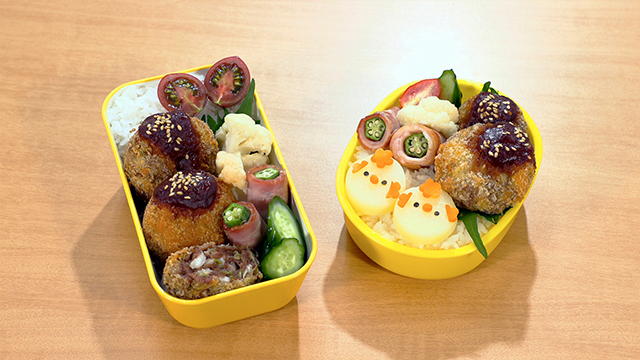
- BENTO RECIPES
- from Episode 7 / Season 6.
- Cabbage Menchi-katsu Bento
- (For adults 662 kcal, For kids 477 kcal)
-
 by Maki Ogawa
by Maki Ogawa
Bento contents:
- Cooked rice (220 g for adults, 130 g for kids)
- Cabbage Menchi-katsu
- Cucumber
- Cauliflower
- Bacon Okra Rolls
- Cherry tomatoes
- Baby Potato Chicks (decoration for kid’s bento)
Ingredients:
For Cabbage Menchi-katsu (yields 8-9 40 g menchi-katsu)
- 200 g mixed ground meat
- 150 g cabbage (massaged with salt, rinsed, and drained)
- A pinch of pepper
- 1. 5 tbsp flour
- Batter
- Flour, as needed
- 1 egg
- Panko, as needed
- Sauce
- Ketchup
- Worcestershire sauce
- Vegetable oil for frying, as needed
For Bacon Okra Rolls
- Okra
- Bacon
For the Baby Potato Chicks
- Potato
- Boiled carrot
- Nori
Directions:
For Cabbage Menchi-katsu
1. Cut the cabbage into 5 mm strips and massage with a pinch of salt. Squeeze out the excess moisture.
2. Combine the ground meat and cabbage, then season with pepper (no need to add salt as the cabbage has already been salted). Add the flour to bind, and knead well.
3. Form into 8-9 balls.
4. Dredge in flour, dip in beaten egg, and coat with panko. Fry for 4-5 minutes in oil heated to 170 degrees C.
5. Drizzle the katsu with the sauce, made by combining equal parts ketchup and Worcestershire sauce.
For Bacon Okra Rolls
1. Blanch the okra for about a minute, and wrap with bacon.
2. Fasten the seam with a toothpick, and pan-fry or broil.
To make the Baby Potato Chicks
1. Boil the potatoes and scoop out balls. Use boiled carrot for the beak, comb, and wings. Use nori for the eyes.
-
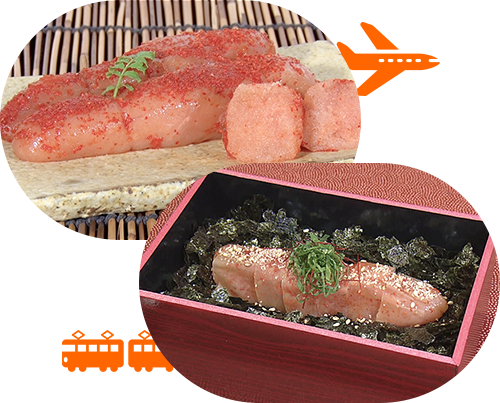
- BENTO TOPICS
- from Episode 7 / Season 6.
- Fukuoka
-
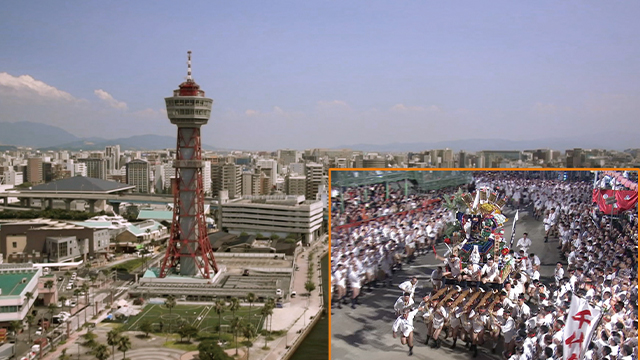
Today, from Fukuoka, the largest city in southwestern Japan. A city built by merchants, Fukuoka is well known for a long-held tradition: the Hakata Gion Yamakasa Festival.
-
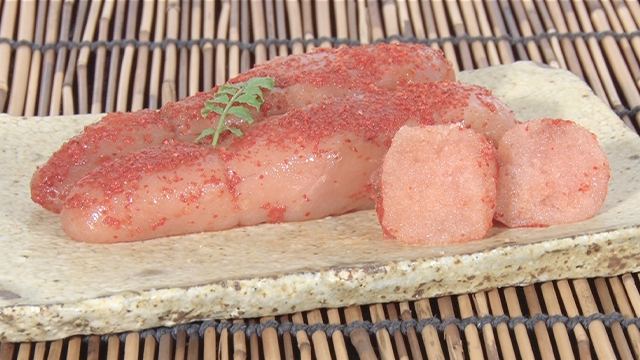
It’s also famous for Karashi Mentaiko, a delicacy of walleye pollock roe marinated in a spicy sauce. It combines the rich flavor of fish eggs with a spicy kick and a springy texture.
-
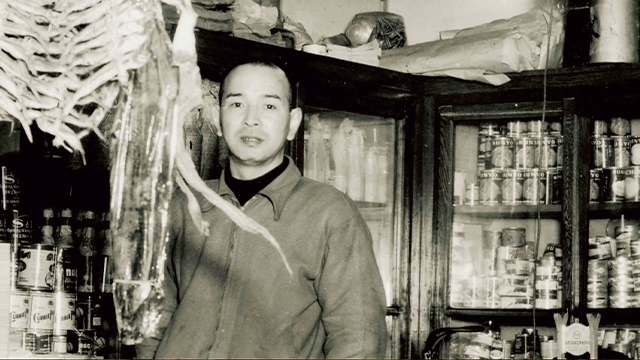
Karashi Mentaiko, or Spicy Mentaiko, was inspired by pollock roe kimchi, a traditional Korean dish. It was adapted to Japanese taste by Fukuoka merchant Kawahara Toshio, who shared his recipe with his fellow merchants. Today, it’s become Fukuoka’s foremost local specialty.
-
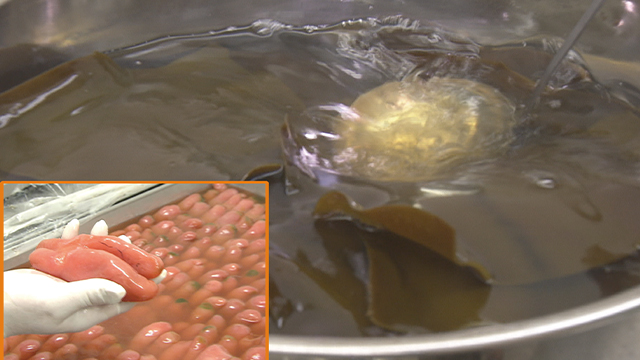
The key to making this spicy delicacy lies in marinating the pollock roe in an umami-rich stock extracted from konbu kelp.
-
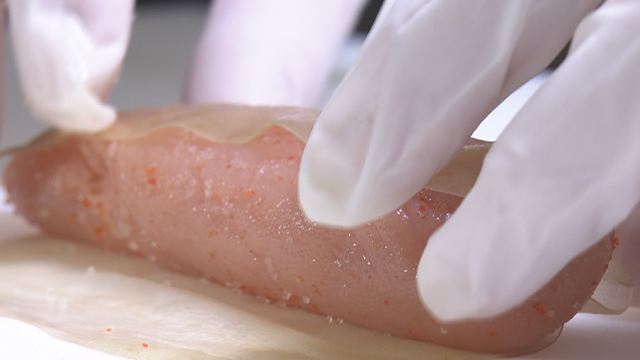
Today’s bento boosts the umami flavor of the Karashi Mentaiko by wrapping it in a sheet of konbu that’s been shaved so thinly that it’s translucent.
-
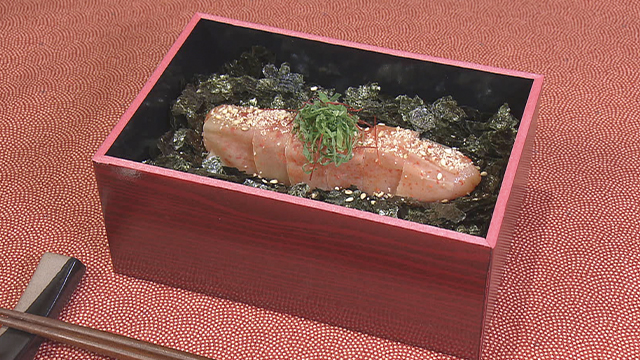
The umami-rich Karashi Mentaiko goes especially well with rice. The bento makes the most of this ideal combination by placing the fish eggs on a bed of rice covered with shredded nori. The result is a bento that’s bursting with flavor.
-
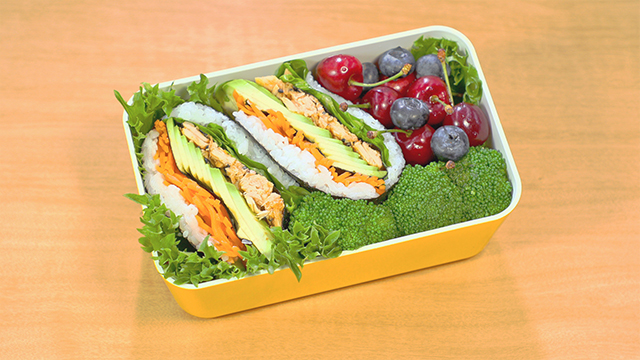
- BENTO RECIPES
- from Episode 6 / Season 6.
- Sushi Sandwich Bento
- (725 kcal)
-
 by Marc Matsumoto
by Marc Matsumoto
Bento contents:
Makes enough to pack into 2 bentos
Bento contents:
- Sushi Sandwich
- Broccoli
- Cherries
- Blueberries
- Frill lettuce
Ingredients:
For Sushi Sandwich
- Sushi rice
- 1 rice cooker cup rice (180 ml, cook according to the rice cooker instructions)
- 2 tbsp rice vinegar
- 1 1/2 tbsp sugar
- 1/2 tsp salt
- Spicy Tuna
- 140 g canned solid tuna in oil
- 2 tsp sriracha
- 1 tsp toasted sesame oil
- 1 tsp black sesame seeds
- Carrot Salad
- 100 g carrot (1 medium carrot, shredded)
- 1/4 tsp salt
- 1/2 tsp toasted sesame oil
- 1 avocado (halved, peeled, and thinly sliced)
- 4 lettuce leaves
- 2 full sheets nori
Directions:
1. Wash and cook the rice according to your rice cooker instructions.
2. To make the sushi vinegar, whisk the sugar and salt into the rice vinegar until they're dissolved.
3. When the rice is ready, drizzle the sushi vinegar evenly over the rice and fold it in while fanning to cool the rice.
4. Drain the can of tuna and lightly squeeze out any excess oil. Add it to a bowl along with the sriracha, toasted sesame oil, and black sesame seeds. Mix to combine.
5. Sprinkle the shredded carrots with 1/4 teaspoon salt and let them sit for 15 minutes to wilt them. Use your hands to squeeze out any excess liquid from the carrots and toss with 1/2 teaspoon of toasted sesame oil.
6. To assemble the sushi sandwich, place the nori with the shiny side down and use scissors to cut a slit halfway up the center.
7. Place the sliced avocado in the lower left quarter of the nori.
8. Place half of the tuna in the upper left quarter.
9. Spread a thin layer of sushi rice in the upper right and lower right quarters.
10. Spread half of the carrots on top of the rice on the upper right quarter.
11. Place two leaves of lettuce on top of the rice on the lower right quarter.
12. Fold the lower left quarter over the upper left quarter and continue folding clockwise.
-
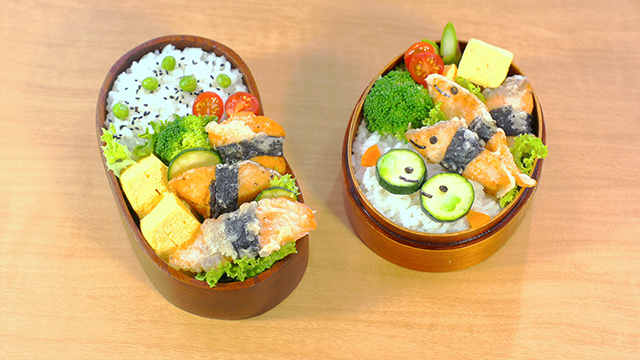
- BENTO RECIPES
- from Episode 6 / Season 6.
- Norimaki Salmon Fritter Bento
- (For adults 676 kcal, For kids 439 kcal)
-
 by Maki Ogawa
by Maki Ogawa
Bento contents:
- Cooked rice (210 g for adults, 120 g for kids)
- Norimaki Salmon Fritters
- Zucchini deep-fried without batter
- Asparagus
- Broccoli
- Tamagoyaki
- Cherry tomatoes
- Lettuce
- Green peas (for adults)
- Black sesame seeds (for adults)
- Zucchini fishies (for decorating the kid’s bento)
- Norimaki salmon fishies (for decorating the kid’s bento)
Ingredients:
For Norimaki Salmon Fritters
- 2 salmon fillets (approx. 150 g)
- 2 tbsp flour
- 2 tbsp potato starch
- 1 tbsp mayonnaise
- 2 1/2 tbsp soda water
- A pinch each of salt and pepper
- Nori, as needed
- Vegetable oil for deep frying, as needed
For the zucchini fishies
- 1 thin slice carrot
- 2 slices zucchini
- A piece of nori
- A piece of broccoli stalk
Directions:
For Norimaki Salmon Fritters
1. Cut the salmon into bite-size pieces and wrap each piece with a 1 cm-wide strip of nori.
2. Season with salt and pepper and dredge in flour.
3. Heat the oil to 170 degrees C.
4. Combine the flour, potato starch, mayonnaise, and cold soda water to make the fritter batter.
5. Dip the norimaki salmon in the batter and deep-fry for 2-3 minutes.
For the zucchini fishies
1. Cut the zucchini into 6-7 mm-thick slices and deep-fry without batter.
2. Cut a 5 mm-thick slice of carrot and boil.
3. Cut the carrot radially into six pieces and attach one each to the zucchini to form the tail fin.
4. Cut out the eyes and mouth from the nori. Shave the broccoli stalk for the fins.
For the Norimaki Salmon Fritter fishies
1. Cut out the eyes and mouth from the nori and place on the fritters.
-
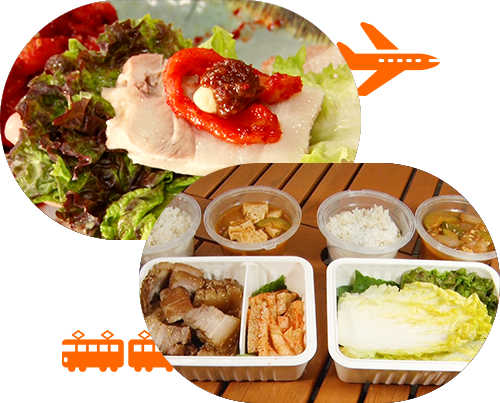
- BENTO TOPICS
- from Episode 6 / Season 6.
- South Korea
-
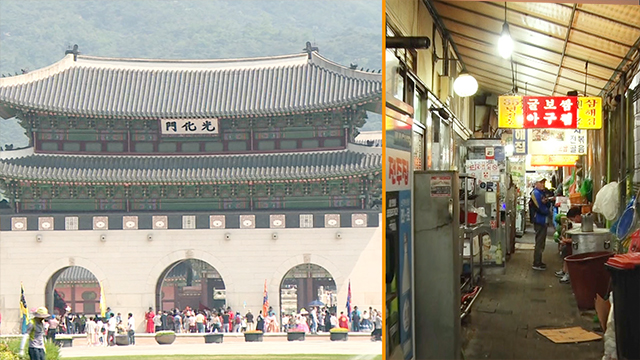
Bento Topics. Jongno is a district in central Seoul, the capital of South Korea. There’s an alley here that is a favorite with foodies because of its many eateries that specialize in Bossam.
-
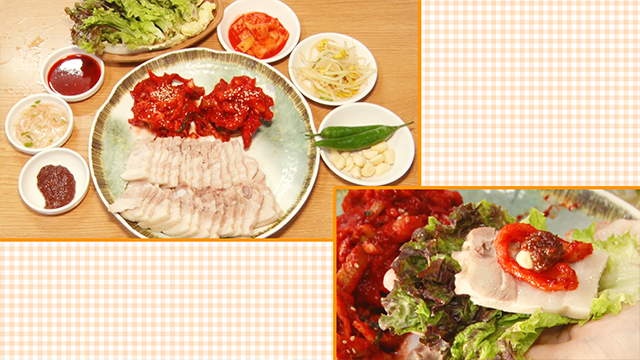
Bossam is popular dish of spicy boiled pork and a choice of fillings and condiments wrapped in salad leaves. The “ssam” in Bossam means “to wrap.”
-
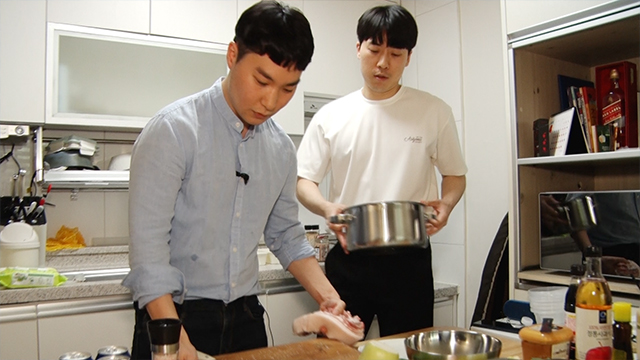
Alfie began making bentos amid the outbreak of COVID-19. With the help of his friend Ade, he’s going to try his hand at making his very first Bossam bento.
-
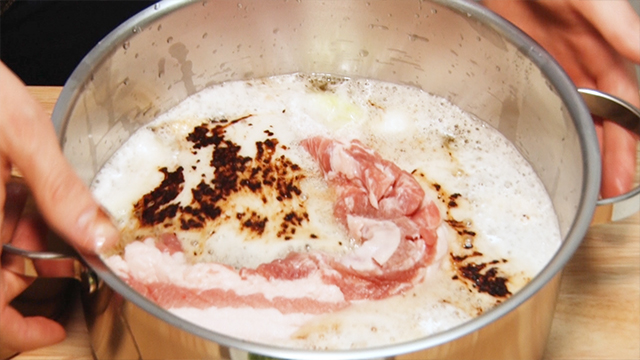
He uses beer to tenderize and boil the pork. He also adds onions, garlic, sugar, Korean miso, and instant coffee to season the pork.
-
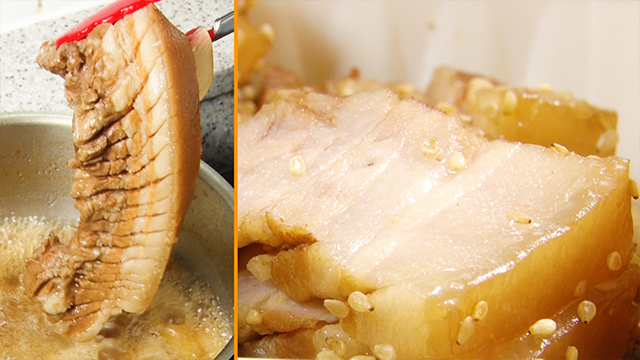
After 90 minutes, the pork is tender enough to melt in the mouth. It's steeped with the flavor of the broth. He got the idea of using beer and instant coffee from the Internet.
-
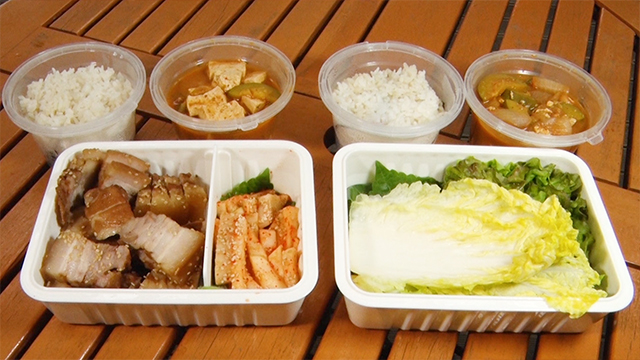
He packs the pork, daikon kimchi, and the Korean lettuce and perilla leaves for use as wrappers.
He also makes a traditional Korean soybean paste stew to go with his Bossam bento. Well done!
-
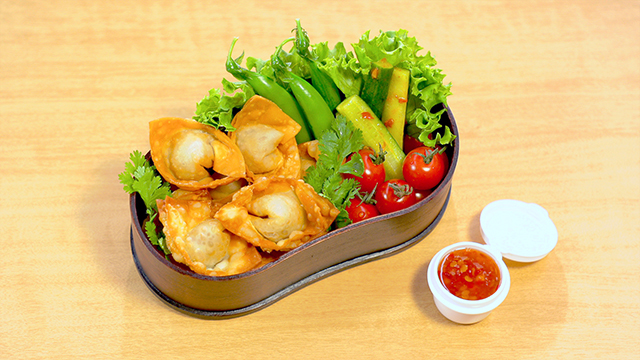
- BENTO RECIPES
- from Episode 5 / Season 6.
- Fried Wonton Bento
- (357 kcal)
-
 by Marc Matsumoto
by Marc Matsumoto
Bento contents:
Makes enough to pack into 3 bentos
Bento contents:
- Fried Wonton
- Lettuce
- Spicy Cucumbers
- Cherry tomatoes
- Snap peas
- Cilantro
- Thai sweet chili sauce (for dipping)
Ingredients:
For Fried Wonton
- 75 g shrimp (peeled, deveined, and roughly chopped)
- 75 g ground pork
- 15 g scallions (minced)
- 2 tsp oyster sauce
- 1 tsp Shaoxing wine
- 1 tsp sesame oil
- 2 tsp potato starch
- 30 wonton wrappers
For Spicy Cucumbers
- 1 cucumber (cut into thirds and then quartered lengthwise)
- 1/4 tsp salt
- 1/2 tsp doubanjiang
- 1/2 tsp sesame oil
Directions:
For Fried Wontons
1. Add the shrimp, pork, scallions, oyster sauce, Shaoxing wine, sesame oil, and potato starch to a bowl, and mix together well with a spatula.
2. Prepare a bowl of water. Start heating a pot with 2-inches of vegetable oil to 340 degrees F (170 degrees C).
3. Put a wonton wrapper in the palm of your non-dominant hand and add a teaspoon of filling to the center of the wrapper.
4. Wet your finger in the bowl of water and then wet the perimeter of the wrapper with that finger.
5. Fold the wrapper in half diagonally to form a triangle.
6. Make a crease in the bulge where the filling is and bring the corners together. Wet the corners and seal them together. Repeat with the remaining filling and wrappers.
7. Fry the wontons until they are golden brown and crisp. Drain them on a paper towel-lined rack and allow them to cool to room temperature before packing them into your bento box.
For Spicy Cucumbers
1. Rub the cucumbers with salt and let pickle for 30 minutes.
2. Squeeze out the excess liquid from the cucumbers.
3. Toss the squeezed cucumbers with the doubanjiang and sesame oil.
-
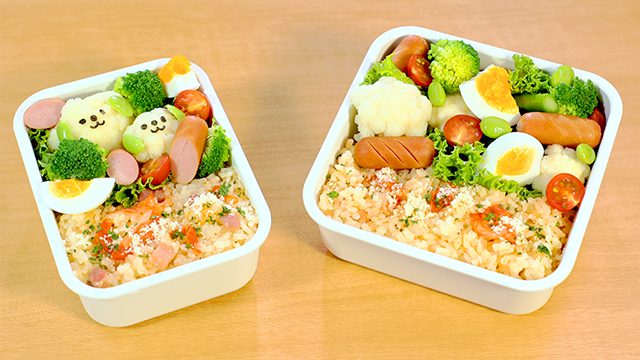
- BENTO RECIPES
- from Episode 5 / Season 6.
- Whole Tomato Pilaf Bento
- (For adults 490 kcal, For kids 261 kcal)
-
 by Maki Ogawa
by Maki Ogawa
Bento contents:
- Whole Tomato Pilaf (250 g for adults, 150 g for kids)
- Salad
Ingredients:
For Whole Tomato Pilaf
- 2 rice cups (360 ml) rice
- 375-380 ml water
- 1 tomato (approx. 150 g)
- 70 g bacon (thickly sliced)
- 1 tbsp granulated chicken stock
- 1/2 tsp salt
- 1 tbsp olive oil
- A little parsley
- Grated cheese, as needed
For Salad
- Lettuce
- Cherry tomatoes
- Wiener sausages
- Edamame
- Boiled cauliflower
- Boiled broccoli
- Boiled asparagus spears
- Hard-boiled egg
- Nori (for decorating the kid’s bento)
Directions:
For Whole Tomato Pilaf
1. Core the tomato and make a crisscross incision on both ends.
2. Add the rice, water, and olive oil to the pot.
3. Mix in the granulated chicken stock and salt.
4. Place the tomato in the center, add the sliced bacon. and cover the pot. Place over high heat until it comes to a boil. Immediately reduce the heat to low and simmer for about 15 minutes.
5. Once the rice is done, uncover and sprinkle with salt and pepper. Break up the tomato and mix into the rice.
6. Cover and steam for 5 minutes.
7. Pack into the bento boxes and sprinkle with chopped parsley and grated cheese. The rice is mildly seasoned, so use the cheese to adjust the taste.
For the cauliflower lambs
1. Cut out the eyes, mouth, and nose from the nori and place on the boiled cauliflower florets. Use edamame for the ears.
-
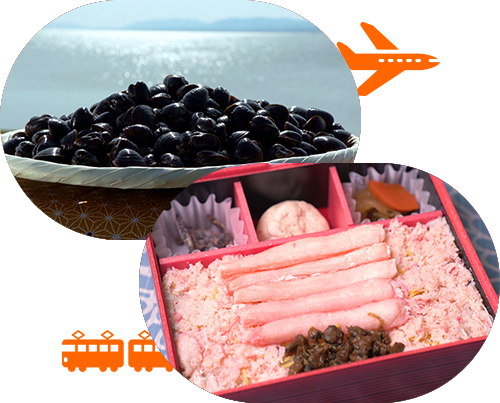
- BENTO TOPICS
- from Episode 5/ Season 6.
- Matsue
-

Today, from the city of Matsue in Shimane Prefecture, famous for the beatiful sunset over Lake Shinji.
-
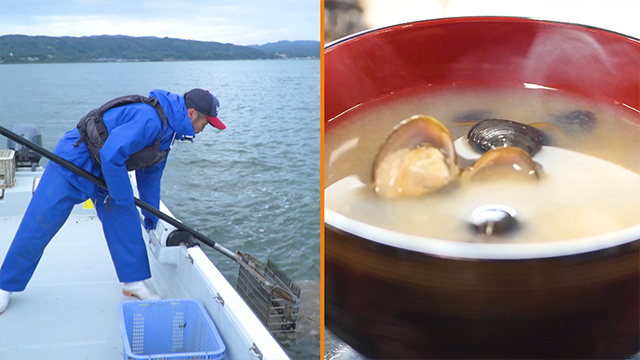
The lake is also home to Japan’s largest habitat of shijmi freshwater clams. Shijimi are only 2 cm in diameter, but they’re highly nutritious and rich in umami. Shijimi miso soup has long been a favorite in Japan.
-
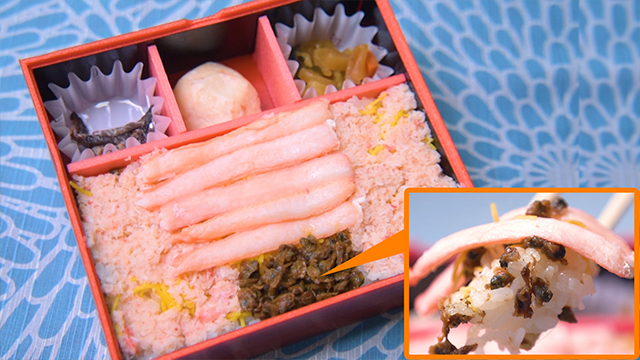
Shijimi clams bury themselves in sand, inspiring a specialty bento featuring shijimi and crabmeat. Sweet and savory shijimi are also buried underneath the rice.
-
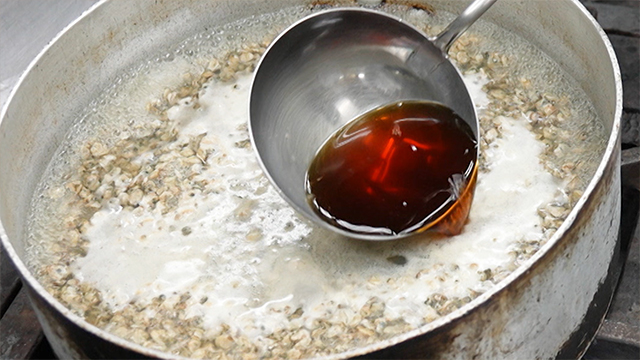
The secret ingredient is a local sake. Reddish brown in color, it’s sweet and rich in umami, enhancing the delectable flavor of the shijimi.
-
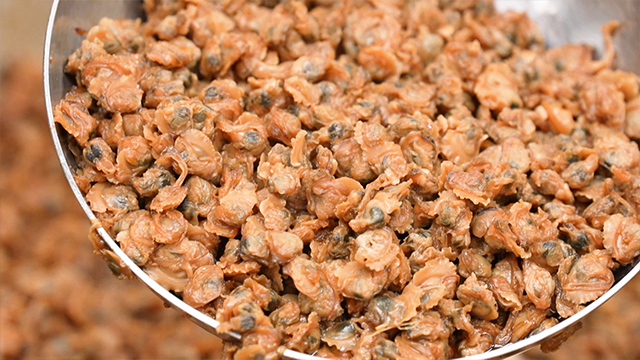
Soy sauce and sugar are added to the pot, and the shijimi are simmered until all the liquid has evaporated. Each shijimi is packed with flavor.
-
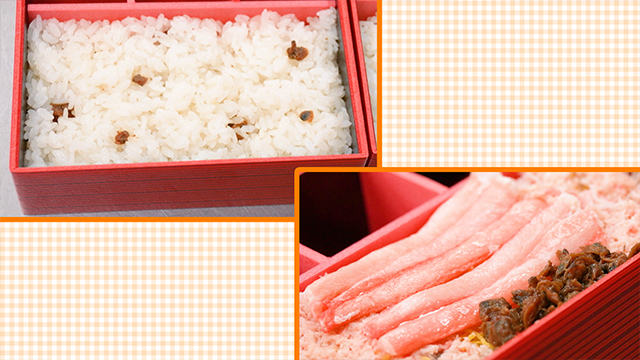
A mouth-watering combination of tangy crab meat, flavorful shijimi, and sushi rice.
-
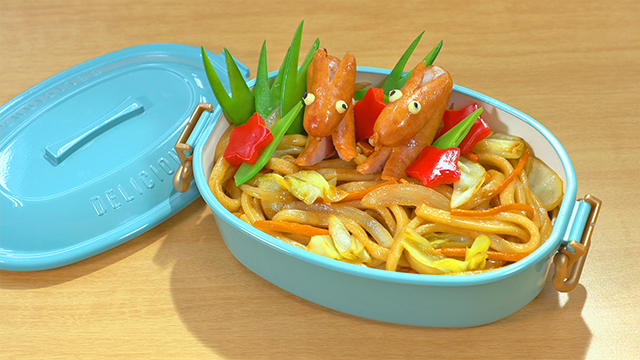
- BENTO RECIPES
- from Episode 4 / Season 6.
- Yaki-udon Bento
- (445 kcal)
-
 by Marc Matsumoto
by Marc Matsumoto
Bento contents:
Makes enough to pack into 2 bentos
Bento contents:
- Yaki-udon
- Cocktail sausage rabbits (with spaghetti and black sesame seeds)
- Green beans
- Red bell peppers cut into flowers
Ingredients:
For Yaki-udon
- 1 tbsp Worcestershire sauce
- 1 tbsp oyster sauce
- 1 tsp honey
- 1 tbsp vegetable oil
- 50 g cabbage
- 50 g onion
- 50 g carrot
- 350 g udon noodles, pre-cooked
For Sausage Rabbit
- 4 cocktail sausages
- 1 piece spaghetti
- Mayonnaise
- 8 black sesame seeds
Directions:
For Yaki-udon
1. Mix the Worcestershire sauce, oyster sauce, and honey in a bowl until the honey is fully dissolved.
2. Add the vegetable oil to a frying pan over medium-high heat, and then stir-fry the cabbage, onions, and carrots.
3. When the vegetables are cooked, add udon noodles and stir-fry until the udon is warmed through.
4. Drizzle the sauce over everything and stir-fry until the sauce has caramelized around the udon.
For Sausage Rabbit
1. Cut each sausage diagonally, so you have a large piece and a small piece of sausage.
2. Lay the larger piece of sausage on the cut edge, and then roll the sausage 90 degrees. Cut off the bottom of the sausage so it's able to sit on the cut edge.
3. Cut a slit into the center of each flap of sausage (this will be the legs and the ears).
4. Boil the sausage until the ears and legs curl, and then drain.
5. Place the large pieces of sausage with the cut edge facing down and the legs facing towards you.
6. Break the spaghetti into 3/4-inch pieces.
7. Use the spaghetti as a skewer and insert it into the large sausage pieces right above where the two "legs" meet.
8. Affix the smaller piece of sausage (head) onto the larger sausage (body) by skewering it onto the spaghetti.
9. Add a dot of mayonnaise onto either side of the head of the rabbit. Press a black sesame seed into the center of each dot of mayonnaise to make the eyes.
-
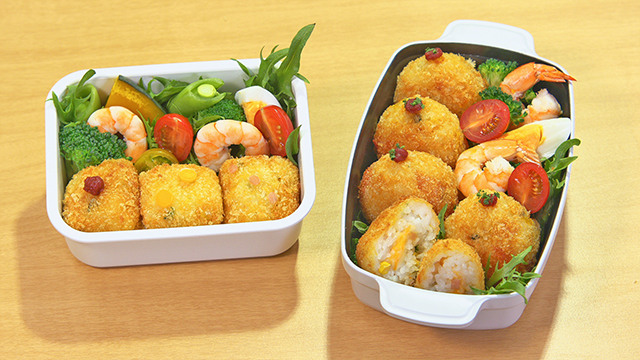
- BENTO RECIPES
- from Episode 4 / Season 6.
- Rice Korokke Bento
- (For adults 671 kcal, For kids 359 kcal)
-
 by Maki Ogawa
by Maki Ogawa
Bento contents:
- Rice Korokke
5 for adults (40 g each), 3 for kids (35 g each) - Shrimp and egg salad
- Cherry tomatoes
Ingredients:
For the Rice Korokke (yields approx. two servings)
- 270-300 g cooked rice
- A pinch each of salt and pepper
- 10 g butter
- 20 g sweet corn kernels
- A pinch of chopped parsley
- 2 slices deli ham
- Flour, as needed
- 1-2 beaten eggs, as needed
- Panko breadcrumbs, as needed
- 1/2 slice cheddar cheese
- 1/2 slice processed cheese
For the shrimp and egg salad
- 6 boiled shrimp
- Lettuce
- 1 hard-boiled egg
- Broccoli
- Boiled kabocha pumpkin
- Cherry tomatoes
- Boiled snap peas
- Boiled asparagus spears
- Boiled okra
Directions:
For Rice Korokke
1. Add salt and pepper, butter, chopped parsley, corn and diced ham to the rice and mix.
2. Cut out tiny circles from the cheese to use as decorations (circles for the dice “spots”) and divide the remainder into 8 portions.
3. Make three 35 g balls of rice for the kids’ korokke, and place one portion of cheese in the center. Form into a square shape. This is the best size for a kids’ bento.
4. Make five 40 g balls of rice for the adults’ korokke, and place one portion of cheese in the center to form into a croquette shape.
5. Bread the stuffed rice balls by coating with flour, beaten egg, and panko. Heat the oil to 160-170 degrees C and fry the korokke.
6. For the kids’ bento, decorate the square-shaped korokke with ketchup, cheese, and ham to look like dice.
7. For the adults’ bento, garnish the korokke with ketchup and chopped parsley.
For the shrimp and egg salad
1. Cut all ingredients into easy-to-eat pieces and pack into the bento boxes.
-
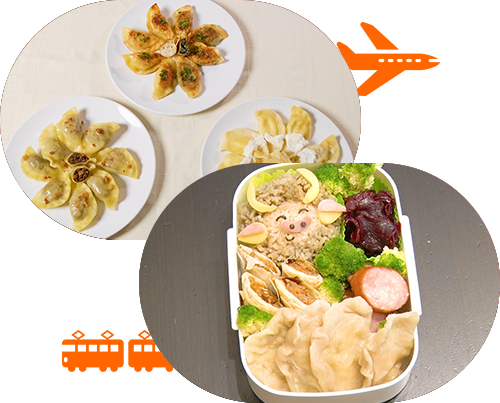
- BENTO TOPICS
- from Episode 4/ Season 6.
- Poland
-

Today, from Poland. The Historic Center of Warsaw, though destroyed in World War Two, has been restored to its past appearance. It has been designated a UNESCO World Heritage Site.
-
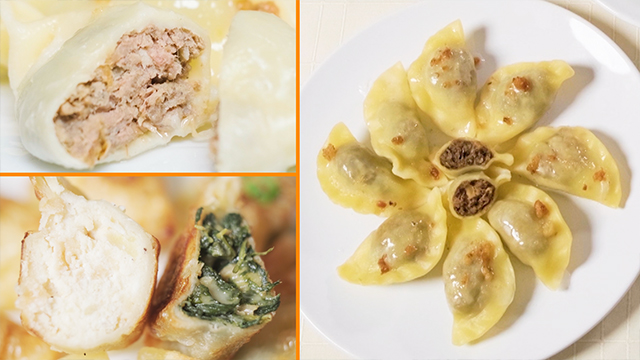
Pierogi dumplings filled with meat, vegetables, and fruit are the favorite in Poland. The southern town of Krakow hosts an annual pierogi festival. It’s a great chance to try all kinds of pierogi.
-
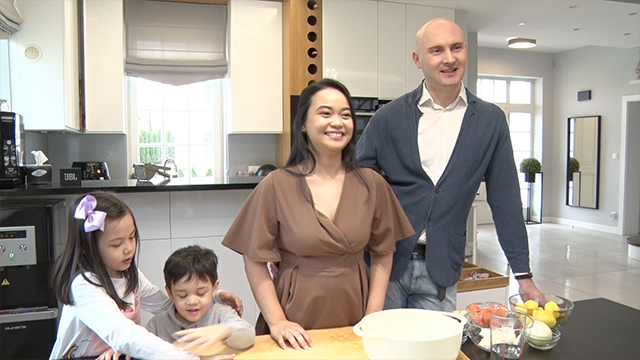
Bento maker Alia is from the Philippines. She married her Polish husband eight years ago and is now a mother of three. She’s going to make Pierogi Ruskie, a dish she learned from her mother-in-law.
-
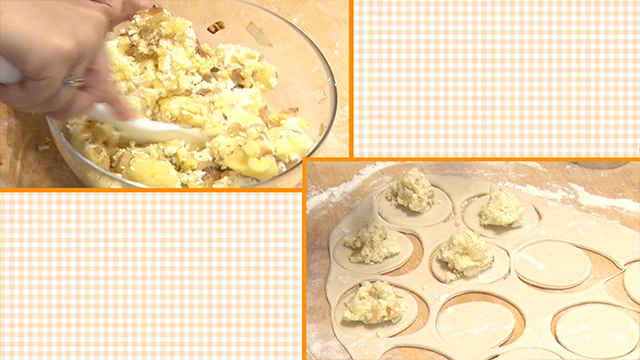
Pierogi Ruskie are filled with potatoes and Twaróg, a Polish white cheese, a combination that can’t be beat. The filling is placed on top of the dough.
-
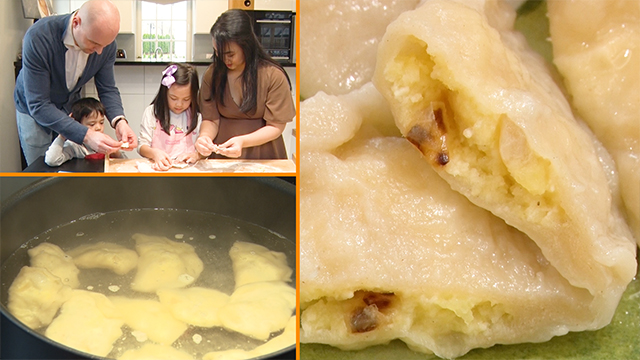
Making pierogi is a fun activity that brings the family close together. Stuff and seal the edges and the pierogi are ready to cook. A creamy filling encased in a chewy dough. Delicious!
-
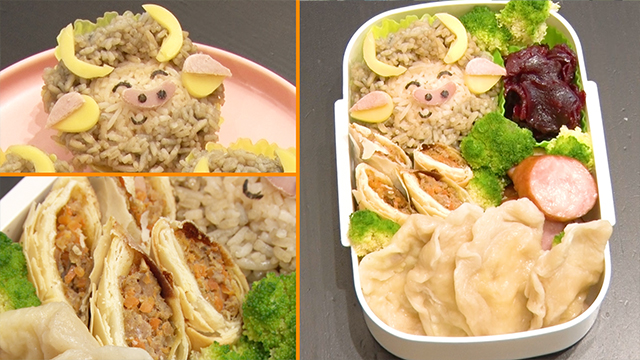
Alia makes spring rolls with a Polish sausage called Kielbasa. She then decorates a savory rice ball to look like a European bison, an animal that has been saved from extinction in Poland. Finally, she adds a beet salad to complete her bento full of Polish favorites.
-
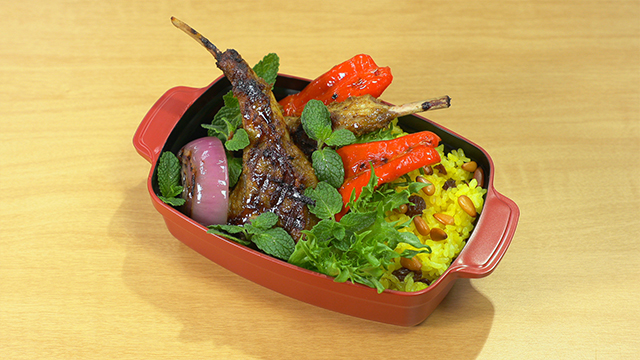
- BENTO RECIPES
- from Episode 3 / Season 6.
- Lamb Chop Bento
- (900 kcal)
-
 by Marc Matsumoto
by Marc Matsumoto
Bento contents:
Makes enough to pack into 2 bentos
Bento contents:
- Lamb Chops
- Raisin rice
- Frill lettuce
- Spearmint
- Oil roasted pine nuts (on the rice)
Ingredients:
For Lamb Chops
- 7 g ginger, grated
- 7 g garlic, grated
- 1 tbsp olive oil
- 2 tsp curry powder
- 1 tsp soy sauce
- 1/4 tsp salt
- 400 g lamb chops
- 1/2 small red onion, cut into 1/4-inch thick rings
- 1/2 small red bell pepper, seeded and cut into 4 strips
- 2 tsp olive oil
For Raisin rice
- 180 g rice
- 3 g vegetable bouillon powder
- 1/8 tsp turmeric
- 15 g raisins
Directions:
For Lamb Chops
1. Mix the ginger, garlic, olive oil, curry powder, soy sauce, and salt in a small bowl to make a paste.
2. Spread the seasoning paste onto the lamb and then let it marinate for at least one hour, or up to 12 hours.
3. Preheat a grill pan over medium heat until hot.
4. Stack the lamb chops so that the fat cap is facing the same direction, and add the lamb to the pan with the fat caps facing the pan. Grill this until most of the fat has been rendered out from the fat caps.
5. Lay the lamb chops down and grill one side until grill marks appear on that side.
6. Flip the lamb over and grill until marks appear on the other side. Check the internal temperature of the lamb with an instant-read thermometer. Lamb for packing into a bento should be cooked to an internal temperature of at least 150 degrees F (66 degrees C).
7. Toss the onion and red bell pepper in 2 teaspoons of olive oil and grill until it has marks on both sides.
For Raisin rice
1. Add the rice to a rice cooker bowl and wash it until the water runs mostly clear. Fill the rice cooker to just above the 1 cup marker.
2. Add the vegetable bouillon powder, turmeric, and raisins to the rice, and stir to combine.
3. Set the rice cooker according to the manufacturer's instructions to cook the rice.
-
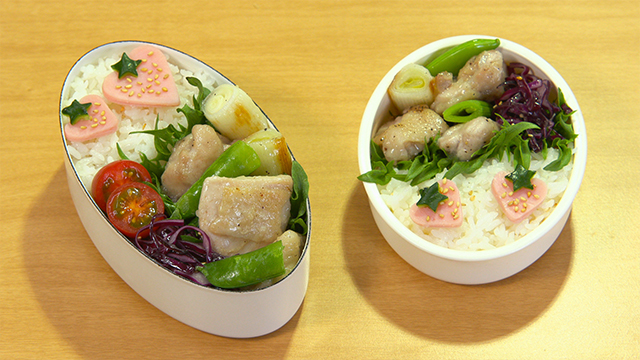
- BENTO RECIPES
- from Episode 3 / Season 6.
- Tangy Chicken Bento
- (For adults 707 kcal, For kids 307 kcal)
-
 by Maki Ogawa
by Maki Ogawa
Bento contents:
- Rice (220 g for adults, 100 g for kids)
- Tangy Chicken
- Red Cabbage Namul
- Cherry tomatoes
- Strawberry decoration made with ham and cucumber
Ingredients:
For Tangy Chicken
- 1 chicken thigh (200-220 g)
- A pinch of black pepper
- 1/2 Japanese scallion
- Snap peas, as needed
- A pinch each of salt and pepper
- A pinch of potato starch
- A dash of vegetable oil
For the sauce
- 3 tbsp grain vinegar
- 1.5 tbsp sugar
- 2 tbsp sake
- A pinch of salt
- 1/2 tsp chicken stock powder
For Red Cabbage Namul (one batch)
- 80 g red cabbage
- 1-1.5 tsp sesame oil
- A pinch of granulated chicken soup (optional)
- A pinch each of salt and pepper
- A pinch of white sesame seeds
- Salt (for rubbing)
For strawberry decorations
- 2 slices deli ham
- A little cucumber
- White sesame seeds, as needed
Directions:
For Tangy Chicken
1. Trim the excess fat from the chicken and cut into bite-size pieces. Cut the Japanese scallion into 3 cm lengths. Parboil the snap peas for 1-2 minutes.
2. Season the chicken with salt and pepper.
3. Dust the chicken with potato starch.
4. Add a dash of vegetable oil to a pan and scorch the scallions until brown. Remove from the pan.
5. Add the chicken to the pan and lightly brown both sides.
6. Return the scallions to the pan.
7. Add the sauce ingredients to the pan and bring to a boil. Reduce the heat to low and glaze the chicken and scallions.
For the Red Cabbage Namul
1. Cut the red cabbage into thin shreds and rub with salt to draw out the excess moisture, then drain.
2. Season with sesame oil, granulated chicken soup, salt, and pepper.
3. Sprinkle with white sesame seeds.
To make the strawberry decoration
1. Stack the sliced ham and use a heart-shaped cookie cutter to cut out three pieces.
2. Peel the cucumber and use a star-shaped cookie cutter to cut out three pieces.
3. Place a star on top of each heart to form the strawberries.
4. Sprinkle with white sesame seeds.
-
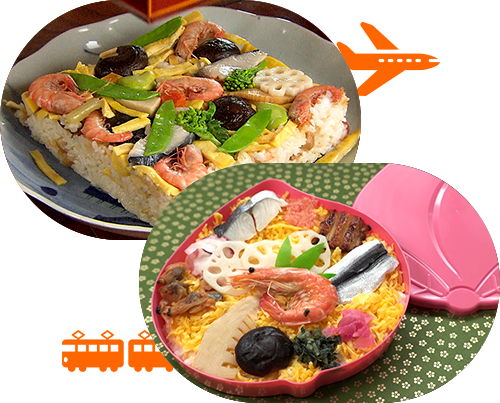
- BENTO TOPICS
- from Episode 3/ Season 6.
- Okayama
-
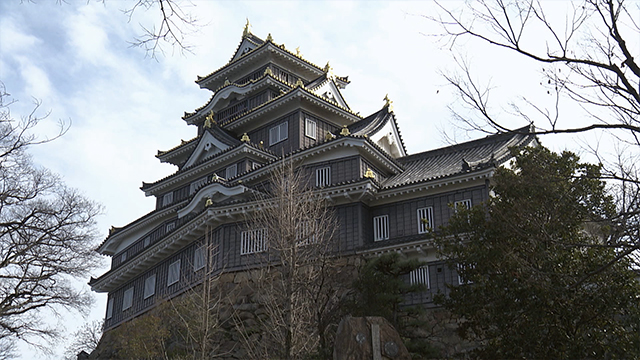
Today, from the capital city of Okayama, which once flourished as a castle town. The symbolic Okayama Castle is also known as the “crow castle” because its black exterior makes it look like a crow spreading its wings.
-

Okayama is the birthplace of Momotaro, the folktale hero who was born from a peach and grew up to defeat a band of demons. A bento that bears his name is a local favorite.
-
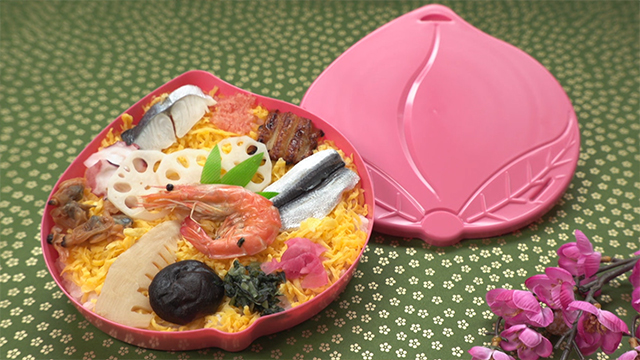
The cute container is in the shape of a peach, an homage to the Momotaro folk tale. It’s packed with bara-zushi. It consists of sushi rice topped with a colorful medley of fresh produce from both land and sea. It is often eaten on festive occasions.
-
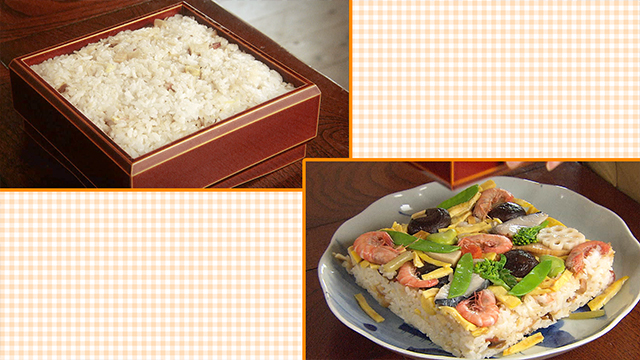
Bara-zushi was born out of defiance to a decree issued by the feudal lord of Okayama who imposed a frugal way of life on his people. To evade scrutiny, people hid their side dishes under a bed of rice, and flipped it over onto a plate when it came time to eat.
-
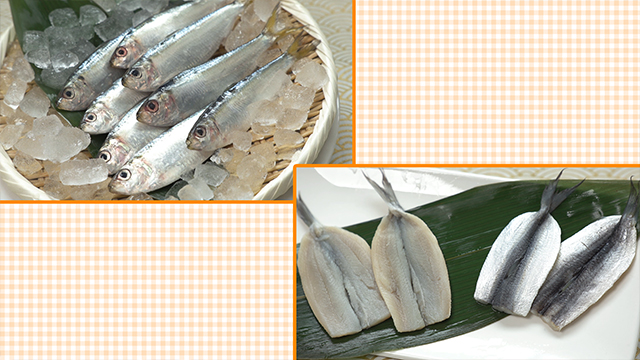
A type of herring (known locally as mamakari) is essential to bara-zushi. Mamakari are pickled in seasoned vinegar and eaten whole. The tender flesh and mild flavor make it a perfect topping for sushi rice.
-
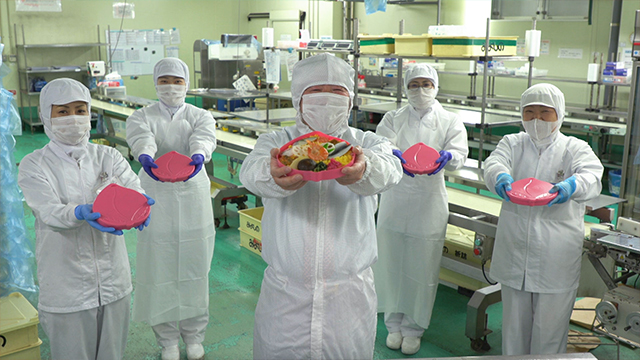
A cute Momotaro bento that nourishes heart, body, and soul.
-
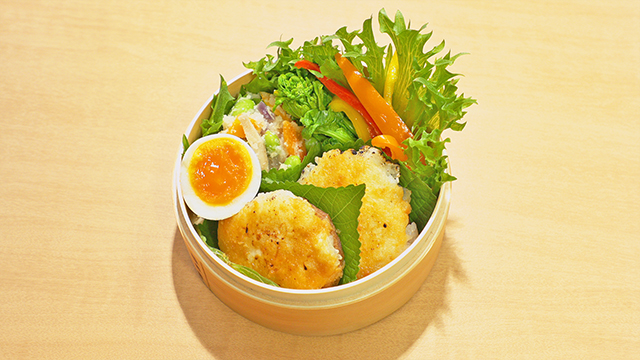
- BENTO RECIPES
- from Episode 2 / Season 6.
- Shiitake Yaki-onigiri Bento
- (606 kcal)
-
 by Marc Matsumoto
by Marc Matsumoto
Bento contents:
Makes enough to pack into 4 bentos
Bento contents:
- Shiitake Yaki-onigiri
- Unohana
- Frill lettuce
- Korean perilla (egoma)
- Boiled egg
- Nanohana, orange/red/yellow mini peppers sauteed with olive oil, browned garlic slices, and black pepper
Ingredients:
For Shiitake Yaki-onigiri
- 4-8 large fresh shiitake mushrooms
- 350 g cooked rice
- 1 tsp potato starch
- 2 tbsp vegetable oil
- 2 tbsp miso butter
- 28 g unsalted butter
- 2 tbsp miso
- 1 tsp sugar
For Unohana
- 30 g shiitake stems (sliced thinly)
- 30 g red carrots (cut into thin wedges)
- 30 g red onion (chopped)
- 240 ml dashi
- 2 tsp usukuchi soy sauce
- 1 tsp sugar
- 1/4 tsp salt
- 150 g okara
- 30 g shelled edamame
Directions:
For miso butter
1. Add the butter, miso, and sugar to a bowl and allow the ingredients come up to room temperature so the butter softens.
2. Mix the ingredients together.
For Shiitake Yaki-onigiri
1. Clean the shiitake mushrooms with a damp paper towel and remove the stems.
2. When the rice is cooked, place a sheet of plastic wrap on the counter. Put a shiitake mushroom in the center with the bottom of the cap facing up.
3. Add 1/4 of the rice into the shiitake mushroom, wrap the plastic over the rice, and press it into the mushroom, giving it a round shape. Flip the onigiri over so the mushroom is on top, and press it into the counter to flatten the rice.
4. Unwrap the onigiri, and dust the rice side with a thin layer of potato starch. Set it aside and stuff the remaining shiitakes.
5 .Heat a frying pan over medium heat and add half of the oil.
6. Add the onigiri to the pan, mushroom-side down, until they're cooked through.
7. Flip the onigiri over and add the remaining oil. Let fry until the rice is crisp.
8. Transfer the onigiri to a wire rack with the rice side up, and then spread some miso mixture onto the rice side. Use a kitchen torch to caramelize the miso (you can also do this in a broiler or toaster oven).
For Unohana
1. Add the shiitake stems, red carrots, dashi, usukuchi soy sauce, sugar, and salt to a saucepan, and bring the mixture to a boil. Turn down the heat to maintain a simmer and cook until the carrots are tender.
2. Add the okara and edamame, and stir well until there is no liquid left and the okara is hot.
-
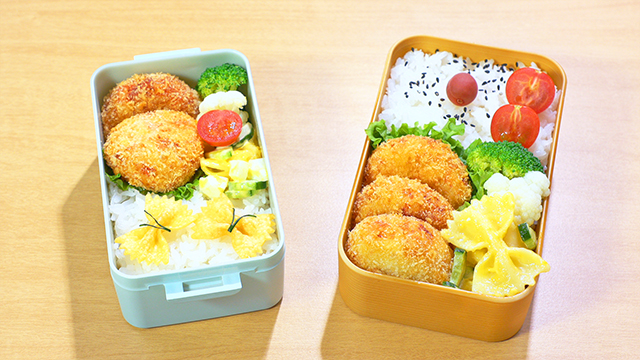
- BENTO RECIPES
- from Episode 2 / Season 6.
- Kani Cream Korokke Bento
- (For adults 1045 kcal, For kids 853 kcal)
-
 by Maki Ogawa
by Maki Ogawa
Bento contents:
- Rice (260 g for adults, 160 g for kids)
- Kani Cream Korokke
- Pasta Salad
- Deep-fried bow-shaped pasta (for decorating the kid’s bento)
- Umeboshi (for adult’s bento)
Ingredients:
For Kani Cream Korokke
- 30 g instant mashed potatoes
- 100 ml milk (slightly less than the recommended amount)
- 6 crab sticks (imitation crab)
- A pinch each of salt and pepper
- Béchamel sauce
- 10 g butter
- 10 g flour
- 100 ml milk
- 1 egg
- Flour
- Panko
- Vegetable oil for deep frying
For Pasta Salad (one batch)
- 50 g bow-shaped pasta
- 1/2 cucumber
- 1/2 hard-boiled egg
- Mayonnaise (preferably Japanese), as needed
For butterfly decoration
- 3 to 4 bow-shaped pasta
- A strip of cucumber
Directions:
For béchamel sauce
1. Microwave (500W) the butter in a heat-resistant dish for 20-30 seconds.
2. Mix in the flour.
3. Add warmed milk in increments and mix thoroughly. Microwave (500W) for 40 seconds. Stir thoroughly and microwave for 30 more seconds.
For Kani Cream Korokke
1. Warm 100 ml of milk and mix into the instant mashed potatoes.
2. Cut the crab sticks in half and shred. Mix into the mashed potatoes along with the béchamel sauce.
3. Season with salt and pepper.
4. Divide the mixture into 5-6 equal portions and shape into balls (approx. 45 g each).
5. Place on plastic wrap to cool. Dust with flour, dip in beaten egg, and bread with panko. Heat the oil to 170 degrees Celsius and fry the korokke.
For Pasta Salad
1. Boil the pasta 1-2 minutes longer than shown on the package and drain. Set aside 3 or 4 to use in decorating the kid bento.
2. Peel a strip from the cucumber for use in decorating the kid bento.
3. Cut the remaining cucumber into thin slices and rub with salt, and squeeze out the excess moisture. Mix together with the pasta, minced boiled egg, and mayonnaise. Season with salt and pepper.
To make the butterfly decoration:
1. Before frying the korroke, fry the boiled bow-shaped pasta to a golden brown. Sprinkle with salt to taste. Cut out V-shapes from the cucumber peel and place on the pasta to turn into butterflies.
-
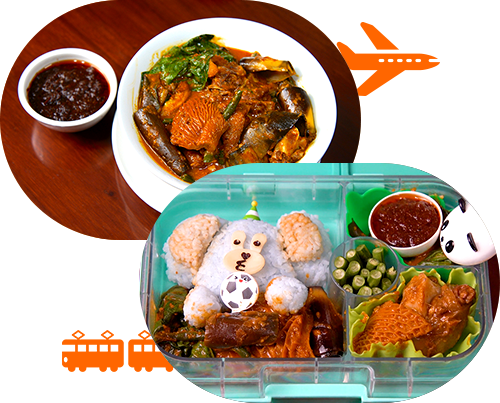
- BENTO TOPICS
- from Episode 2/ Season 6.
- The Philippines
-

Today, from Manila, the capital of the Philippines. It’s a lively city with an eclectic mixture of cultures.
-
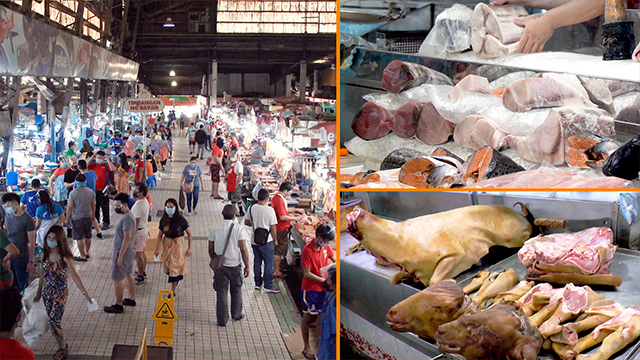
This is one of the largest of Manila’s traditional markets. The stalls are piled high with meat, seafood, and vegetables—everything needed to prepare Filipino cuisine. It even has a restaurant that provides a window to Filipino food culture.
-
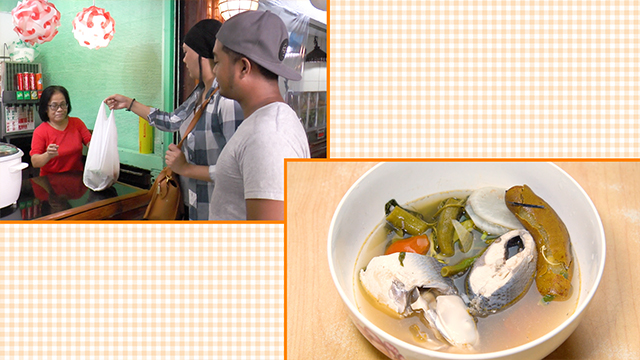
It’s called a Dampa. Customers purchase ingredients at the market and have their selections cooked to order.
-
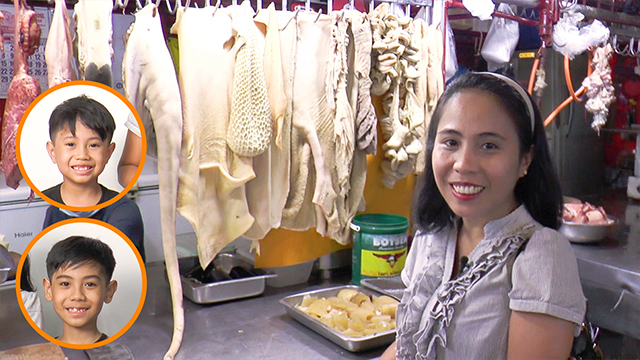
Bento maker Jen uses oxtail to make a traditional stew called Kare-Kare with the help of her two sons.
-
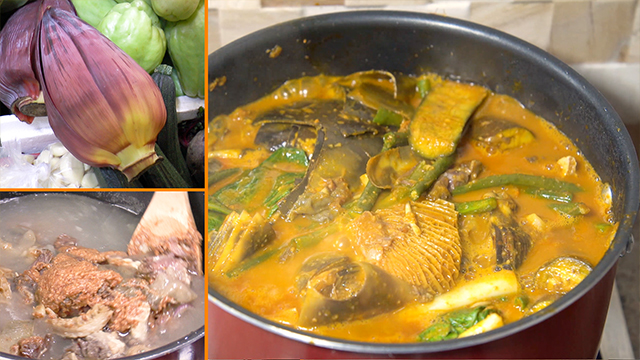
The distinctive flavor of Kare-kare comes from peanut butter. It goes well with the hearty stew of tender oxtail, vegetables, and crunchy banana blossom.
-
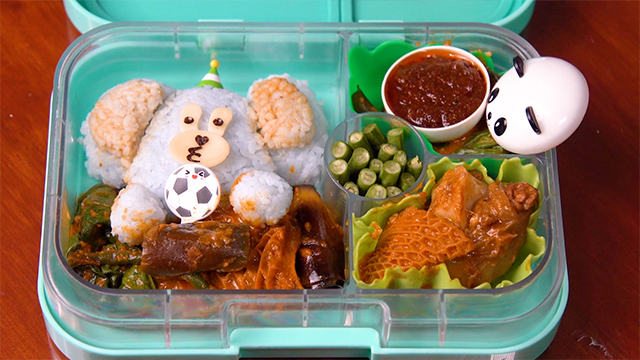
Jen makes a cute bear-shaped onigiri to finish her flavorful bento of Kare-Kare and a thick and salty shrimp paste.
-
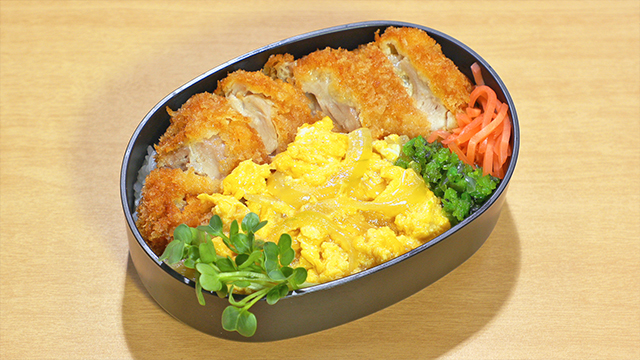
- BENTO RECIPES
- from Episode 1 / Season 6.
- Chicken Katsudon Bento
- (828 kcal)
-
 by Marc Matsumoto
by Marc Matsumoto
Bento contents:
Makes enough to pack into 2 bentos
Bento contents:
- Chicken Katsu
- Cooked rice
- Benishoga made with red shiso and ume vinegar
- Aoshisonomi (pickles)
- Kaiware
Ingredients:
- 423 g boneless chicken thigh (2 thighs, or 1 whole leg)
- Salt & white pepper (for seasoning chicken)
- Flour (for dusting)
- 50 g panko
- 3 eggs
- 1 tsp potato starch
- 70 g onions (sliced thinly)
- 240 ml dashi
- 1 tbsp usukuchi soy sauce
- 1 tbsp 3S sauce
Directions:
1. Sprinkle both sides of the chicken with salt and white pepper.
2. Prepare a tray with flour. Beat 1 egg in a second small tray. Add the panko to a third small tray.
3. Dust each piece of chicken in an even layer of flour, and then dip in the egg to coat evenly. Place the chicken in the panko, and coat evenly. Be sure to press the panko into every nook and cranny.
4. Deep fry the chicken katsu in a pot of oil set at 340 degrees F (170 degrees C). When it's cooked through, drain the chicken katsu on a paper towel-lined rack.
5. Beat the remaining 2 eggs in a bowl or measuring cup with a spout until uniform in color.
6. Dissolve the potato starch in 1 tablespoon of water.
7. Add the onions, dashi, soy sauce, and 3S sauce to a frying pan and bring the mixture to a simmer over medium-high heat. Cook the onions until they are tender.
8. Add each piece of katsu into the pan and flip over once to evenly coat the breading with the dashi mixture. Remove from the pan and repeat with the other pieces of chicken katsu.
9. Stir the starch and water and drizzle into the pan. Quickly stir the sauce until thickened.
10. Drizzle the egg into the thickened sauce from high above. This helps make the egg fluffy. Let the egg cook before stirring a few times to ensure the egg is fully cooked through.
11. Slice the chicken katsu and pack it over rice along with the egg and onion sauce.
-
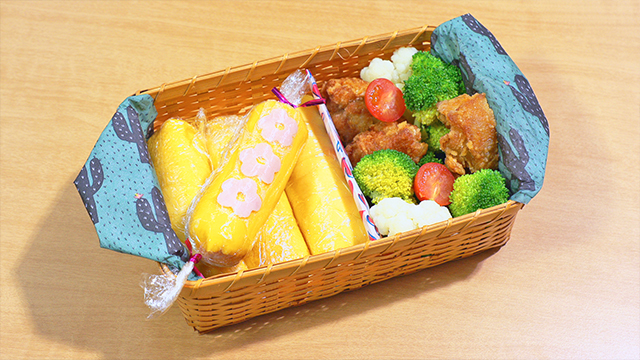
- BENTO RECIPES
- from Episode 1 / Season 6.
- Maki-maki Omurice Bento
- (935 kcal)
-
 by Maki Ogawa
by Maki Ogawa
Bento contents:
- Maki-Maki Omurice
- Chicken kara-age (6-7 kara-age, 30 g each)
- Cherry tomatoes
- Broccoli
- Cauliflower
Ingredients:
For Ketchup Rice
- 2 rice cups (360 ml) rice
- 5 tbsp ketchup
- 5 sausages made with coarsely ground meat
- 100 g onion
- 3 button mushrooms
- A pinch each of salt and pepper
For Maki-maki Omurice
- 400 g Ketchup Rice
- 4 eggs
- 1 slice deli ham (for decoration)
Directions:
For Ketchup Rice
1. Rinse the rice, soak for about 30 minutes at room temperature, and then drain.
2. Add the rice, ketchup, sausage (cut in quarter lengths and minced), minced onion, and mushrooms to the rice cooker, add water to the level slightly below that for plain white rice and cook.
For Maki-maki Omurice
1. Coat the frying pan with oil and heat over low heat for 30 seconds.
2. Add the beaten egg and spread evenly. Cover and cook at low heat for 2-3 minutes.
3. Cook through with residual heat for 2-3 minutes.
4. Repeat the process to make 4 thin, round omelets.
5. Place one of the omelets on a piece of plastic wrap and lay 100 g of ketchup rice across the center.
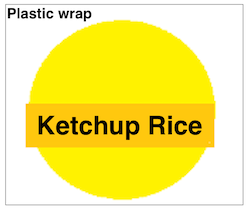
6. Use the plastic wrap like a makisu mat to roll up the rice.
7. Set the roll aside to fix the rice and omelet.
8. Rewrap with plastic wrap, twist both ends, and secure with ribbon.
9. Decorate one of the rolls by placing pieces of ham cut into floral shapes on the rice before wrapping.
-
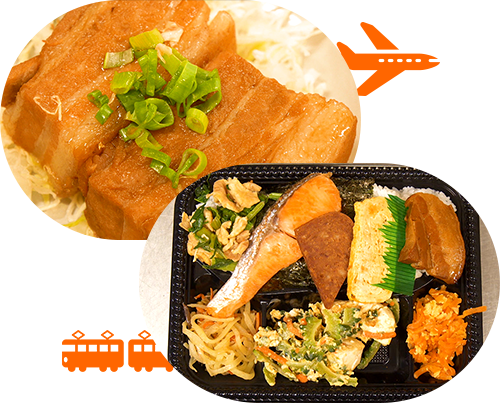
- BENTO TOPICS
- from Episode 1/ Season 6.
- Okinawa
-

Today, from the southern islands of Okinawa, one of Japan’s most popular resort destinations.
-
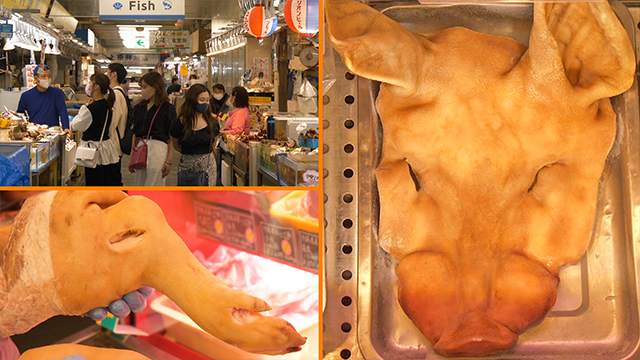
Pork is a major part of Okinawan food culture. Practically every part of the pig is eaten, including the feet and facial skin.
-
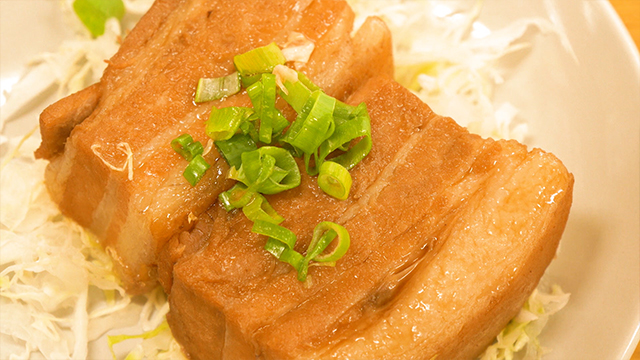
The most famous pork dish of all is Rafute—pork belly simmered in soy sauce, sugar, and a traditional distilled liquor called Awamori. The Rafute is extremely moist and tender.
-
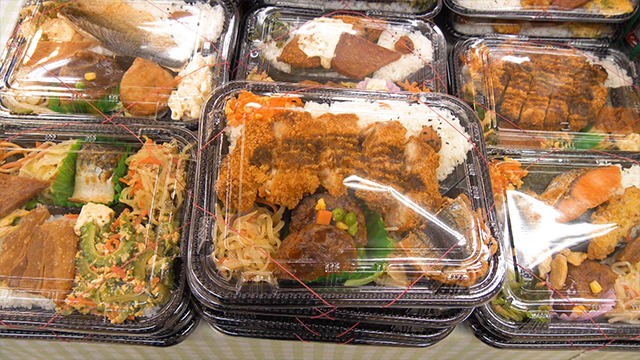
Okinawans usually have a bento for lunch. The ones on sale are typically packed with a generous serving of rice and as many as eight different foods, for just a little over four US dollars!
-
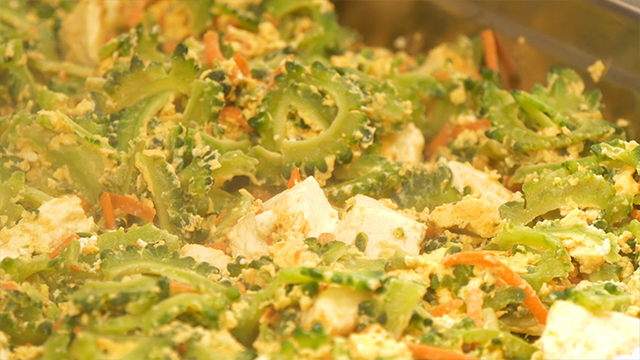
A popular bento item is Goya Champuru. Goya is a traditional Okinawan vegetable, and Champuru means “everything mixed together” in the Okinawa dialect. The dish is a stir-fried dish of crisp and bitter goya, tofu, and egg.
-
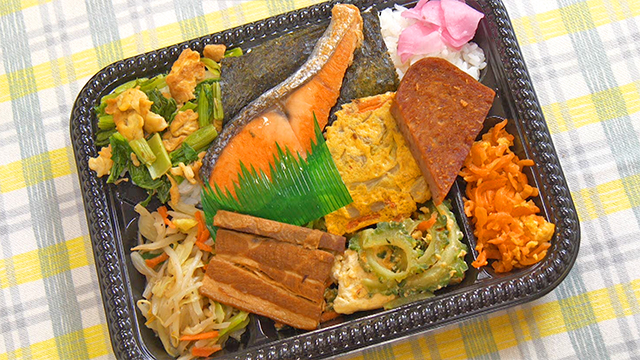
A substantial bento packed with Goya Champuru, Rafute, and other Okinawan tastes of home.



